World Tree: A Roleplaying Game of Species and Civilization by Tendales
Introduction
Original SA post World Tree: A Roleplaying Game of Species and Civilizationby Bard Bloom and Victoria Borah Bloom
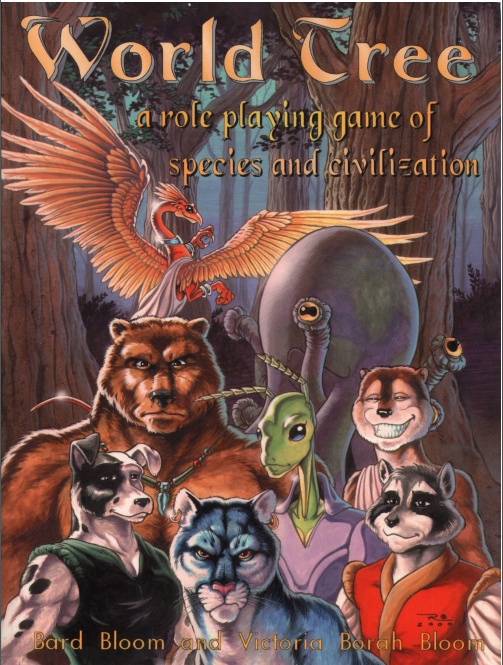
”The Back of the Book” posted:
You've lived your whole life within sight of Treverre's snakey walls. You know the look of a field of opal roses, the smell of Lake Laicrane at dawn, the sound of wherriwheffle calling to their flocks at sunout, the humming feel of a thousand spells as you walk by the magic academies. But you can't know what the world is like until you've leaned over the bow of a skyboat and felt the wind in your fur, looking at the whole World Tree spread out beneath you, green branches going forever, wiggling trails of rivers and mountains along them, the ancient cities just little patches like civilized lichen. I can sneak you on to the Crown of Leaves! We'll sail away, see the great courts and the vertical wilderness, meet wizards and heroes and bakers and professors and monsters and gods, and experience everything.
Yes, I'll just say this up front. This game is furry as fuck. Fortunately, it's much more of the Ironclaw or Albedo brand of furry than anything like Hiccuping Seven Dragons. If nothing else, it doesn't spend any significant amount of time or page space on economic theory.
The basic gimmick of the World Tree setting is that the game world is artificial. It was created by gods to obey certain laws of physics that happen to correspond neatly to rpg mechanics. The World Tree itself was explicitly created to be, among other things, a place to have adventures. If you've ever been amused with the concept of "game rules as physics”, this game takes that concept and runs with it.
Just for context, World Tree was released in 2000, about the same time as, or shortly before, the release of D&D3.0. I point that out now because in a lot of ways World Tree seems very D20 inspired, but it's a case of parallel evolution, rather than being another D20/OGL book on the pile.
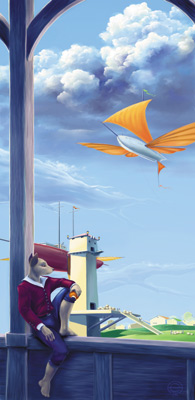
The back of the book again posted:
Welcome to the World Tree! Its upper branches are fifty miles wide and thousands of miles long; city-states dot the landscape amongst the forests and fields on their flat tops. The Verticals, the sides of the world-branches, are wild and dangerous and full of monsters, and never more than twenty-five miles away from even the most civilized areas.
In the countryside, you will find mainly Herethroy, peaceful and agrarian. But move into the cities, and you will find others: the loyal and social Cani, the clever and obsessive Rassimel, the merry and mercurial shapeshifting Orren. Look into the woods to find a village of proud and heroic Gormoror, or a solitary Sleeth on the hunt. Sneak into the dark corners of society to find an occasional Khtsoyis, thuggish and brutal. Rarely, you may see a Zi Ri, immortal and mysterious.
These eight prime species, to whom the gods have given access to all of them magical Arts, have built good lives for themselves, mostly peaceful and prosperous. But for those who hear the call to adventure, by design or by accident, the Tree can be a perilous place still…
Filled with stories and advice from the inhabitants, this book gives you the detailed information about the World Tree and its prime cultures you'll need to play your own stories of intrigue and magic on the civilized frontier, together with a completely integrated rules system.
There's a LOT to cover in this book. It's about 300 pages, and very text heavy, so I'm probably a fucking idiot for even hoping to get through this without burning out.
Prelude:Into the Verticals
Original SA post World Tree: A Roleplaying Game of Species and Civilization
The book starts out with a very basic title page, credits page, and table of contents. One interesting touch is that the contributing artists section also lists every page where their art appears. Many of the artists are familiar names from the furry scene of the turn of the millenium.
The TOC tells us that we're in for a fairly standard organization. The first third of the book is devoted to establishing the world, then comes character creation, followed by the rules of play, and the last third of the book is dedicated to all the lists and tables that an RPG of this era requires.
First off:
Prelude:Into the Verticals
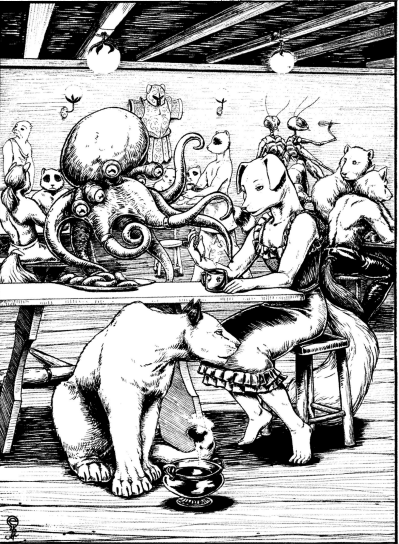
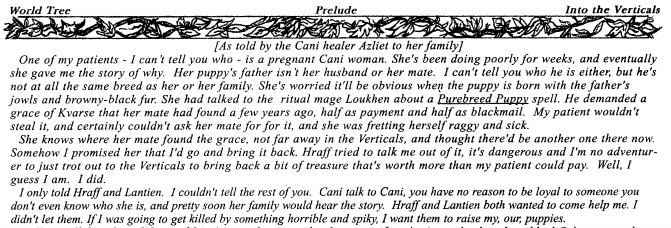
A short piece of fiction establishes the character of Azliet and how she got started on a life of adventure. Azliet is in fact the sample character; we'll be seeing her again as an example of character creation. I'm pretty sure this story is a dramatization of an actual adventure run during the game's development/playtesting. Azliet is a Cani, the dog species, and before she started adventuring she works as a healer. The story is framed as Azliet explaining to her family what sort of trouble she got into after she comes home. It turns out that one of her patients, also a Cani, got herself knocked up by someone other than her spouse. The patient tried going to a ritual mage to have a Purebreed Puppy spell cast, (spells in this setting seem to have very on-the-nose names), but the mage basically extorted her. Azliet, being a good girl and too helpful for her own good, volunteers to help by trudging off into the wilderness to find a substitute for the rare magical ingredient the mage demanded. She decides not to ask her family for help, because Cani tend to be gossips and this is supposed to be a big secret, so instead she goes to the local
At the bar, there's three potential adventurers. The Rassimel (raccoon) knight-wizard is a huge dick and says he's not going to waste his time helping an adulteress avoid consequences for her actions. Maybe next time don't open with your patient's whole case history, Azliet. The other two adventurers are Rrenga; a Sleeth (panther) freelance mage, and Herobash; a Khtsoyis (Flying cephalopod thing???) brute and blunt object enthusiast. They also think that that knight-wizard is an asshole, so they agree to help out of spite. A bit of haggling ensues: Azliet doesn't have a lot of money, but healing magic is always valuable and she agrees to bind some useful spells to her new companions. The story ends with Azliet, her old college roommate that decided to come along too, and the two newcomers hiking to the edge of the branch they live on, and starting their descent into the Verticals, the wilderness of weird twisted plant life that grows on the side of the giant branch.
The tone of this story suggests that the focus of World Tree is on fairly personal adventures. While it's certainly possible to run a game about huge world-threatening events and epic conflicts, I think the Blooms were more interested in smaller scale events. We’re given a quick glimpse into what daily life is like in the setting; the different species tend to all live together if not without prejudices. Magic is commonplace, binding (whatever that means) a useful spell 14 times is considered a two days of skilled work but is otherwise unremarkable. Cani have very complex
Also, Herobash named his clubs “Hero-club” and “Bash-club” and that’s kind of cute.
Part 1:The World Tree
Original SA postEvil Mastermind posted:
I'd just like to point out that my local library has a copy of this for some reason.
Great, you can read along, then!

World Tree: A Roleplaying Game of Species and Civilization

Part 1:The World Tree
The meat of the book starts off with an explanation of the setting. This is an understandable starting point; the World Tree is not an Earth analogue! Trying to summarize this might get confusing, there’s a lot of worldbuilding going on here, so if there’s anything that it seems like I’m glossing over, I’ll probably come back to it later.
The titular World Tree is huge, so large that in the thousands of years that people have lived on it, they’ve barely explored a tiny fraction of the surface level and almost none of its depths. It is literally a tree, the kind that branches out into multiple trunks. The main trunks are about 200 miles across, and no one has any idea how tall they are. No one has ever seen the ground. In fact, whether or not there even is such a thing as the ground, or if the roots are just sort of free floating, or if the tree just goes down infinitely is an open academic and religious debate.
People, and basically all “normal” living things, live on the tops of the tree’s branches. The tops of the branches are flat bark, covered in rich humus and teeming with smaller plant life. You probably could follow the branches out and walk around on the World Tree’s leaves, but there’s not much interesting out there.
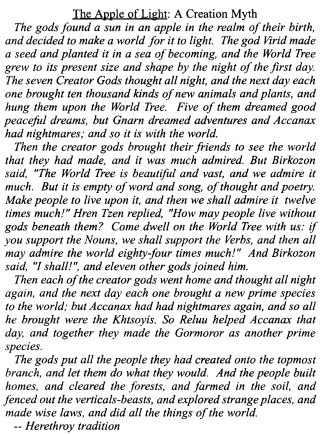
Seven creator gods made everything in the World Tree universe. The entire project was Virid’s idea; she made the Tree itself and all the plant life. Mircannis and Reluu made the domestic animals and the normal varieties of wildlife. Hren Tzen and Paranenzu made a bunch of weird creatures that had to get shoved off to the obscure corners of the world. Gnarn made a bunch of cool monsters, and Accanax got bored and slacked off until the last moment, at which point he slapped together a bunch of shitty monstrosities and just tossed them around wherever. Then the gods made the people, eight species of people that are collectively called the prime species. Everything about the World Tree is created with the primes in mind. This much everyone agrees on, because the gods literally showed up and said so. On the other hand, the gods never actually said what the actual purpose of all this is, and there’s as many different theories about the subject as there are theologians.
Arbology
Because geology isn’t a thing when you don’t have a ground. The Tree itself gets described in a little more detail: hundreds of trunks, each tens of thousands of miles apart, have been identified, although most haven’t been visited yet. No one’s ever found any sign when or if the trunks stop. One trunk is designated the “main” trunk. It’s the tallest, presumably at the center, and it’s where the primes were placed after creation. The ring of nine uppermost branches of the main trunk are collectively known as Ketheria, and they form the center of prime civilization.
Branches generally extend from the trunks in rings of five to twelve main branches, and each of those branches could have sub-branches extending off of it. A main branch is about 50 miles wide, and tens of thousands of miles long. For comparison, the continental United States are somewhat less than 3000 miles across. Walking down a main branch is a LONG trip.
Most branches are fairly level, possibly angled slightly up as they move away from the trunk, with a few gentle turns back and forth along the way. Some branches are all messed up and poke out at weird angles, but people live there anyway. Usually the tops are flat in the middle, with streams and rivers that flow toward the trunk. The terrain gets bumpier toward the edges, until you got some rough hills dividing the flats from the Verticals.
The Verticals are the sides of the trunks and branches, and they make up the untamed and untamable wilderness. Sometimes the edges are bumpy enough that there’s enough flat land to live on; this makes for bandit territory. Sometimes the Verticals are just cliff faces. Either way, it’s not a safe place to be ever, and people only live there out of necessity, not choice.
Underneath the branches is uncharted territory. There’s no particular name for these places, because people almost never go here. On the other hand, life, uh, finds a way, and this where many of the really weird plants and creatures ended up. Especially ones that can fly.

Prime Territories
In the thousands of years since primes were first placed on the World Tree, they’ve spread out fully colonize about two dozen branches, and another 30 or 40 are partially colonized. For the most part, primes stick to the highest branches if possible; they’ve expanded down maybe four or five layers. Most of civilization is around the main trunk, but a few colonies have hopped over to the branches of two other trunks.
The region called Ketheria is the most completely civilized area, at least by primes. They’ve lived there long enough that the branches have been connected by platforms ringing the entire trunk, basically making a big artificial “land” mass. Ketheria is a geographical (arbographical?) region, not a political one. It’s made up of a bunch of city-states and principalities in a web of political alliances.
Further down the trunk, the tree gets darker and cooler as more and more branches block out the light from the sun. After 5 layers or so, it gets cool enough that primes aren’t eager to live there. 20 or 30 layers down, it gets dark enough that normal plants have trouble growing. As you go further down, the sky gets darker, the air gets colder, the terrain gets rougher, and the monsters get scarier. Past 30 layers, things start getting really weird and all the rules get thrown out.
Part 1:The World Tree cont’d
Original SA postBieeanshee posted:
I gotta say, I like the structure of the World Tree. It's intriguing.
The author loves making this kind of 'a single feature expanded out into an entire world' kind of settings. Way back when WotC was doing its 'Invent the next D&D setting!' contest, the one that Eberron ended up winning, his entry was a world that's a single infinitely tall waterfall. I can see why it didn't get picked for a D&D setting but I still really like the imagery.
World Tree: A Roleplaying Game of Species and Civilization

Part 1:The World Tree cont’d
Astronomy
The sky is a clear dome over the World Tree. Blue during the day, dark blue-green at night. The sun is a crystal globe that follows a horizontal circle around the horizon, about 18° up from the horizontal plane. Since the sun doesn’t actually orbit the World Tree, the day/night cycle isn’t determined by the sun dropping below the horizon. Instead, the sun actually turns on and off over the course of the day. At dawn, the sun ignites, filling with flame from bottom to top over the course of the morning. At noon, exactly one third of the day after dawn, the sun is completely full of fire. Sometimes it overflows and flames drip down. Then from noon to dusk, the fire slowly fades, drains, or dies out, until the exact moment of sunout, two thirds of the way through the day. The last third of the day is night. The sun is still in the sky, a barely visible empty globe occasionally lit by the many other celestial objects.
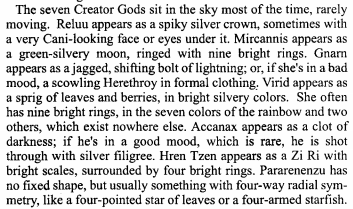
Yeah, you can just look up and wave at the divine entities that created you. They might even wave back.
There’s two moons. The bigger one is the Hollow Moon, a donut shaped rock that tumbles around the far edge of the sky and tries to dodge all the other stuff out there. Sometimes bad things happen when its rotations end up pointing the hole at the world. The closer one is the Silver Moon. It’s close enough that people have flown there, and the god of time has a house there.
The stars are all the way at the back of the sky, behind all the other celestial objects. Some twinkle, some don’t, some move around, some don’t, and that’s about all anyone knows about them.
There’s also some less familiar celestial objects:
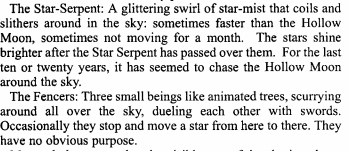
I kind of like the idea that there's three swordfighting trees just fucking around in the sky all the time, and there's no reason for it, they're purely decorative.
Directions
North and south wouldn’t make a lot of sense on a giant tree. Directions are generally given radially in terms of the tree trunk: Trunkward and Outward for toward and away from the trunk, rollward and roll’gainst for moving around the trunk in the same direction as the sun or the opposite.
If you’re not on a main branch, you probably use walkward or walk’gainst to describe walking toward or away from the main branch, because that’s more locally useful. If you’re a scientist or a navigator, you might give directions in terms of celestial objects. Reluu never moves around, so he’s often pointed to as the equivalent of “north”.
Up and down are universal. Trying to explain gravity on a globe to a World Tree native would probably earn you very dubious looks.
Common Materials
The short version is that almost everything is some form of plant or animal material. Even stuff that would obviously be a mineral on earth, like clay or jewels, often has a plant-based equivalent on the World Tree. Cookware is usually leather treated with fireproofing magic. Cheap blades are made out of the tough flesh of meng nuts. There’s even plant material that’s the equivalent of modern plastics.
Actual minerals exist, but are extremely rare and precious. Glass, ceramics, metal, and stone either have to be found by exploration, or created by magic. Iron is the most precious of minerals, since it has a particular useful magical property.
Magic
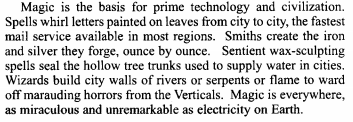
Magic is everywhere. It comes in many varieties. Spontaneous magic is the most common. Every prime and most living things can spontaneously cast simple spells as naturally as walking or talking. Pattern magic is considered “grown up” magic because it’s much more consistent and reliable. A normal prime will learn a dozen or more pattern spells related to their profession and daily life. Bound magic is a new invention, which lets people purchase pre-packaged spells set to go off under specific conditions. This lets powerful specialized mages provide spells to anyone who can pay, and the social ramifications are still rippling through prime civilization.
Time and Seasons
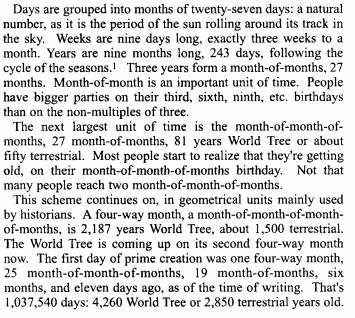
This just breaks down how clocks and calendars work. Not terribly important, except that one World Tree year is 2/3 of an Earth year.
There’s nine months in a year. The seasons more or less break down into Spring-Summer-Autumn-Winter. Climate is basically determined by divine fiat, since there’s nothing like Earth’s orbit and planetary tilt and weather fronts and stuff. Also, crammed into the middle of autumn is an extra month-long season called Surprise where the weather is completely monkey-cheese random. It might be frozen one year, scorching hot the next year, and it might rain apples the third year.
Languages
The World Tree has a lot of different languages, none of which would compare neatly to any Earth language in terms of grammar or sound. Animal people just don't have the same shaped mouths as humans, after all. There’s a very rudimentary universal language; maybe about 2,000 words and no complex grammar. Even non sentient animals will often understand the basic gist if you yell at them in common.
Beyond common, there’s dozens of families of language, and dozens of languages in each family, related to each other (or not) in more or less the same way Earth languages are. That is, region has much more to do with language than species. Sleeth have a silent hunting language of gestures. Khtsoyis also have a silent gesture language, but it’s mostly obscenities. The gods have their own completely unrelated language; a few primes have learned the basics of it.
Pronouns
Actual World Tree pronouns are usually species based, not gender based. Because not every species has a male/female binary, the text also uses “Zie/Zir” as an extra pronoun, but this doesn’t have any diegetic significance.
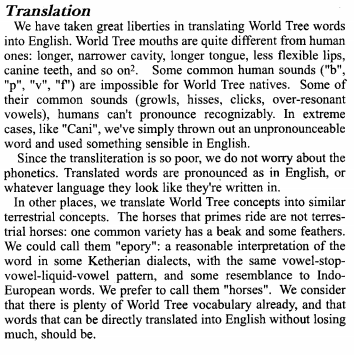
Tl;dr: This game secretly has chocobos.
Part 2:The People
Original SA postkommy5 posted:
World Tree has been very interesting to me. But I am curious to see what they actually do with this concept. Original world building by itself only goes so far, after all. I'm curious what kinds of adventure seeds are supplied and what kind of PCs they envision for this imaginative setting. And how much they play around with this concept of 'the rules mechanics are the physical laws'.
Before I forget to point this out, one major notable thing that's missing from World Tree entirely is any kind of metaplot. There's lots of examples presented, but there's absolutely no "This is our story, the players are just watching it."
Even though there's a lot of setting detail, I think this book really did "Draw maps, leave blanks" long before PBTA codified the principle. Things like "Weird stuff happens when the hollow moon points at the world, and you could probably fly there if you're really resourceful" leaves lot of room for player and GM creativity, I think.
World Tree: A Roleplaying Game of Species and Civilization

Part 2:The People
OK, so the world is neat and all, but you can't have a story without people. This chapter is split into two parts: a detailed description of each of the eight prime species, and then a quicker overview of the non-prime people of the World Tree.
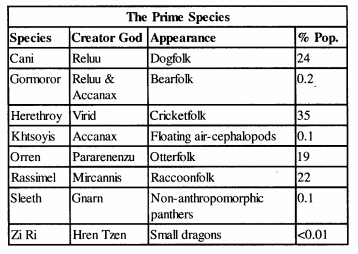
As mentioned, there are eight prime species; one created by each of the gods, and then an extra one created because one of the gods fucked up and wanted a do-over. The prime species all share civilization, rather than entire kingdoms being a single species.
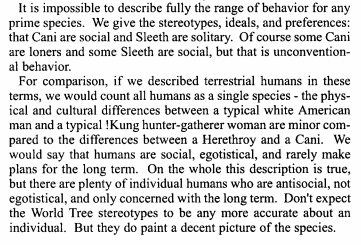
It's kind of interesting to see this Y2K take on RPG species, especially considering how the discourse on portraying race has progressed since then. In any case, every prime species is very distinct. There's not even two races as similar as dwarves and orcs, really. One thing I appreciate: There is no "default" race that all the others are compared to. That is, there's no human equivalent. No baseline species that only has some handwavey "I dunno, they're adaptable?" to make them stand out.
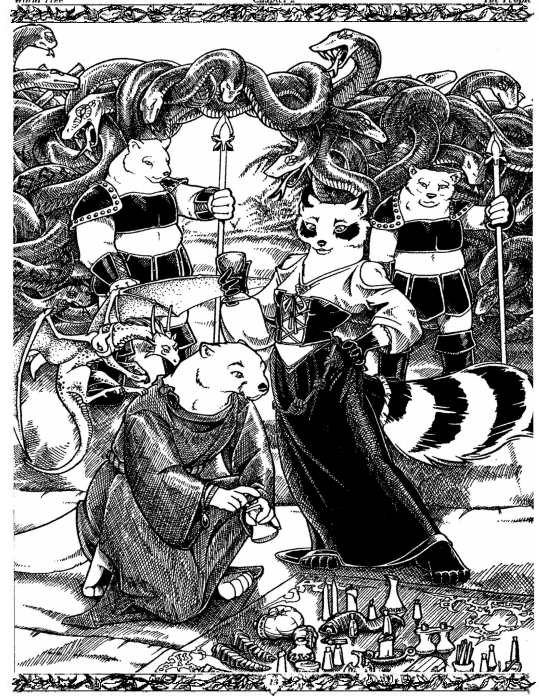
This picture isn't really related to anything right now, there aren't even any Cani in it, but I still like it. It gives a neat little slice of life view. That wall of snakes isn't metaphorical or anything, by the way. That's a perfectly normal way to protect a city.
Anyway, the prime species. Each species gets about half a page of story, generally a representative of the species describing themself, and then a description of appearance, social structure, naming styles, art, diet, moral attitudes, variation, and how they tend to view the other species. All of the stats and mechanical effects are saved for another chapter, so we'll have to revisit everyone later.
Cani
The dog folk
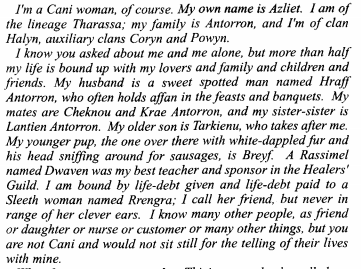
Hey, it's Azliet again! She goes on to explain how she was a wild puppy and always got into trouble no matter how much she wanted to be normal. She married into a family of eleven(!!) spouses and had some puppies, which are extremely normal Cani things to do. Then she started getting caught up in trouble again, partly because of her also-wild brother, and then later because of wanting to help a patient in the opening story. The story talks about a concept called affan, which seems to be some kind of authority that is apparently very important to Cani and not to anyone else. Also, it confirms that she did return successfully from that adventure and helped her patient out, happy end.
The first thing the actual description makes clear is that Cani are a) extremely social and b) extremely loyal. If there's a powerful political family somewhere, they're probably Cani just because Cani care the most about having big powerful families and about forming up into packs, families, and nations.
Loyalty is instinctive and unavoidable. A Cani that's part of a group, for any reason, for more than a couple weeks will develop loyalty to it. This doesn't replace any existing loyalties, and a grown Cani will find they often have to balance many conflicting loyalties, but it's there and it's real. A disloyal Cani is almost unthinkable, the stuff of horror stories. They're well suited for adventuring life; they work well in teams, their hide is tough enough to count as a light armor, and their teeth and claws, while not ideal weapons, mean they're never completely disarmed. Unsurprisingly, they also have the keenest sense of smell of all the primes; they can distinguish two brothers by scent, even when following a days-old trail.
The differences between male and female Cani aren't readily visible to most other species. (Aside: A lot of the artwork gives female Cani decidedly curvy bodies. Chalk that up to artists being artists.) Cani can effortlessly tell the difference by scent. So can Sleeth, but Sleeth don't give a shit. Cani love fashion, and will dress up quite extravagantly given the opportunity, with the exception that their tails are always left uncovered and unhindered; it's just too important for scents and social cues.
Azliet's big family is completely typical for Cani; most live in a longhouse with a dozen or so adults in a single group marriage (although it's actually structured more like a fever dream of poly tumblr; each spouse will have a specific and distinct relationship to every other spouse. Husband/wife, mate, co-mate, brother-brother, etc.) along with all the children, and probably a selection of parent, grandparents, aunts, uncles, etc. Cani don't need or even want privacy, so living space is communal, divided up by purpose (kitchen, gathering area, playroom, workshop) rather than "Azliet's room."
Usually when a Cani family wants children, all the women in the family will schedule their pregnancies around the same time, so even though single birth is normal, there's still a "litter" of puppies all the same age to grow up together.
Outside the longhouse, Cani find other ways to organize. There's nine clans, descended from the originally created families. Clan membership is hereditary through the mother's line, but each Cani is also fully aware of all their secondary clan associations. While there's some political power to the clans, their function is mostly to enforce exogamy; two Cani of the same clan mustn't bear a child (although sometimes the male will officially change clans to one of his auxiliary clans to get around this.)
Between families and clans, Cani group up according to extended families, guilds, nations, clubs, and sports teams. Two Cani meeting for the first time will spend the effort to find some connection in common. Sharing a clan is easy, or being in the same trade guild, but if those don't work they'll most on to common friends, having gone to the same school, or even just having relatives that happen to have the same name. If all else fails, they'll just invent a made-up social connection that lasts long enough for their loyalty instinct to kick in, at which point they'll laugh off the "misunderstanding" since now they're friends and that's enough of a connection.
Cani have two concepts that have no direct human equivalent; affan and choofing. Affan is basically dominance in some social setting. A queen would have affan in government, a head chef has affan in cooking, one adult in the longhouse will have affan in organizing chores. In any social situation where someone can take charge, affan comes into play. Cani love this. Obeying the person with affan is natural and instinctive, not a cause for resentment.
Affan is determined by a process called choofing. This is also an instinctive urge; even if the head-chef has been doing the job for years, from time to time all the cooks will feel a neat to test their position in the chain of command. A choof takes the form of some kind of contest related to the affan being held. There's even a big book of etiquette describing how the rules should be determined. In general, the more powerful the position, the more rarely a choof is held. Clan leaders choof every five years, leaders of nations every three. Juvenile Cani will choof several times a week to sort out where they fit in their groups of friends.
Along with these concepts are emotions that are also alien to humans. Deffa is the emotion the loser feels; an acceptance of the loss, recognition of the winner's position, and loyalty to the affan-holder. Salaffan is the converse; the winner feels a loyalty to and a drive to protect the loser, rather than humiliate or injure them. These emotions fade after a couple days, but in the moment they are very strong, and both the winner and the losers will feel satisfied and even happy about how things turned out.
While individual Cani aren't particular powerful by World Tree standards, they're probably the dominant race just by virtue of organization. A Cani might not win a one on one fight, but they have friends, family, and clan backing them up if need be.
Artistically, Cani tend towards stories about conflicting loyalties, with complicated resolutions that bore other species to death. Their visual art isn't special one way or another, but they are fond of making scent-sculptures that only Cani and Sleeth can perceive as the artist intended.
Cani are omnivorous, but prefer meat-heavy diets for energy. They like to eat several times a day, often in big communal dining sessions. Visitors to Cani kitchens need to be careful; Cani have no concept of "tastes bad" or even "smells bad." Your friend that likes to eat durian in public has nothing on these people. That isn't to say they'll eat rot or poison, but it does mean that they're perfectly happy wearing a cologne of eau de carrion.
Loyalty is at the core of Cani moral norms. This can be to their disadvantage; if someone kidnaps a Cani and sits with them long enough, the Cani will form a loyalty to their kidnapper. Also, their tendency to think in terms of the pack can lead to heinous behavior; if one member of a group considers a crime or misbehavior, the idea can spread, blame gets divided, they goad each other on, and the ugliest aspects of pack behavior can manifest.
While Cani are generally described as being doglike, there's a lot of diversity in breeds, including forms more like foxes, wolves, or jackals. Being of a distinguished breed, such as one associated with a powerful family, is a point of pride, but not generally the most important factor in social position.
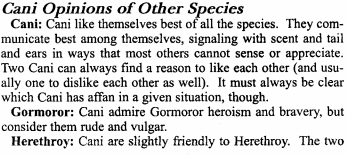
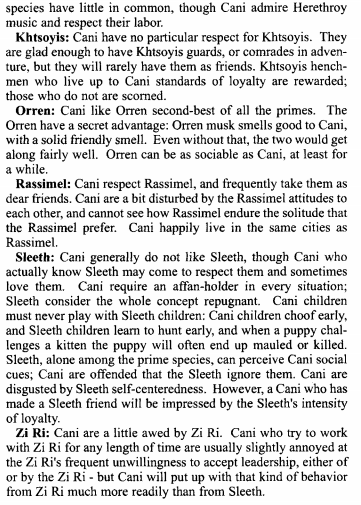
Part 2:The People cont'd
Original SA post World Tree: A Roleplaying Game of Species and Civilization
Part 2:The People cont'd
Gormoror
The bear folk
The introductory story for the Gormoror is a warrior describing how his uncle died honorably in battle. The old man had an infected wound that was going to kill him, but he didn't want to die in bed. So his nephews hired some adventurers to take them out in the wilderness and pick a fight with the biggest, meanest monster in area; something called an ogre-worm.
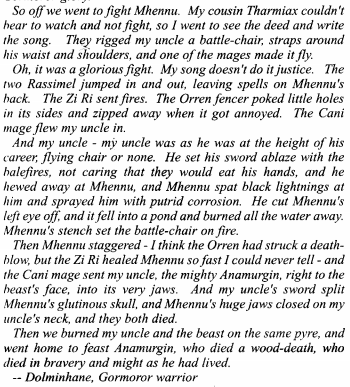
So, if it's not obvious, the Gormoror are the Noble Savage type. While the text isn't really so specific, the artists tend to go for stereotypical indigenous American styles. They fill the same niche as Klingons, or Earthdawn trolls. The word "barbarian" gets use a lot. There's a few interesting ideas to make them stand out, but to be honest I think the broad-strokes pitch for Gormoror is kind of lacking.
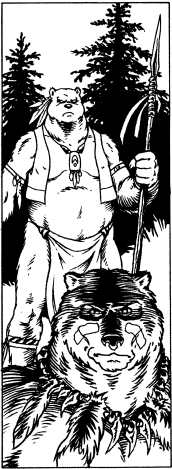
Physically, male Gormoror are bigger and more ursine; they have a bearlike muzzle and large claws, where the females are smaller and more humanoid, lacking the fangs and claws. On the other hand, there's very little difference in personality or social status between the genders.
They're happier living at the margins of society, sometimes even as far as the Verticals; the stereotypical Gormoror only bothers going to civilization to trade or to raid. They tend to organize in rough tribes, led by a chief who holds their position by heroism or by raw strength, until someone else comes along to take it from them.
Daily life is rough, bordering on brutal, but not out of cruelty. They just love fighting. Male Gormoror will get into vicious fights over anything, biting and clawing and not satisfied until blood flows. Gormoror women are just as eager to get in a fight, but they don't have fangs and claws so they use knives instead. Men get whiny about getting stabbed, and arguments about whether knives are polite to use in bloodsports is the Gormoror equivalent of arguing about leaving the toilet seat up.
Gormoror relationships are theoretically monogamous, but with the drama dialed up to 11. It's not real love unless fits of jealousy lead to bloody fights; at least during the courting period.
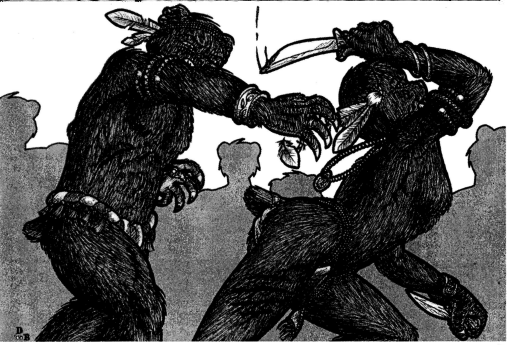
Every Gormoror wants to be a hero, but the definition of hero is variable. For some, it's about performing great deeds, protecting the week, fighting oppression, etc. For others, it's a more Classical variety of hero; basically just as violent an asshole as possible, beating up whoever they can, plundering whatever they can grab. Raiding a village, killing a few guards, and running off with as much loot as possible is considered honorable somehow. Bands of Gormoror will happily raid each other, or arrange duels between warriors of equal strength, and this tends to improve friendly relations between the tribes.
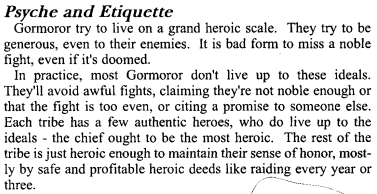
Gormoror duels have certain manners to be observed. Fights should be as equal as possible, such as setting aside a weapon against a weaker opponent. Maiming or killing your opponent is a faux pas, and killing your opponent so hard they can't be revived is REALLY bad form. Keep doing that and no one will duel you anymore, and there goes your social life. Letting your opponent surrender honorably is laudable, and a good way to get a new drinking buddy.
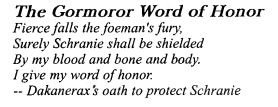
Honor is as important to the Gormoror as loyalty is to the Cani, both culturally and instinctually. A Gormoror doesn't give their word of honor lightly; once given their word MUST be upheld. No limits, no weaseling, no half measures. If you break your word through no fault of your own, you still broke your word. If the world's greatest monster tricks you into making the oath in the first place, you're still bound by it. If you're mind controlled, you still broke your word. Gormoror have a special hatred for mind mages.
A Gormoror that has never broken their word of honor is in gavm hau. Most Gormoror are in this state; they're careful not to give an oath they'll break. It's cowardly to never swear an oath, but you can just swear some kind of short term goal, like victory in battle, and most will do so at least few times.
If a Gormoror breaks their word, they enter a state called gavmkjorok. This is a sort of psychic stain; any Gormoror can tell at a glance, and most other species can tell if they study carefully. While in this state, a Gormoror is expected to perform some kind of miserable penance. Skipping bathing, living with the livestock, ashes in the fur, that sort of thing. Acts of heroism are right out. When the period of penance ends, the psychic blotch fades, but leaves its mark on their personality. The Gormoror is forever more considered gavm fenjosk, honorable again, but not as honorable as before. This is a disadvantage in some cases of tribal law, but doesn't otherwise prevent heroism.
If a Gormoror finds they're facing an oath they can't keep, or are subject to conflicting oaths, they have one way out: write a long dramatic poem explaining the dilemma, and then commit ritual suicide. If no one resurrects you, then your honor is considered undamaged.
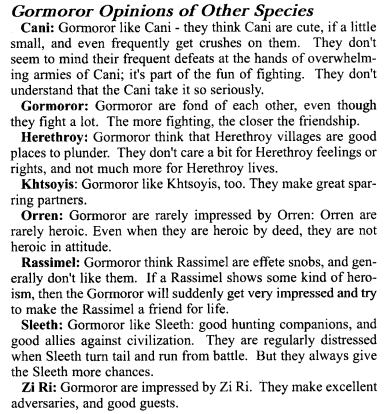
Part 2:The People cont'd
Original SA post World Tree: A Roleplaying Game of Species and Civilization
Part 2:The People cont'd
Herethroy
The cricket folk
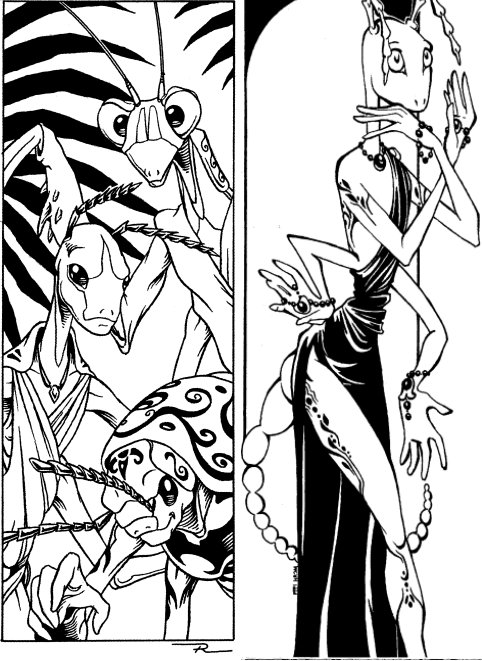
Herethroy are the farmers, villagers, and generally simple folk of the setting. They're hobbits, if hobbits were over 6 feet tall, went clank when they bump against furniture, and laid eggs. If I were to run a game right now, I'd probably play them like an episode of Letterkenny.
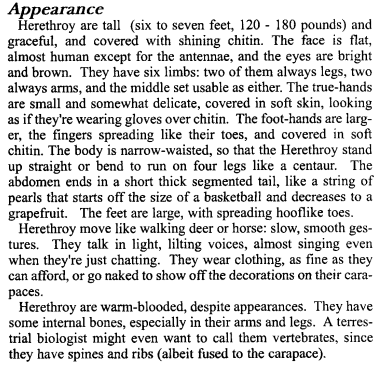
Physically, they're a lot like the Thranx from Alan Dean Foster's Commonwealth novels, except bigger. I wouldn't be surprised if the Thranx were a direct inspiration, at least for the visual. The string of balls tail is kind of weird, though; I have trouble visualizing it even with that illustration for some reason.
Generally, Herethroy like to live in small villages, about 50-100 people. Basically, if a village starts getting big enough that you need someone to be officially in charge, it's getting too big. Elders and village priests are as much governance as they generally feel they need.
Herethroy biology is kind of weird. They have three-plus-one genders. Male, female, and co-lover are the three genders needed for reproduction, both-female is an extremely rare gender that's not quite equivalent to intersex. The only visible difference between the genders, outside the bedroom, is that males tend to be a little smaller, co-lovers are considered the pretty ones, and females are larger and considered common and plain. Although the co-lover doesn't contribute any genetic material, they're still necessary to the process, and are considered the main parent to the child. Both-females are prejudiced against. Sometimes they're accepted if they're willing to behave as a co-lover, which are slightly uncommon and thus valued. If they're not willing, or the village is particularly intolerant, they'll be exiled or killed; a fairly obvious hook for why a Herethroy would turn to a life of adventuring.
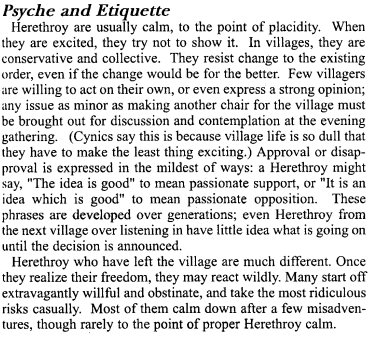
Another similarity to the Thranx. Also, I'm kind of amused at the thought of the most reckless dipstick in the party being basically the village kid on a rumspringa.
That's about all there is to say about Herethroy. It turns out, when you make "They're usually boring" into defining feature of the species, it leads to a short writeup. OH WELL. Even both of the short fiction pieces are basically "HI I work a boring day job, but sometimes I have to go out on an adventure when times are tough."

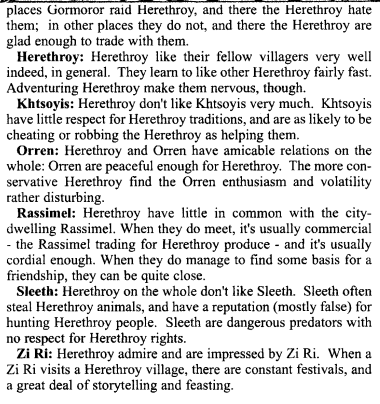
Luckily, the next species is my favorite.

Part 2:The People cont'd
Original SA post World Tree: A Roleplaying Game of Species and Civilization
Part 2:The People cont'd
Khtsoyis
The
 folk
folkKhtsoyis are the trash mistake of the prime species, and I love them. The creator god in charge of making them procrastinated until the last minute, then grabbed the nearest page of notes, crossed off MONSTER from the top of the page and scribbled in PERFECTLY GOOD CITIZEN and turned it in. Khtsoyis know they're the bottom tier stepchildren of the gods, and they deal with it in the healthiest way possible: by doing whatever the fuck they want.
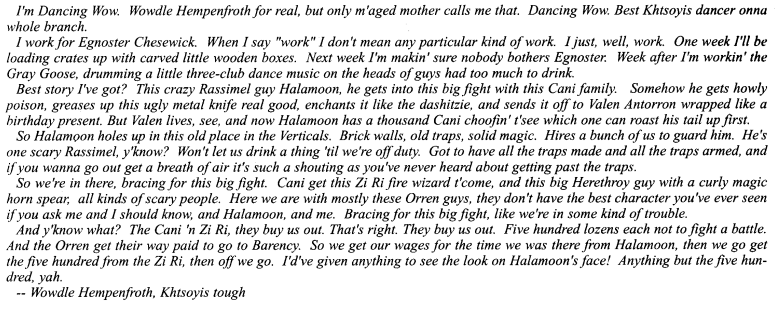
A Khtsoyis is basically a floating octopus, but with 7 tentacles instead of 8. Their ability to levitate isn't magical; or at least no more magical than any other natural occurrence on the World Tree. Specifically, they don't have to cast spells, and magic that affects magic doesn't affect their ability to float. They can move around horizontally and vertically with some exertion, but to go faster than a slow stroll they need to grab onto things and pull themselves along.
They have two mouths: One on the side of their body-head; it's just for talking and possibly for breathing. Their other mouth is a gross combination eating mouth/cloaca that's basically used for... everything else that comes in or out of the body. Luckily that business is kept hidden away at the junction of the tentacles. Their five eyes are on stalks, and can point around independently of each other for spherical vision, or pointed at the same thing for better depth perception. They have some camouflage ability; they can change color at will, but the possible colors are all dull tones.
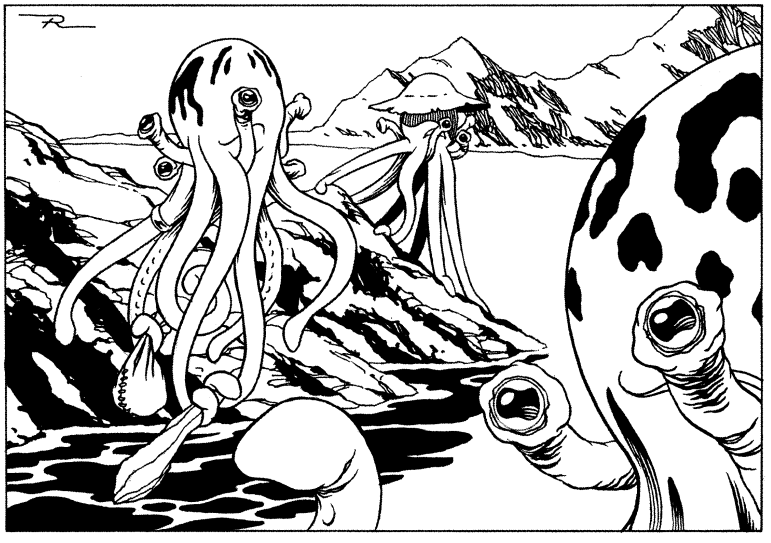
Stereotypically, Khtsoyis are simple brutes, preferring to spend their days drinking and clubbing. They're really good at clubbing; their levitation is silent and they can swing three clubs at a time as they descend over your head. If you imagine some sort of Dickensian street thug, you probably aren't far wrong. Khtsoyis that live in the city tend to be bodyguards, enforcers, bouncers, stevedores, and other kinds of hired muscle. Outside of town, they're more likely to be bandits.
As it turns out, the Khtsoyis reputation for dimness is almost entirely a social fiction; partly based on the prejudices of the other species, and partly the Khtsoyis playing dumb to keep expectations low. Ironically, a Khtsoyis is more accepted in civilized society than a Sleeth; even though both are considered wild savages, a Khtsoyis is considered far more predictable and controllable; Sleeth are too intelligent to be trusted. In actuality, Khtsoyis have the same spectrum of mental faculty as any other species, they just don't place any great value in being smart.
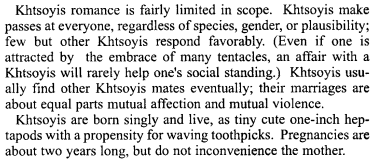
TINY TOOTHPICKS

Anyway, I like the Khtsoyis a lot. One of the first characters I made back when I was first exploring this system was Pinpox Reepledore, a petty criminal that had the brilliant idea of hiding from the town watch in the last place they'd look: he put on a shitty disguise, changed his name slightly, and enlisted. His plan to just wait until his crimes were forgotten and then desert failed when he accidentally turned out to be good at the job and got promoted to Captain of the Guard, and now everyone's paying too much attention for him to escape.
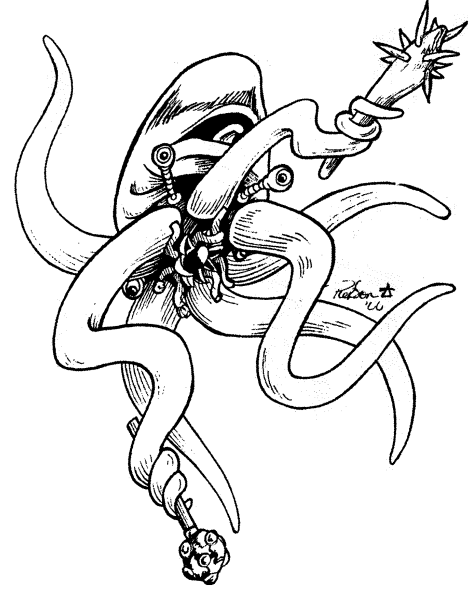
Look at this motherfucker, just so excited to be here and busting some skulls open. Also he's just busting his way through the text, making the layout a pain to read and making me have to scrub up a couple of these images. Rude.
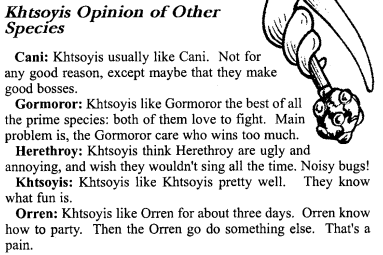
This bit about the Gormoror is interesting, because we already saw that the Gormoror don't care about who wins, so much as they care about the fight being glorious. OTOH getting in a fight with a drunk wet sack that grabs onto your head and starts biting your ears off at the same time as they're insulting your mother probably doesn't count as glorious, no matter who technically wins.

Part 2:The People cont'd
Original SA post World Tree: A Roleplaying Game of Species and Civilization
Part 2:The People cont'd
I think I'm going to do two in one batch this time. It's not that these two are boring, but they're very easy to summarize quickly.
Orren
The hippie commune otter folk

The orren are the most changeable of the prime species; both in terms of psyche and physically. They have natural shapeshifting abilities; on land they're your average furry, in water they shrink and shapeshift into actual otters. This is a semi-voluntary transformation; they can resist if they want to, but it's like holding back a sneeze. They can even adopt a mid-form, a swimming otter with proper hands for underwater work. It takes concentration, but not effort. They also get a bit of control over any magical transformations applied to them, transformation they want is easier, unwanted ones are harder.
Behaviorally, they tend to latch onto one thing they get super excited about for a few weeks, then they lose interest in it and move on to a new fascination. Their Steam backlogs are dire. When they get stressed, they tend to go into a wild rush, a frantic burst of energy where they act exceedingly quickly, but with complete lack of foresight.
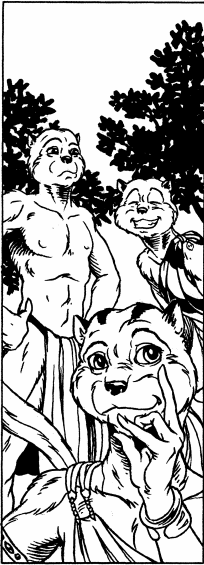
Socially, Orren like to live in low-stress situations. Families tend to be poorly organized poly arrangements, where all the responsibilities of being a grownup can at least be distributed as thinly as possible. They're not particularly monogamous, especially in the long term; no Orren really holds a grudge when the passion in a relationship fades and one or the other wanders off for something new. That's another reason for the larger families; more stability for the family as a whole, even though individuals come and go.
In a mostly Orren village, up to half the population doesn't do much besides laze around, go fishing, and play with the children, and the rest of the village doesn't mind. So long as the chores get done, who cares who does it? I have to admit that the Orren lifestyle has a lot going for it.
You tend to find the more motivated Orren in the cities, since the lazy ones will just go hang out in a village for a while. City Orren tend to balance their passions better; they'll juggle multiple interests to keep things fresh, rather than dropping things entirely. They're probably the healthiest species, psychologically, and they tend to do well in jobs where balance is valued. They make excellent judges and elected officials.
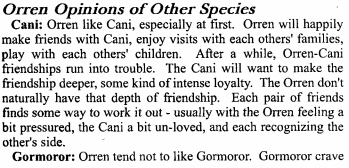
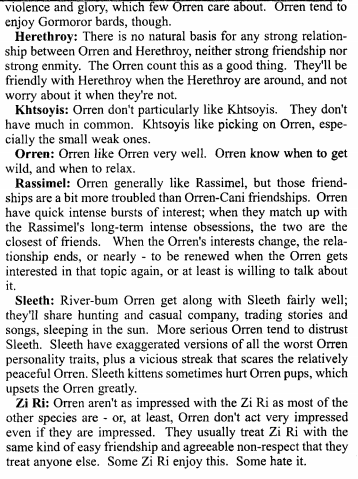
You can tell Orren are the emotionally healthy ones because they're the only species that doesn't buy in to the Zi Ri's bullshit.
Rassimel
The Raccoon folk
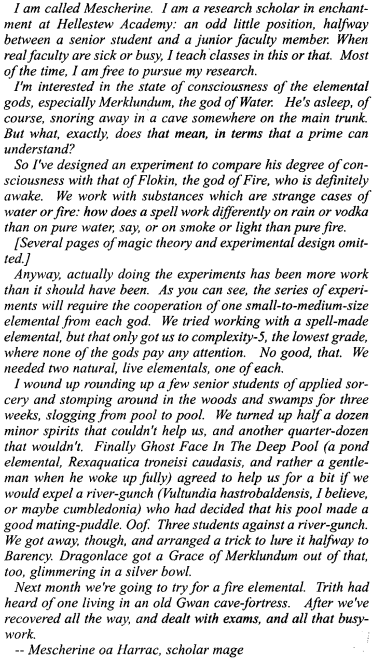
Rassimel are the polar opposites of Orren. They laser focus on one interest, and devote their entire lives to it. They make up the specialists and experts of the World Tree. A Rassimel devoted to, say, knowing every nuance of their city-state's legal code probably has a good career in their future. A Rassimel dedicated to collecting monster skulls is probably doomed to a life of adventuring.
Physically, they're the closest to a boring human of all the species. Other than being cute and fluffy, of course. They don't have any organs of flight, or transformation, or even sharp claws or fangs. Their primary advantage, and it's a big one, is that they learn and improve skills faster than anyone else. Other than that, all they have going for them is a moderate resistance to poison for some reason, and they're not bound by any circadian rhythm.
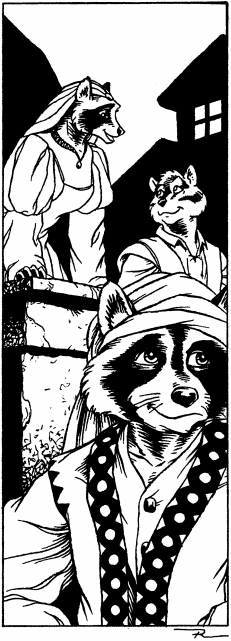
Moreso than any other prime species, Rassimel are almost entirely urban. Socially, they tend to prefer to hang around with other people that share their interests. Or maybe it's just that people that share their interests are the only people willing to spend any time talking to them. They're probably the most monogamous of the species; relationships tend to last many years, if not lifelong.
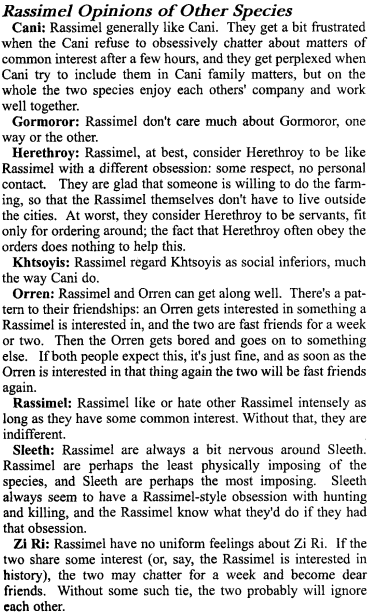
If you, presumably a human, wanted to make a World Tree character knowing nothing else about the setting, an Orren or Rassimel would be your easiest option. They're by the far the most relatable compared to the weirdo other species. "You get really excited about one subject and can't shut up about it" gosh that isn't something a goon could relate to.
Part 2:The People cont'd
Original SA post World Tree: A Roleplaying Game of Species and Civilization
Part 2:The People cont'd
Sleeth
The panther folk

Sleeth are cats. Not cat people, not catgirls, just straight up giant cats with all the insufferable bullshit that implies. They are, by nature, solitary hunters and predators. A Sleeth may enter civilization, but this doesn't mean they're civilized. It's an exaggerated stereotype that a Sleeth is a snarling ball of danger that will claw your face off as soon as talk to you, but it's not THAT exaggerated.
Physically, they get all the advantages of being a big cat like a panther or a tiger. They have deadly claws and fangs, their hides are as tough as armor, they're experts at climbing, jumping, swimming, sitting in boxes, stalking, and squirming into spaces they had no business fitting into. They can smell as well as a Cani, and they have even better night vision than real life cats; they can see in total darkness or in glaring light.
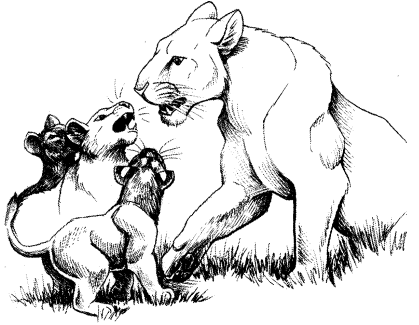
Not having opposable thumbs SHOULD be a limiting factor, but it's not. They have a natural spellcasting ability that lets them, without cost, perform telekinesis on small objects of animal matter. They carry around a bag of things they collectively call "prets and fiaps", which are an assortment of bone and leather objects that they can use as tools as skillfully as another prime would use their hands. They can use their magic to stun and fetch small animals, and even lift themselves in a crude brute force sort of levitation.
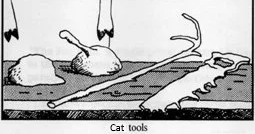
Sleeth rarely form groups of more than three or four, and almost always spend most of their time outside of civilization. A Sleeth that lives in a city needs a very compelling reason for it; maybe to live closer to friends, or the city has something they need, or for whatever reason they find more pleasure in stalking the streets than the forest.
Sleeth romance is... catlike. They rarely form permanent relationships. A date that ends with the neighbors screaming and throwing buckets of water at you is considered romantic. They have a reputation for being indiscriminate and inconstant.
Like how Herethroy are obligate herbivores, Sleeth are obligate carnivores, and prefer their meat to be freshly killed, preferably by them, and they have an unfortunate tendency to play with their food before killing it, especially if their bloodlust hasn't been sated lately. Occasionally Sleeth feel a need to eat some vegetables. Then they usually puke them back up. Preferably on someone's rug. This is normal.

Sleeth are proud and cruel. Sleeth dignity is unassailable. It's not that they believe they're better than you, it's just that they know they are 100% independent and self-sufficient and assume that everyone else is too. You can't shame a Sleeth; they'll shrug off the most humiliating blunder as if it never happened, and they'll happily beg for scraps off your dinner plate and roll over for belly scritches.
The Sleeth are the most amoral of all the prime species, and they're a contender for the most amoral species period. Every Sleeth is capable of cruelty; a "good" Sleeth is one that's only cruel to your enemies. Cruelty to friends, family, and innocent bystanders is considered a forgivable vice to Sleeth. On the other hand, this same lackadaisical outlook means they rarely bother with strong hatred either. They'll murder a bunny if it's convenient, but they won't bother attempting vengeance against a monster that killed their kittens. Getting a Sleeth to actually care about something is difficult, but if you manage it you have a powerful weapon at your disposal.
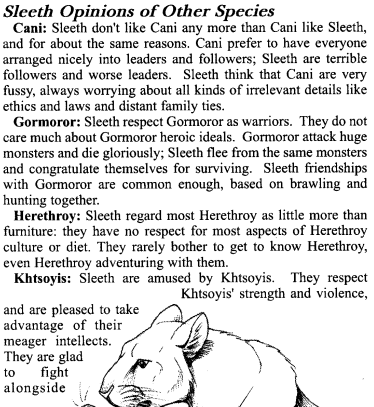
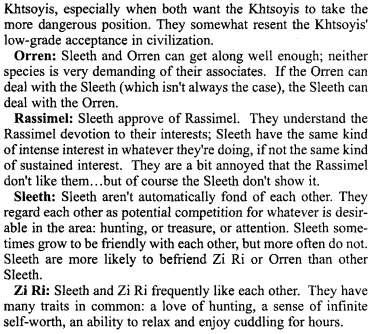
Oh and sometimes they look like Battle Cat.
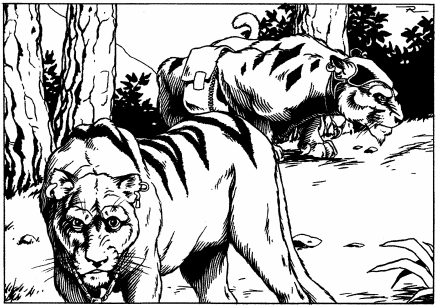
Part 2:The People cont'd
Original SA post World Tree: A Roleplaying Game of Species and Civilization
Part 2:The People cont'd
Zi Ri
The author's pet minidragon folk
Everyone who guessed that Zi Ri are the setting's elves, give yourselves a hand. They're the immortal species, with all the arrogance and power that comes along with that. There's a couple ways they stand out, though. For one thing, they're not an elder race. While an individual Zi Ri is likely to be vastly older than any person they meet, and in fact some are even as old as history, there was no ancient Zi Ri civilization. Zi Ri as a species were created at about the same time as everyone else.
The other thing, and this is mostly in comparison to D&D, Zi Ri are allowed to be as powerful as their age would suggest. Since this isn't a level or class based game, there's nothing constraining a thousand-year-old Zi Ri to be of a comparable power level to a Rassimel. On the other hand, since this IS a game, you're most likely going to be playing a very young Zi Ri to fit in with the rest of the party.
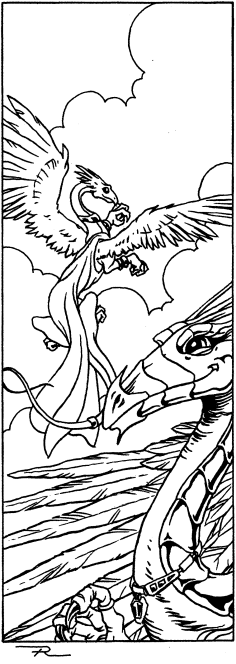
They're cute buggers, I'll give them that. Zi Ri are little miniature dragons, weighing in at maybe 30 pounds, and 5 to 6 feet long from snout to tailtip. They can fly, both by virtue of their wingspan and also by innate levitation similar to that of the Khtsoyis. Between the two, they're hummingbird-nimble, if not particularly faster than a pedestrian in a straight line. They breathe fire, with about the intensity and ferocity of a butane torch cigar lighter, and a fireproof enough that they can meditate in a fireplace to recover their magic.
Zi Ri mature slowly over the course of 300 years, and then stop aging entirely. At that point, only misfortune will kill them; about a dozen of the first Zi Ri ever created are still alive. They also don't suffer from ennui as they age, so the whole "immortal being that's tired of life" trope is right out. Their creator god is Hren Tzen, the god of sustaining, and zie made them as enduring works of art, possibly in zir own image. If so, then zie was kind of... well...

Yeah.
Anyway, all Zi Ri are hermaphroditic, and they're the primary reason the book made a point of establishing zie/zir as pronouns.
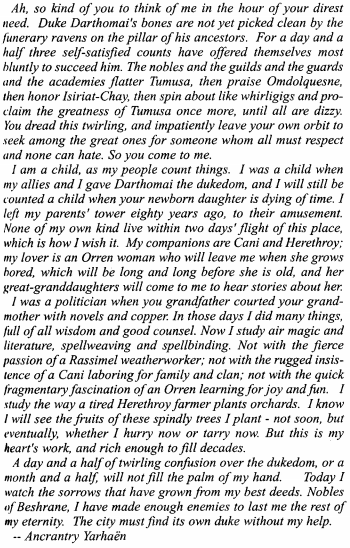
Basically, Zi Ri, especially older ones, constantly act like they know more than you, because they generally do. This doesn't necessarily make them experts on every given topic, but just imagine trying to talk to someone whose references and in-jokes are all about people that died before your grandmother was born. Typically they try to avoid political entanglements, but that's not a hard rule by any means.
Basically, Zi Ri were given all of the advantages, and they know it. They're also tiny and ridiculous and impossible to take completely seriously.
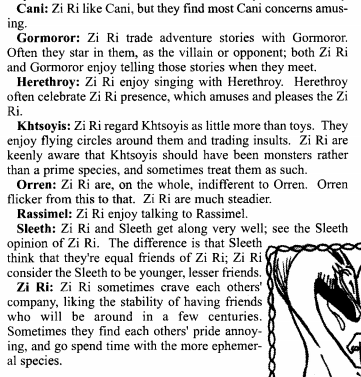
Part 2:The People cont'd
Original SA postWell we can mostly ignore the Zi Ri for a while, and instead move on to talking about EVERYONE ELSE (mostly gods)
World Tree: A Roleplaying Game of Species and Civilization

Part 2:The People cont'd
The prime species are the ones that the gods favor the most, that the World Tree was objectively designed around, but there are thousands of other sentient or near-sentient species out there. The nice word for them is "nonprime", the more common word for them is "monster."
The primes naturally have full access to every branch of magic; other prime species are limited in what magical arts they have access to. They may need to perform special tasks to gain access, or they may be cut off entirely. Primes also gain skill more quickly than any other species, especially when adventuring. The crude common tongue that all living things share has specific words for each of the eight prime species; no other species is named more specifically than 'fish' or 'bird.'
The real uncontradictable proof that primes are the most important is the magerium. Every living thing has a magerium. It's sort of like a metaphysical representation of that entity's magical self, and connects the mind to the spirit. To magical senses, a magerium looks like a tree. The magerium of a prime species looks like a miniature version of the World Tree, where every other living thing gets a shitty lesser normal tree.
Related to this is the prime's access to magic. There are 7+12 gods, and each one is responsible for a different art of magic. Every prime child born is personally touched, if only for an instant, by each of the gods in turn, establishing a connection to each of the arts. No other species gets this benefit; if they can achieve a connection to all 7+12 arts they have to work for it.
Even though they're all classified as "monsters", every non-prime has its own relationship to the primes. The cyarr (non-prime species don't warrant capitalization) are the most military threat to prime civilization; they are hyena-centaurs that have claimed vast swathes of branches near prime territory, and have the military might to fight back against prime expansion. The cyarr believe that if they can drive a prime species to extinction, they'll be able to step in and take the vacant place. Scawn believe that if they are killed by a Sleeth (or possibly kill a Sleeth, theories vary), they'll be reborn as a Sleeth instead of as a shitty little ratperson. Akamagga are six-legged lizards that have almost the exact same lifestyle as Herethroy, and consider themselves just as justified in utilizing available farmland as any prime. Some species, like wherriweffle, mherobumps, and taptets are even tolerated around civilized towns. They'll never exactly be invited to move in and live in the city, but they can live nearby and trade.
Gods
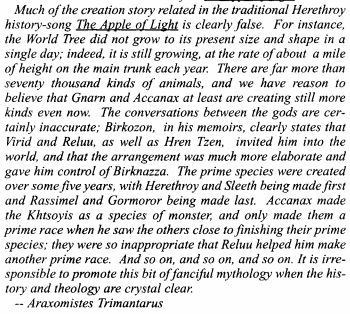
So, in retrospect, I kind of feel like I should have bumped gods to an earlier post. They're just that important to the setting. The gods existed before the World Tree, and outside of the space the world occupies. They created not only the physical world, but the entire universe; but there are other universes where they may not have any authority.
There are two types of gods. The seven Creator Gods came together and made the World Tree and everything in it, but generally abstain from the daily maintenance of the place. The twelve Noun Gods were invited in to help everything run smoothly. Both kinds of gods manage magic in the world; the Creator Gods are each in charge of a Verb (creation, destruction, control, etc.) , and the Noun Gods are in charge of the nouns (water, fire, flesh, time, mind, etc.). When talking about either gods or magic, they're usually counted as 7+12 instead of 19.
The Creator Gods
Virid (Creoc): Creoc is the verb of creation, and well suited to Virid. She created the World Tree itself, and the entire project was probably her idea to begin with. Most of the things she made are simple and useful, like crops and Herethroy.
Reluu (Ruloc): Ruloc is the verb of control. Reluu is nobility personified; if the gods have a king (probably not) it would be him. He created the Cani, and he's particularly proud of giving them the concept of affan, he'd like it if everything in the world was that organized. When Accanax fucked up making the Khtsoyis, Reluu stepped in to help make a "proper" species, which is why the Gormoror are big on both honor and bloody violence.
Mircannis (Healoc): Healoc is the verb of healing, and Mircannis the best-liked of the Creator Gods. Most of the things she made for the world are healing and/or beneficial. Herbs, honey-bees, wooly herd animals. She created the Rassimel, but isn't particularly Rassimel-like herself. Where Rassimel are intensely focused, Mircannis just sort of low-key loves and cherishes everyone.
Accanax (Destroc): Destroc is the verb of destruction, and maintained by the youngest edgelord of the Creator Gods. His moods range from a depressive miasma to a raging lightning storm. He's not good natured like the Khtsoyis, nor honorable like the Gormoror. Sometimes he goes into a frenzy and makes a hundred new kinds of monster, dumping them right on the border of prime lands just to make things interesting.
Gnarn (Mutoc): Mutoc is the verb of change, and decently well suited to Gnarn, Accanax's older and more capable sister. Destroc would probably have been more to her actual taste, but it's believed that she accepted domain over Mutoc so that Accanax could participate. She's much like the Sleeth she created, but even more cruel. Where Accanax is uncontrolled and indiscriminate in his destruction, Gnarn will create a single, elegant killing machine. Sometimes she appears as a Herethroy in the sky instead of a Sleeth, and no one has any idea why. She often comes down to the World Tree to hunt and mate with a Sleeth that caught her eye.
Hren Tzen (Sustenoc): Sustenoc is the verb of sustaining, and a decent match to Hren Tzen. Hren Tzen makes very few things, but what zie makes endures. Zie's all about beauty, elegance, delight, and little details like logic and reality are secondary. Naturally, zie considers Zi Ri to be zir masterpiece.
Pararenenzu (Kennoc): Kennoc is the verb of knowing. Like the Orren zie created, Pararenenzu is mercurial to point of being manic. Zie has an expansive sense of humor, and many of zir creations (but not the Orren) are punchlines to a joke. Zie is in charge of the art of detecting and knowing, but zie doesn't pay as much attention to it as zie should; one in twenty Kennoc spells fail when cast, sometimes with bizarre false results.
The Creator Gods, as wildly different as they are, all work together reasonably well. There aren't any divine wars for supremacy. It's not known if Mircannis and Gnarn like each other, per se, but they don't oppose each other. Magical spells could contain seemingly contradictory arts, like Healoc and Destroc, but this does not lead to conflict.
Noun Gods
The Noun Gods were brought in after the universe was created, and as a group are subordinate to the Creator Gods. Each has a sphere of influence covering some physical or magical aspect, often with overlap. While the Creator Gods live in the sky, the Noun Gods live on the World Tree itself, or at least nearby on a moon or something, and are much more likely to directly intervene in the life of mortals.
Kvarse (Corpador): Corpador is the noun of flesh. Kvarse is one of the most active gods, since all animal life is her domain. She taught the first Herethroy medicine and husbandry. She created the Healer's Guild, and maintains a subtle control over it. Kvarse performs miracles on a fairly regular basis; performing feats of great healing several times a year. The cost for these miracles is always seven years of hero's labor, either performed by the patient or someone willing to act on the patient's behalf. It's a lot like that WHFRP Bretonnia writeup: the cost is to go have an adventure. Kvarse is the elder sibling of Reluu, and a close friend of Gnarn and Hren Tzen; she is powerful enough to have been a Creator God but chose not to participate in that role.
Lenhirrik (Herbador): Herbador is the noun of plants. Lenhirrik usually takes the form of a Herethroy, or sometimes as a talking tree. She lives in a grove at the center of prime civilization, near the headquarters of the great orders of Herbador scholars and priests. She taught the primes how to grow crops, and created the first weapon; a spear that a Herethroy hero used to defend against the first monster attack. Lenhirrik used to be as active as Kvarse, sponsoring orders of knights and sending them out to help and defend others. But lately she's taken the unmoving form of a wooden statue, and she's been like that for thirty years, not responding to any attempts to communicate with her. Herbador magic continues to work, regardless.
Flokin (Pyrador): Pyrador is the noun of fire. Flokin is a brutishly friendly fire entity, so that works out. It usually takes the form of a Sleeth made out of fire, or a Cani made out of fire, just a fire, or a yowling song (made out of fire). Its primary job, other than managing the art of Pyrador, is to defend the World Tree against extradimensional horrors that sneak in. It's not very smart, and it's really not very subtle, so if you call Flokin to kill the Slug From Beyond Space you had better evacuate the branch.

Hressh-Huu (Airador): Airador is the noun of air. Hressh-Huu is a trickster spirit, usually taking the form of a mischievous wind. At the beginning of creation, she ran the weather according to random whim, and ran away in 14 directions from the Creator Gods when they tried to make her behave. So they wove some traps and baited them with puzzles and caught all 14 winds, and constrained her to provide reasonable weather most of the time, only allowed to cut loose one month out of the year. Hressh-Huu, and her elementals, love to interfere and complicate the lives of mortals, from snatching love letters out of your hand and delivering them to the wrong person, to carrying skyships to entirely the wrong branch.
Merklundum Harnipsundum the Dog Who Killed a Fish (Aquador): Aquador is the noun of water. Merklundum Harnipsundum the Dog Who Killed a Fish is a lazy lump of bramble dragon that doesn't do much of anything except sleep in a grotto low on the World Tree, where no prime has ever been. The one miracle he has ever been documented performing was when a scribe was writing out a list of Noun Gods and shortened Merklundum Harnipsundum the Dog Who Killed a Fish's name to Merklundum. Merklundum Harnipsundum the Dog Who Killed a Fish appeared and politely insisted that his name be written out properly thank you. He has never appeared since, no matter how badly his name is mangled.
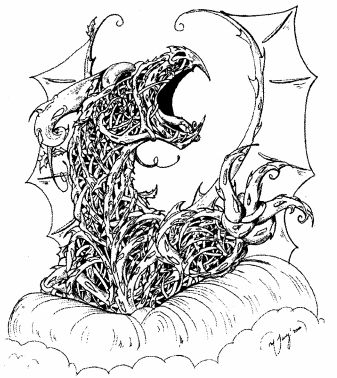
Tenmen (Durudor): Durudor is the noun of metal. Tenmen manifests as I shit you not a 2001 A Space Odyssey Monolith. He was worried that the primes would miss out on his element entirely, because metals and stone are so rare, so he personally showed up and taught them all about smithing, stoneworking, glassblowing, pottery, and so on. He created orders of smiths and knights, mimicking Kvarse and Lenhirrik, and gave them great gifts, but this led to so much accidental destruction that he withdrew the most powerful gifts and most of his direct influence; the guild of smiths splintered into a thousand trade guilds and his knight order never became important. If you seek him out, he'll teach you smithing techniques or metalworking spells in exchange for a suitable offering of craftwork.
 He is full of stars
He is full of stars
Shax Shay Shuz (Illusidor): Illusidor is the noun of images. Appropriately, SSS doesn't have a material for at all; if you meet zir zie will probably manifest as changes to your companions' faces. Zie lives in a castle of mirrors and crystals, with no fixed location. If you can find zir, zie we will often grant you aid in for the form of disguises, revealing events of the past or future, or letting you leave zir castle in a different place than you came in. Zie doesn't ask for any particular offering, but your life will get weird after dealing with zir. Zie is apparently one of the weakest of the gods, since most of zir power was spent on creating zirself out of zir own imagination.
"Here" (Locador): Locador is the noun of place. "Here" is a terrifying motherfucker. He doesn't have an actual name that anyone knows, he's just referred to by the word "here" in whatever language you happen to be speaking. He usually shows up as a Herethroy with holes in his black carapace that open to alien hellscapes. He is actively malicious, even more than Flokin, and delights in torturing and killing even the worthiest of petitioners, although he does often also grant the request. Basically, he's a goddamn Cenobite that someone put in charge of space and distance. The Lament Configuration would be extremely his jam.
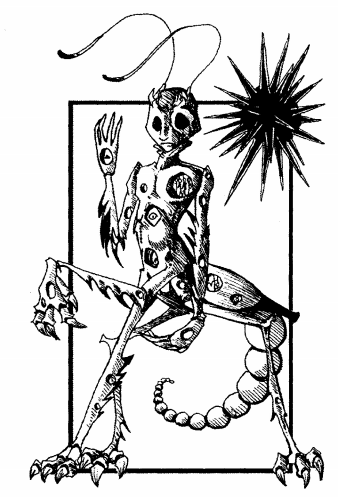
Iraz Varuun (Magiador): Magiador is the noun of magic. Iraz Varuun takes the form of a white-furred Rassimel hag in full wizard no-sense-of-right-or-wrong regalia. She knows all spells, and what she doesn't know she can invent on the spot. She's the patron of great wizards, especially the crazy ones. Tell her a good story about a complicated spell you cast that ruined everyone's day, and she'll teach you a dozen more. She can only teach the actual spells, arts other than Magiador are outside her domain. She plays mono-blue.
Birkozon (Mentador): Mentador is the noun of mind. Birkozon LOVES to get involved. If he had his way, he'd be in charge of everything, so the other gods have restricted him to influence over a single giant floating city named Birknazza. He manifests as a glowing Cani brain floating over the city, and wields titles like "The Eternal God-Emperor of the Grand Transcendent Kingdom of Birknazza." 20,000 primes live in Birknazza, fully under his control, with no privacy and little free will. His armies and champions are a match for any other force on the World Tree. However, his direct influence does not extend outside the city. If his champions go out, they go without his power boosting them. He hopes to gain indirect control over the entire World Tree eventually, and apparently the other gods will permit it if he can manage it.

Iraz Halix (Spiridor): Spiridor is the noun of spirits. Iraz Halix, Iraz Varuun's twin sister, is the mistress of ghosts and spirits; she wears the form of the despised and outcast. She can not be found by the living unaided; to meet with her you must perish on the journey to reach her, and then your spirit travels the rest of the way. Sometimes she enters the world in disguise, subtly nudging things here and there, unearthing buried secrets, and occasionally working to soften the damage caused by her sister.
Kaimiri (Tempador): Tempador is the noun of time. Kaimiri lives in a temple on the silver moon where primes can't easily go, but Kvarse says it looks like a sphinx staring into eternity. Kaimiri doesn't do anything itself. It has been in a state of meditation since before time began on the World Tree. Fortunately, it left its angels an extensive list of instructions and contingencies for all of the important events that will happen while Kaimiri is meditating. If something happens that isn't on the list, the angels won't do anything about it.
I think the most notable thing about the World Tree gods is that they operate in a very top-down manner. That is, the gods have an existence outside of and independent of the World Tree itself. The gods do not personify mortal aspects, they create and manage reality at a fundamental level. They're more of a celestial bureaucracy than a Greek pantheon. Notice that none of the portfolios cover anything like "War" or "Wisdom" or "Evil". Every Verb and Noun has an objective existence that isn't subject to differences of opinion.
Elementals
All of the gods have servants, either created by them or brought with them from wherever the gods came from. They're lesser beings than the gods, but still of an entirely different nature than living things. They could also be called angels, fairies, or demons. The gods personally handle providing magic and dealing with major events, most of the rest of the day to day stuff is done by elementals. The most commonly encountered elementals are Hressh-Huu's air elementals that are in charge of things like moving clouds from place to place, steering the winds, and all the other weather things. Since the World Tree doesn't have a proper biosphere like the Earth does, it takes a lot of divine intervention to get the weather to behave as temperately as it does.
The chapter finally ends with a few pieces of fiction. First is a few blurbs about different species pondering which species is the strongest. Everyone thinks the Zi Ri are super great, most species think every other species got all the luck, except for the Gormoror who are pretty sure they can kick everyone's ass.
Finally, there's an amusing little story about a baker that unknowingly insults Flokin when it wanders into her bakery. So Flokin storms off in a huff, and takes all the fire with it. No more ovens, no more bread. The entire bakery was freezing cold at all hours, and even the best wizards she could afford couldn't bring fire back into the building. The temple priests told her that maybe if she offers up a huge pile of sausages as an offering that would get Flokin's attention long enough to apologize to it. But on the way to the market, she passes a dairy and has an idea. When Flokin eventually wanders back to see if the baker has learned humility, she (very politely) begs him to wait outside, and gives him a giant offering of ice cream to stay out of the only store in town that offers frozen food year round.
Part 3: The Adventuring Life
Original SA post World Tree: A Roleplaying Game of Species and Civilization
Part 3: The Adventuring Life
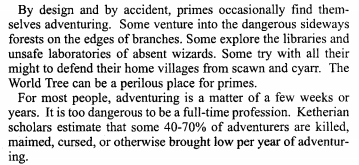
Where the previous chapters were about the daily life of regular people, this chapter focuses a little more on the stuff that's going to matter to adventurers.
First off is a brief discussion about why people go on adventures. The most obvious reason is when they can't avoid it. Sometimes adventures just happen to you. There are reasons why people would actively seek out adventure, though. One reason is for the experience. Experience in the literal RPG sense of the word; adventuring experience improves your skills faster than study or practice, and people of the World Tree are fully aware of this. Some Rassimel has probably carefully calculated the exact difference.
The other big reason is money. There's always some kind of treasure that you could go recover, if you're brave and skilled enough. Treasures like this tend to be natural occurrences, incidentally. The history of the World Tree is pointedly not a history of rising and falling empires, so ruined castles with dungeons overflowing with ancient hoards of coins aren't really a thing.
A third reason is just because there's no other place you fit in. If for whatever reason you don't fit in polite society, you can probably live your true self as an adventurer; no one expects adventurers to conform. Escaping a confining family or a prejudiced home village are common calls to adventure.
Once you decide, for whatever reason, that it's time to go on an adventure, you should probably find some people to go with you. If you've got friends or family that want to go, that's a good start. Maybe coworkers or classmates will help out. Failing that, most cities have a de facto place that adventurers hang around looking for work, usually a tavern, a room at a friendly guildhouse, or a clubroom at a university. There are things called Adventurers Guilds, but don't be fooled, those are leisure clubs for rich people to sit around sipping brandy and bragging about the last guided safari they financed.
A number of common types of adventure are listed out, presumably to give a broad sense of the kind of game this book supports. Exploration and colonization, fetching strange objects, rescuing someone, guarding someone or something, protecting villages or cities from monsters, responding to a disaster, or just wandering off into the wilderness and seeing what opportunities pop up. It makes a special mention of offering aid to monsters; non-primes often don't have the same defenses and protections as prime civilization, so if they get in trouble they might need a hero to save them. This can be very rewarding, but isn't great for your reputation.
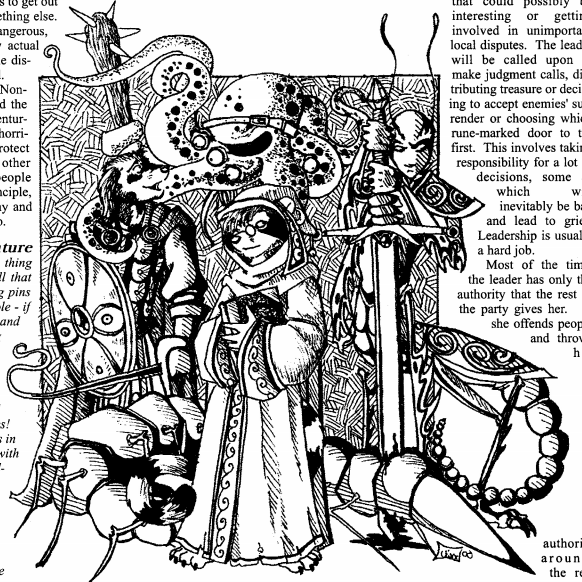
A page or so is spent on talking about the etiquette and administration of a party. Things like picking a leader, deciding what the leader's responsibilities are, how to keep everyone working together, how resources should be pooled, and what approach you should take with retreating or surrendering foes. It's mostly a lot of "We're not going to tell you what the answer to this question should be, but you should have an answer."
Next is an overview of travel options. Walking is slow and dangerous; there's a lot of wild territory between cities, especially at the edges of civilization, and the terrain is mostly hilly. If the road is too long or difficult, you could take a sky gondola, a low flying airship. For very long trips, teleport rings might be available; this is mostly only available in civilization, since people have mostly decided teleport gates are too dangerous to make more of so they don't get built in newly colonized lands.
Travelling from one world-branch to another is hard. Branches are hundreds of miles apart, even if one is directly over another. If they're on the same trunk, you could climb. If you're up for a vast trek over deadly terrain full of hostile life. If they're not on the same trunk, there's no other option than flight. Sky ships capable of crossing from one branch to another aren't uncommon, but they're not routine either, and they're not cheap, and the skies between branches aren't nearly as empty as you might think.
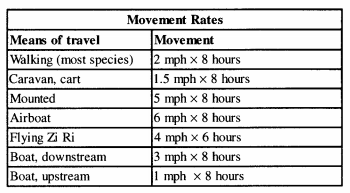
Money is pretty standard among prime civilization. The main currency is called the lozen, a hexagonal plate of amber about the size of two US quarters glued together, and with the buying power of about $10 in 2001 US currency. That's enough for a good but not fancy sit down dinner or a decent shirt. Magic is involved in the creation of lozens as an anti-counterfeiting measure. Any mage powerful enough to create a fake lozen can probably make more money much faster with other uses of their talent, but the penalties for counterfeiting are still harsh.
For small purchases, a coin called terch is common. While technically a lozen is worth 27 terch, in practice the two currencies aren't easily interchangable. Making a large purchase entirely with terch is even less likely to be acceptable than trying to buy a house with rolls of pennies. Terch are only used for small purchases, like buying a bun at a food stall or tipping a street urchin.
About a page is spent on a sampling of how much things cost. Food is a couple terch for street food, or a couple lozen for a restaraunt meal. Cheap tools made out of horn, bone, or meng nut will probably cost a lozen or two, but they break down and have to be repaired or replaced often. Good tools, metal and/or magical, cost a lot more. A metal knife would run 25 lozens new, or 10 used. Goods are available in a full spectrum between cheap junk and expensive quality goods.
Live animals are usually cheap; at least pets and foodstock animals are. The more care and training an animal requires, the more it costs. A good packhorse is 300-600 lozens, a trained warhorse is at least 2,000 lozens and don't expect to ride it off the lot and into battle the same day.
Boxed spells are expensive, but also an incredible good investment. Buying a spell is a one-time cost, and then you know how to cast it forever. And yes, you can literally buy a spell in a literal box to learn. Depending on the complexity, a spell could cost 100 to 10,000 lozens.
Small magic items are fairly readily available in cities, although you might not be able to find exactly what you want. Magic items on the open market are often hand-me-downs that have served their original purpose, student projects, or journeyman crafts. If you want a more specific item, it's not hard to find a crafter and commission the job.
Professional spellcasters usually price their services based on the most complex spell they can cast, not based on the difficulty of the spell actually being paid for. A wizard expends the same resources casting a cantrip as they do the most powerful spell in their arsenal, and they charge accordingly.
Bound magic is a new invention, and civilization hasn't settled on an accepted price for it yet, so it varies from caster to caster.
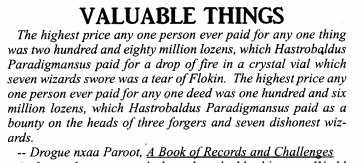
If you're going to go out looking for valuable loot, you should probably know what kind of thing is worth a lot of money. Metal is both very rare and very useful, so it's always very valuable. Some plant naturally produce small amounts of metal that can be harvested and refined if you know how, but gathering enough to be worthwhile is exhausting. Skilled mages can conjure small amounts, it's the work of days or weeks to conjure enough to be useful. Metal is additionally useful because it's harder than other materials to affect with magic. Items that are only partially metal are treated as entirely metal when trying to affect it with magic, which is both inconvenient and desirable. Some metals, like iron and lead, are basically the same as Earth equivalents. There's a few obscure metals with weird names that aren't like anything on Earth, though.
Amber is reasonably valued; amber from a common tree is cheap, amber from a rare tree is expensive. World-Amber, amber from the World Tree itself, is a special case. It's an incredibly durable material, even harder to work with tools or magic than metal. A suit of world-amber is every bit as good as a full suit of metal armor at only a hundred times the price. It's easy enough to find a deposit of world-amber, occurring naturally in a cleft of the World Tree's trunk, but actually prying it out of the tree and hauling it home to get paid is something else entirely. If you can find a handful sized bead of world amber that you can pick up, you'll turn a lovely profit.
Gems and stone are rare and expensive; there's no such thing as a quarry or mine. Some plants occasionally grow gemstones instead of flowers. The few mages skilled enough at Durudor to create gems are clever enough to hide their secrets and keep demand high. Deposits of compressed sand and clay serve as the most common supply of material for stonework, but they're small and uncommon. A more common building material is pounded dirt soaked with World Tree sap; almost as sturdy as sandstone, almost as flammable as wood.
Glirries are the equivalent of semi-precious stones, although they aren't stones at all. They're plants; specifically flowers but as hard as glass or marble. They range from being worth a lozen or so to several hundred lozens for the most beautiful.
Graces and Glories are unique to the World Tree, and are some of the most prized rewards available. They are a token of a god's favor, granting the owner some magical boon related to that god's magical art. Every grace and glory is unique, but they generally all take some form related to the associated god; a grace of Flokin might be an acorn made of fire, or burning words dancing on note. A grace or glory can be used instead of spending cley (magical energy) when casting an appropriate spell, and usually with a large boost to the spell's power. A grace may have the equivalent of 12 castings worth of power before being consumed. A glory usually only has 1 or 2, but the power refreshes every day. Both are extremely valuable. How much is it worth to a Zi Ri mage to be able to cast one more spell per day, every day for the rest of zir immortal life?
The rest of the list is mostly stuff that's valuable in any setting. Spices, perfumes, ivory, tapestries, alcohol, books, antiques, property, etc.
Slavery exists in the World Tree. Yes, this is probably a huge minefield. I'm not gonna summarize it.
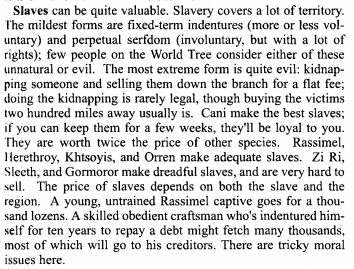
Tricky moral issues, huh? Well, OK then. I think maybe it would have been better to just leave slaves out of the list of potential loot.
Weapons
Weapons are a fact of life, especially for adventurers. Even though every prime is capable of casting spells, including attack magic, hitting your enemies with a sharp object is much more reliable and economical.
The basic adventurer weapon is the sword; usually of moderate length, thin, and double-edged. Cheap swords are made of meng nut and barely good enough for fighting vermin. Metal-edged wooden swords are more common for an adventurer on a budget. A fully metal sword is what any duelist really wants if they can afford it. There's some variation in sword styles; some are longer, some are broader, some are edged with hooks and spikes that aren't very practical for straightforward fighting, but can enable dirty tricks in a skilled fighter's hand.
Rapiers are the weapons of the wealthy; they're more suitable to dueling than for fighting for your life against monsters. Any other weapon would be about as effective at a fraction of the price, but that's mostly the point of having one.
Crushing weapons are common; clubs aren't exactly sexy, but you can't beat the price and some well-placed Herbador magic can improve their effectiveness. Maces and flails are the weapon of choice for people that want to show off how much money they have while caving in skulls. Khtsoyis in particular love clubs and maces; they can swing up to three at a time, and get significant bonuses when doing so.
Spears and staffs make good choices for people that aren't professional warriors. The advantages are the same as in the real world; all the dangerous parts of the fight happen at the far end of a long stick, and when you're not fighting you've still got a nice walking stick. Herethroy in particular are well suited to using polearms; they can wield a spear or staff in their lower pair of hands without interfering with whatever they're swinging with their main hands. A Herethroy knight with sword, shield, spear, and armor over their carapace is extremely difficult to hurt in a fight.
Missile weapons aren't particularly popular on the World Tree, especially for warfare. This is one of the big instances where game logic actually affects the game world. In real life, a single arrow is probably good enough to end a single enemy. But in an RPG system it can take several or even dozens of arrows to drop a single target, and where are you going to carry all those extra arrows you need? What about sniping, why can't you silently kill the sentry that's unaware of you just because the arrow only does 1d6 damage?
Anyway, on the World Tree everyone is fully aware that it takes a bunch of arrows to take down any serious warrior, by which time they've probably run up to you and started jamming their sword in you. Bows just aren't a very cost effective tool of warfare, and specialized archers are almost unheard of. Archery is more of a skill for hunting. That being said, there are useful tricks you can do with an arrow. Spells can be bound to an arrow, sometimes letting you deliver the payload at a range and accuracy greater than you would otherwise have.
Crossbows exist, but are even less popular. The best quality crossbow is worse than what we think of on Earth, mostly because it's not worth wasting metal on them. Thrown weapons are fairly common; it can be worthwhile to get an extra attack in while approaching the enemy. Think javelins, tomahawks, or cabers if you're big enough. No one throws knives; it's just a waste of time and metal is far too valuable to spend on making a throwing dagger worthwhile.
Knives and daggers are ubiquitous for anyone that doesn't already have natural weapons for close-in fighting, but they're weapons of last resort.
Armor
Many species have natural armor from their tough hides, but more is always better. Leather armor is cheap and convenient, you should almost certainly wear some if you can. For a little more money, leather armor can be reinforced with wood or bone.
If you're going to go pro, you want metal armor. Chain armor is standard, and provides good protection. Full plate armor provides a little better protection for a lot more price. Your money might be better spent getting some magical enchantments for your chain armor instead.
We've learned a lot about adventuring today. Hey, a random Khtsoyis, what would you say makes the best adventuring party?
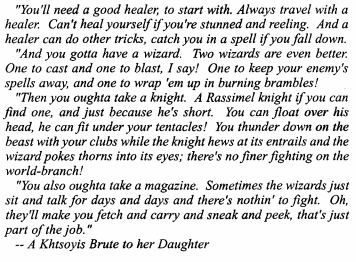
Part 4: Civilization
Original SA postBarudak posted:
Yeah, if the god of a world where they explicitly endorse chattel slavery threatens that if we kill them all the air will dissappear killing everyone my partys only response is going to be "Good, then we wont have to smell your corpse".
I just cant see running this game any other way, the world is too implicitly horrible to do anything but work to end it.
To be clear, chattel slavery is one thing that doesn't (currently*) exist on the World Tree. You can become a slave, but you can't be born a slave. Except for serfdom, anyway. And the gods didn't include slavery in the gift basket they provided the primes, primes came up with it all by themselves. The gods themselves neither condone nor forbid slavery, except for Birkonon who's basically confined to Fantasy North Korea anyway. A campaign focused on fighting against slavery is valid, but would probably be tangential to anything involving the gods.
The non-primes, though, really do have a solid case to make for "Fuck you and fuck this hellhole you made." Even the most hostile of non-prime cultures are really just trying to carve out their own life in a world where the deck is objectively stacked against them.
*I say currently, because in-setting a new technological development has given a huge boost to the power of the wealthy, and capitalism begets slavery. I don't think the authors had this discourse in mind when writing this in 2000.
Speaking of!
World Tree: A Roleplaying Game of Species and Civilization

Part 4: Civilization
History
Prime civilization is 4,000 years old, and all of it is documented. "Prehistory" in this context would literally mean "before primes existed" as there was no primitive preliterate culture that the prime species evolved from. In those 4,000 years, civilization has grown, expanded, and changed, and one branch of the tree can be quite unlike another. There's some common threads to all prime culture, though, mostly based around the center point of civilization.
History is measured from the time of the Birthing Field, the dawn of the first day when the Herethroy and Sleeth were placed upon the world. (The Sleeth immediately fucked off into the forest) The fact that sentient species like the nendrai and the akkamagga had been around for dozens of years is apparently irrelevant to prime history. The first Herethroy and Sleeth were created fully adult, sound of mind and body, neatly avoiding any chicken-and-egg questions. The Herethroy futzed around singing songs for a few hours, and then settled in to make the first village, Inihithre, which means "leaves on top."
Most of the gods came by the village in the next few days to introduce themselves and teach the Herethroy the basics of civilization; farming, building, woodworking, leatherworking, and so on. The Sleeth didn't need to be taught to hunt, but they probably could have used a refresher course because they chased a rongon into a grove where it stumbled into some Herethroy and wounded one of them. This is when Lenhirrik gave the first weapon to a Herethroy woman named Hrikkak the Mighty, who drove the monster off and got all the credit for being the first adventurer.
The Herethroy built the village larger, and when the Cani came three months later there were nine longhouses waiting for them. This was the formation of the nine major Cani clans. The Orren showed up two months later and immediately got comfortable.
The first winter also led to the first death; a Sleeth woman hunting in the Verticals lost her grip on the ice and fell off the branch. Her name was Arrarruu, and that name since has only been given to kittens expected to die soon after birth. Her kittens were the first Sleeth to say "fuck that" to living in the Verticals, and they moved back into the village and learned to deal with civilization.
The second winter saw the arrival of the Khtsoyis. They were violent and unhelpful, but it turned out that they were perfectly happy to be violent and unhelpful to monsters that threatened the village instead of to the villagers, so they got to stay. One Khtsoyis was probably the first moral philosopher: Poxague Hoorthockett discovered that the goddess Lenhirrik was not injured by being clubbed, and happily spent 100% of his time floating over her head and inventing new forms of percussive music every time she visited the village. Lenhirrik taught him beermaking and how to make narcotic teas, just to give him something better to do.
Poxague got drunk off his ass a few years later, and accidentally let a dangerous remorshka into the village, where it burned down some houses and killed a few Cani, including some puppies. The fact that it also killed Poxague did very little to assuage the Cani anger, and tensions between Cani and Khtsoyis led to the first fatal conflict between primes. The Cani were horrified at what they had done, the Khtsoyis were mostly just amused.
The Cani managed to work themselves up into one of those ugly group violence, distributing the blame and responsibility situations, and undertook what became known as "Blyn's Truce," driving out or killing almost all of the Khtsoyis in the village. Only 8 were allowed to remain, because some of the other primes had grown to like beer.
The gods, and Accanax in particular, were not pleased by Blyn's Truce, and Accanax threw dozens of new types of monster at the primes to torment them. The cyarr and the ulgrane were created during Blyn's Truce.
The Zi Ri showed up in the fourth year, and surprisingly were not immediately beloved. The primes were still afraid of another Khtsoyis scenario, and a young Zi Ri isn't very impressive yet. The Zi don't exactly take up a lot of space, though, so they fit in without issue.
The Rassimel showed up in the fifth year, and immediately started inventing things. Wolinare took one look at the village and immediately drew up plans for a wall for extra protection.
Most primes could count on their fingers and conclude that the Rassimel were the last prime species; seven gods, seven species. But then lo-and-behold the Gormoror showed up, waving around the corpse of the same remorshka that kicked off Blyn's Truce. The other primes appreciated having people around that actually enjoy going out and tangling with the dangerous monsters, and the Gormoror appreciated having people to do the boring planting and building stuff, and also provide them with weapons.
At this point, an age of expansion and exploration began. The second city on the tree was called Tauvane, which means "the new town", but nowadays means "a very very old place" to most people. They met and intimidated the scawn, made pals with the wherriwheffle, and had their first clashes with cyarr scouts. More cities were built, and the expansion grew.
The Age of Exploration
The second century of civilization was an age of exploration, both physically and even moreso intellectually. To this point, the only magic that primes had available was their innate gifts, like Sleeth telekinesis, and spontaneous magic like any toddler knows how to perform. To be really useful, spontaneous magic requires great skill in the relevant arts, and even then the caster basically has to invent the spell from scratch every time it is cast. The invention of pattern magic changed this.
Early scholar-mages studied the magerium, the metaphysical organ that houses magic in living things, and got the idea of grafting onto the magerium the same way you would graft a branch onto a physical plant. The first experiments didn't do much except burn the magic out of a bunch of scholar-mages and most people gave up on the studies, but Rassimel had gotten onto the job and Rassimel never ever give up. Eventually, after years of experimentation, a mage managed to graft a spell onto his own magerium and successfully cast it. All the scholars that had left the project came rushing back, and the process has been steadily improved and refined since then. The advantage of pattern magic is that it creates consistent, predictable, and repeatable spells. Now, instead of risking failure every time you try to cast a spell, so long as you can invent it in the first place you can cast it as often as you have the cley for.
The first pattern magics had to be invented by the same mage that wanted to graft it to their magerium. It took years before someone developed the technique to graft a spell onto someone else. Now only one person had to develop a spell, and they can share it with any number of other casters. This was the foundation of what most people think of as "spellcasting", and it was the massive technological advantage that powered a massive surge of expansion and colonization. The widespread availability of useful magic, especially healing magic, meant that primes could push further into more dangerous lands than ever before.
Enchantment was developed during this period, but it didn't have as much impact as pattern magic. While an enchanter can make wondrously powerful spells and items, the craft is extremely difficult and there are always few powerful enchanters. Everyone can use pattern magic.
In about seven hundred years, prime civilization had expanded to fill most of the region known as Ketheria, the uppermost branches around the main trunk. Future colonization would have to be on lower, less hospitable branches, or on branches of other trunks that can only be reached in flying ships. At this point, civilization largely turned inward, developing villages into cities, cities into metropolises. Guilds arose and spread among the city-states.
The age of exploration ended due to the same thing that caused it: pattern magic. A flock of ulgrane, piratical intelligent giant birds, raided a skyboat and captured a number of boxed pattern spells and a book of theory. A nendrai found someone willing to trade spells for treasure. Primes tried to uncork the bottle; providing magic to non-primes was universally banned, but the laws utterly failed. The secret was out, and the knowledge of pattern magic spread among all the non-primes. The technological advantage was lost.
The Age of Building
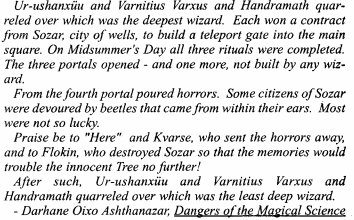
Expansion slowed for a time, the efforts of civilization turned to building. Enchanters became renowned figures as they created great works of public utility. This was when the teleport chains were created; teleport gates could be constructed from city to city, letting you follow the chain from gate to gate to get anywhere in Ketheria in hours instead of weeks. Trade flourished as all of the great cities, and then the frontier cities, were connected. The problem is that if gates are placed too close together, less than a mile or so apart, then shit gets all Lovecraftian and horrors can sneak through the gate. Tens of millions of people across four branches died in the worst event. When the ashes cleared, enchanters sealed up many of the gates, making sure that the remaining chains were spaced safely apart, with a large margin for error. The region of Ketheria and the neighboring branches connected by teleport gate are known as Greater Ketheria; the equivalent of a continent, it is not a political entity, but the region has a somewhat unified culture.
Other types of magic were invented during this time; ritual magic, spellweaving, pattern enchantment, but while they're all useful none were the major paradigm shit that pattern magic was, or that bound magic will be.
The Modern Age
At the time the game is presumed to take place, a brand new type of magic has just been developed, bound magic. Where pattern magic lets anyone learn a spell, but still requires the caster to power it with their own skill, bound magic lets a powerful wizard precast a spell with their own power level, and give it to another person that may not have any gift in that art whatsoever. Suddenly, not only does every prime have access to reliable magic, but now every prime could, in principle, wield the spells of their greatest wizards. Where before every adventuring party had to be sure to bring a skilled healer, modern adventurers can rely on bound healing magic. Instead of a dedicated fire brigade, buildings have fire-quenching spells bound to them, etc. If pattern magic was like the industrial revolution, bound magic is like the information revolution. This new advantage is empowering prime civilization to undergo a new era of expansion and colonization.
Scholars are also worried that it will upheave the social order. Before bound magic, no matter how rich or politically powerful you were, your access to magic was strictly limited by your own skill. But now, spells of, say, health and longevity are available to anyone that can afford them. Economic power has taken on a whole new importance that it didn't have before.
seize the means of magic production
Part 4: Civilization cont'd
Original SA post World Tree: A Roleplaying Game of Species and Civilization
This part is very wall-of-texty and I'm lazy so I'm breaking this into smaller chunks.
Part 4: Civilization cont'd
Science and Technology
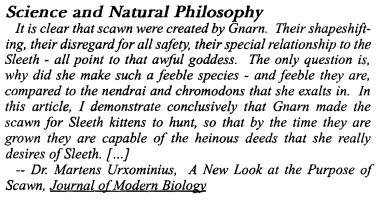
This is immediately followed by a response letter from another scholar enumerating exactly why Dr. Urxominius is clearly a fuckwit. Scientific journals are a transuniversal constant
Science on the World Tree is basically the same as science on the internet; taking a bunch of anecdotal data and asserting with unflappable confidence that your theory is clearly correct. It doesn't help that at the fundamental level, things happen because that's how the gods made it. Forget trying to come up with a Unified Theory of Everything. It's hard to set up a properly controlled experiment when the emotional state of a god can alter the results of whatever test you're doing.
So, science as we imagine it; deeply rooted in mathematics, each new insight opening windows into new avenues of exploration; doesn't work nearly as well on the World Tree. For the most part, science as a discipline is focused on study, identification, and classification. Primes are very interested in sorting out what god's domain such and such thing is. This can have direct application, if only so you know who to blame.
There's no conflict between science and magic. For one thing, magic is so essential to the existence of every thing in the world that science is largely a study of magic to begin with. For another, magic is just a part of daily life that you'd no sooner perform scientific study without magic than you would without paper. Magic theory is the most sophisticated and developed of all the scientific arts; the people that have invented new types of magic are regarded as the greatest minds in history. Also, magic itself tends to behave in a surprisingly coherent and predictable way, especially compared to a "world made by seven gods trying to outdo each other."
Some particular sciences are quite different on the World Tree. Chemistry is a fairly crude science. Matter in this world just isn't the same as in Earth's universe. Stuff isn't made up of molecules, atoms, and particles, it's made up of textured magic of one or more Nouns. Chemistry is mostly a toy for cooks and brewers.
Newtonian physics work more or less predictably, at least when dealing with solids and liquids. Air is Hressh-Huu's domain, who is too much of a ~Free Spirit~ to chain down with equations. Everything else at least works well enough for engineers.
Electricity simply doesn't exist; lightning is a particularly assholish variety of Airador. Magnetism likewise doesn't exist, although there are objects that magically attract each other in an analogous but entirely different way, like a particular type of nut whose shell tries to reassemble after breaking.
Optics doesn't work like on earth at all. Light itself is probably just some combination of Pyrador and Illusidor, and things like diffraction and refraction just aren't concepts.
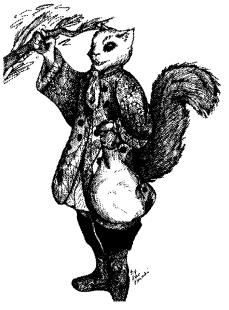 This random picture is probably just in the book to break up the wall of text, and that's the exact reason I'm putting it here too
This random picture is probably just in the book to break up the wall of text, and that's the exact reason I'm putting it here tooBiology can range from the familiar to the alien to the eldritch. The physiology of most primes, at least the mammalian ones, wouldn't confound a human biologist any further than 'why is this dead furry here?' would. The biggest difference is that prime bodies were designed, and as such every organ has a clearly defined purpose with no vestigial organs. The lucky fuckers have spines that were designed from scratch to support a biped, rather than being a quadruped spine repurposed, so they don't suffer as much from backaches from poor posture. Some primes have organs for levitation, firebreathing, or shapeshifting, and those would twig the human biologist right out.
A lot of the familiar plants and animals work the same way as on Earth. Trees have roots and move water and sap through capillary action, birds have feathers and are bird shaped, etc. On the other hand, there's lots of things that simply couldn't work on Earth; plants that grow in darkness instead of light, creatures that metamorphose into entirely different biological Kingdoms, or whatever impossible creation that a god saw fit to make, without being restricted by physics or chemistry.
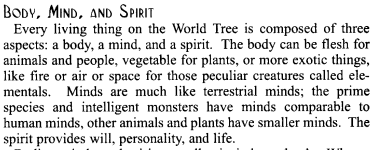
The existence of body, mind, and spirit is an objective observable fact, and I think that the setting does a good job at keeping the consequences in mind during worldbuilding. D&D in particular I think was always awful about having a clear concept of what the soul is and how it interacts with things like the afterlife, undeath, and so on. In the World Tree, there is no ambiguity on the subject.
The body is all the physical organs and meat. The mind is the (nonphysical) aggregation of the prime's rational thoughts, memories, unconscious desires, and so on. The spirit is the (also nonphysical) immortal animating force, the willpower, personality, and joie de vivre. Each of these three has a distinct existence. The gods attach a spirit to a newborn body, and over time the interaction of body and mind causes the growth of a mind as they intertwine. A body can exist without a spirit and vice versa; a spiritless body is basically braindead, and a bodiless spirit can be attached to an object or even a spell to give it a personality.
The body and the mind are connected by the brain, which we can all hopefully recognize. One ramification of this is that the brain is the connection point of the mind, not the mind itself, so damage to the physical organ brain doesn't necessarily damage the mind. The body and spirit are connected by the material longing, the urge to live. Mind and spirit are connected by the magerium, that tree-looking metaphysical organ that's responsible for magic the same way that lungs are responsible for breathing.
Magic
Every living thing on the World Tree has magic sense, a full spectrum of perception that doesn't exist in our universe. It's a feature of the body as a whole, or possibly of the magerium. It functions like smell, except you can "smell" with your entire body and it takes a conscious effort to perceive with this sense. Things with only a little magic can only be sensed up close, world-shaking artifacts could be sensed from miles away. Every Verb and Noun has its own unique spectrum of "scents" that can be distinguished with enough training and talent. The language that primes use to discuss magic sense is just as dramatic and overblown as the way humans try to describe the taste of wine.
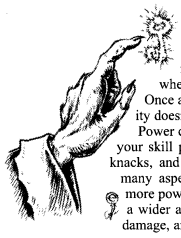
Cley is the resource that primes use to cast magic. One important thing to remember is that cley is not like MP in other games. Cley isn't what magic is made of, it's not used to fuel the spells. It's more like a renewable resource that's used to pay for magic. It's the spellcasting allowance that the gods give you. A single cley is enough to pay for a single pattern spell, no matter how weak or powerful or complicated the spell is. There's no such thing as half a cley; they are completely indivisible. They're purely magical objects, barely perceptible to magic sense and even then only if you're so close you're doing the magic equivalent of buttsniffing. They're like a key made out of magic, and using them is like turning a key, or pressing a key on a keyboard, or possibly like sculpting it. Everyone gets a new supply of cley every day, usually at dawn. First all the unspent cley from the day before leaves, and then a new supply comes in. Most people that aren't professional spellcasters have about 5-6 cley, hardcore mages will have as many as 20 or 30.
Everyone knows some magic. Most people will know a couple spells related to their profession; healers know healing magic, knights know battle magic, bakers know spells that make dough proof faster, cobblers know spells that stick pieces of leather together. Five or six cley isn't nearly enough that you can do everything by magic; a baker that relied on a bread-creation spell would only make half a dozen loaves a day and then be dry. Some things can only be done by magic, though, things like fireproofing buildings, conjuring metal, and so on. People will also know spells to assist in their personal lives. Kiss the Stinging Cut for minor scrapes, Clean the Clay Dishes to make chores easier, Prevent the Unwanted Child because magical birth control is more reliable than the rhythm method.
Magic is divided into 7+12 arts, 7 Verbs and 12 Nouns, and every spell is some combination of at least one Verb and at least one Noun, and has a number describing its complexity. The basic combat spell, Fire Flower is a Creoc Pyrador spell of complexity-5 (Cr Py 5). Wizard's Subtle Mirror is Creoc Kennoc Illusidor Mentador Spiridor 20, using Creoc and Illusidor to make an illusion of oneself, Kennoc and Mentador to read one's own mind and Spiridor to animate the illusion independently of the caster.
Practical Technology
As far as materials sciences go, the primes are about as sophisticated with the materials they have available as modern humans are. Prime artisans can work with leather, wood, glass, clay, and magic as capably as we can with metals and plastics.
Mass production is looked on with extreme disfavor. The nature of magic especially encourages specialization. A single powerful enchanter can do more to reinforce the city walls than an entire brigade of semi-skilled workers. This attitude extends to almost all crafts. The ideal is for each individual crafter to be a master of the trade. If you can't afford a master's work, then you buy a used product, or an apprentice's training work, or find the work of someone less skilled. The concept of churning out large quantities of mediocre-but-acceptable product is just not done.
Agriculture, in particular, is highly advanced. While plows are made out of wood, primes have worked out enchantments to let them perform far greater than anything on Earth. They got the food benefits of the Green Revolution without most of the attendant ills of industrialization.
Part 4: Civilization cont'd
Original SA post World Tree: A Roleplaying Game of Species and Civilization
Part 4: Civilization cont'd
Theology
This section is mostly stuff that's already been covered, except from the perspective of how primes study the gods. The gist is that even though it's possible to just go ask the gods directly, they hardly ever give a straight or consistent answer, so there's still a mess of conflicting theologies. Since understanding the gods would mean understanding magic, the primes still try really hard.
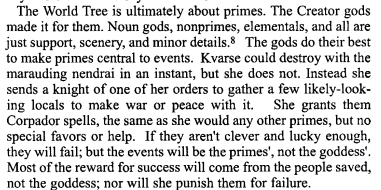
The Noun Gods are a little more likely to get directly involved in mortal affairs, but even they usually insist that primes take the protagonist role. Flokin can burn an extra-dimensional monster off the tree, but it'll refrain until someone actually asks it to. If you want a god's help in doing something, you have to go in person. That is, you need to have an adventure. Just going on the quest at all seems to attract the attention of the god, and they'll decide if the task of meeting them will be difficult or easy.
Occasionally the gods will ask something of mortals. "Here" doesn't need any help destroying a threat to the tree, but he might deputize some primes and send them to go gather information, or evacuate people from the area, or just clean up the mess afterward. Refusing a god's direct request is considered ungracious, at best.
The gods don't pay a lot of attention to individuals, usually. But it is possible to please or offend a god, whether by extreme effort or just chance. Usually this means that god's magic art works better or worse for you, but sometimes a particularly happy god could grant you a direct boon, or a really pissed off one can inflict a horrible curse. Both cases are vanishingly rare.
Belief is irrelevant. The gods know they exist and they don't need confirmation from you. Magic will work the same even if you don't believe in the gods. Atheists exist, in the sense that some people believe the gods aren't "divine," just very powerful, which is a defensible position. There's no particular concept of "sin", in the sense of actions that are taboo solely because a god says so. If the gods wanted to forbid something, they'd just make it a matter of natural law, like how a Herethroy can't eat meat.
The gods do not demand sacrifices, except for cley spent to cast spells. On the other hand, an offering might attract the god's attention and make them more favorable to you if you've got some kind of big request to make; a lot of ritual magic is based on this.
An individual god isn't omnipotent, although they're by far the most powerful entities in the world. Collectively, they might be omnipotent, since everything in the world comes from them, but they don't operate as a hive mind or in perfect concert. They're also not fully omniscient. They can know the answer to any question, but they have to know to ask. If one of you godkillers wanted to conspire against the gods, you could get away with it indefinitely so long as you never attracted their attention, but the moment they learn what you're up to then all of your plans and machinations become an open book.
Most people aren't particularly religious, in the sense of feeling a deep personal connection to the gods. Some people do, and they tend toward the priesthoods. Priests are mostly in charge of knowing what kinds of offerings make the gods happy and how not to piss them off. Fewer still take on a life of actual devotion to a god, and they're not well rewarded for it.
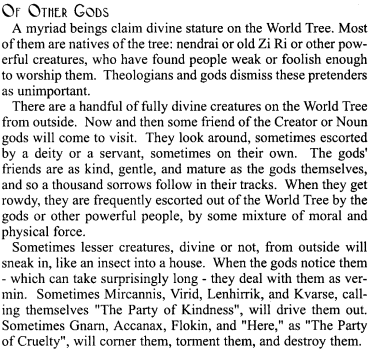
Sociology
This chapter has the impossible burden of describing prime social structures. Even though the primes are the same in body and spirit wherever in the world they're found, they developed too many different ways of living to enumerate. There's some generalities, though.
Mostly, primes live in small city-states with centralized rule. The rulership varies wildly from city to city. Hereditary rule, republics, guild councils, or whatever other arrangement you can imagine probably exists and is made to work. But the basic shape is usually a walled city for safety, ruling over the surrounding countryside that brings in the food and resources. The World Tree is very big and the population isn't very dense, so even when a nation grows very large it's still often broken up into districts or provinces for the sake of administration, so they end up behaving like city-states anyway.
Cities are important. If possible, primes live in cities, or near enough to cities to benefit from their protection. Even in civilized parts of the World Tree, there are monsters living no more than twenty or thirty miles away, among the Verticals. Cities are always walled, and the walls are always a pain in the ass. Walls are designed to keep monsters out, but monsters live on the Verticals where they can climb or fly anyway, so you need really good walls. And walls that are really good at keeping monsters out aren't good at letting primes in and out for their business. Intentionally helping a monster through a city wall is called doorwaying and is one of the few universally abhorrent crimes.
For the most part, walled cities really are for defense, not population control. City guards are usually more concerned with watching out for monsters than keeping the peace internally.
Laws are very regional. There's a few core principles handed down by Reluu, but they're not even as comprehensive as the Code of Hammurabi. They're basic commandments about protecting the weak, not murdering without reason, and similar principles that are probably so obvious they didn't really need writing down. Beyond that, law is some combination of custom, popular opinion, and edict. If something bothered a lot of people enough, or one really important person, then it becomes a law.
There's not much of a concept of universal "rights." If you find yourself in court, how fairly you're treated depends mostly on your social status. If you're poor or a Khtsoyis, then you're probably not going to be heard. If you're rich or powerful, then the court will probably try to find a resolution that doesn't upset you too much. Of course, none of that matters much if you manage to piss off a crowd large enough to take matters into their own hands.
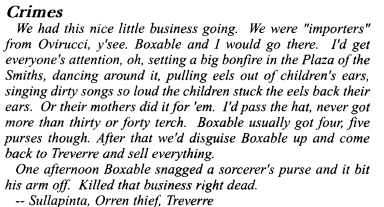
Crimes against property; theft, embezzlement, vandalism, and the like; are common. How severe the crime is considered to be depends on who you steal from. Stealing from your own neighborhood is considered despicable, and only the most desperate resort to it. Stealing from the wealthy is considered less heinous than stealing from the poor; at least in the eyes of an angry mob. On the other hand, the wealthy are much harder to steal from, they can hire guards. Stealing from foreign merchants is hardly a crime at all, more like a civic duty.
Crimes against people; assault, murder, kidnapping, etc. (rape is notably NOT brought up in this discussion, at all); are generally a matter for families and communities. Most people have a gang or a family to back them up, or at least avenge them. Rassimel are less likely to have this support, and are disproportionately victimized. When a situation does come down to violence, it often escalates into feuds and vendettas, sometimes expanding to involve multiple groups who start taking sides. Hopefully, some mediator will find a way to broker peace before things get out of control, an innocent bystander gets hurt, and an angry mob or the city guard crack down on everyone involved.
Crimes against institutions, like smuggling, are ironically one of the safer ways to crime. Yes, the duke says that dodging tariffs is a crime and yes you'll be punished if you're caught, but no angry mob ever tore someone apart for selling goods at a five percent discount.
Some things are generally not considered crimes. Most victimless crimes, like drug use or prostitution, are often not considered crimes at all, just distasteful. A few things are crimes even though the "criminal" has no control over it. Being born a cley vampire marks you as a criminal for your entire life, even if you never steal a single cley. In some villages, Herethroy both-females are in the same position.
Guilds and Orders
Blah, blah, they're medieval-style guilds. That is, they exist to protect the wealth and exclusivity of their members. Many of them span entire branches of the World Tree, especially guilds related to trade, but most guilds are only small, local affairs. Guilds exist wherever a group was able to establish a monopoly of something, and they guard that monopoly jealously.
The major exception is the Healer's Guild, one of the grand guilds that reaches out to the entire World Tree. The Healer's Guild admits anyone capable of meeting their standards, guarantees the competence of their members, upholds a code of ethics, and tries to make sure doctors are available wherever needed. They also don't fuss about holding a monopoly; if you want to perform medicine without paying guild dues, they won't interfere so long as you're actually helping people.
Knight-guilds and orders are NOT an exception. They're just like merchant guilds, but the monopoly they try to hold is on martial training.
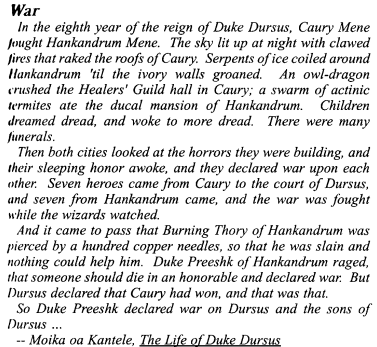
War on the World Tree is mostly shaped by how primes have access to magic. A single powerful mage can destroy an entire city, but most of the citizens have enough magical powerful to survive the city's destruction. Massed warfare is currently not common; it's better to rely on a few elite warrior-mages. Bound magic may change this eventually.
Most wars are boundary skirmishes over territory. Two neighboring city-states want the same village to fall under their domain, so they go to war. In this case, neither side is willing to commit to too much cost or risk. There's no point taking over a town if it cost you more than just building a new town somewhere else. In these disputes, war usually takes the form of a ritualized battle, possibly a duel between two champions, or a contest between knight guilds. Loss of life and collateral damage is low; often the nobility of the entire region will come and spectate.
If hatred runs deeper, or a duel fails to settle matters, a city may seek to destroy another. Destroying the city itself, as mentioned, isn't that hard, but most of the people will survive and now they have a strong motivation to destroy your city, and by the time the dust settles half of both populations are dead, the cities are uninhabitable, and the neighboring cities renew their preference for dueling.
Against non-primes, all bets are off. Ten thousand cyarr, or a single nendrai, may decide to assault a city, and in this case every able body joins the body.
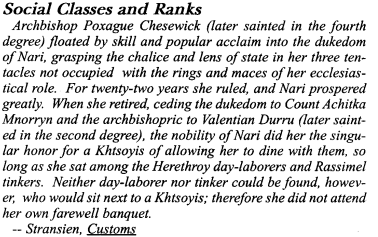
I like to think this Chesewick is related to the crimeboss Chesewick from the earlier story.
Social class is more or less on two axes; profession and status. Your profession is what you do, and there are fewer barriers to doing whatever job you want to do than you might expect. If a Sleeth demonstrates she can do the job of mayor, she can become mayor; but she might easily never be given the chance to prove herself.
Status is partially affected by your profession, but also by a lot of other things, as demonstrated by Chesewick's example there. Wealth, species, family, personality, deeds, and so on. A cani slave might hold a higher social status than his Khtsoyis owner.
Some words are reserved as badges of high status. An adventurer is barely a profession, and doesn't hold much status, but a hero is held in high regard. The only way to become a hero is to do hero things until people start actually calling you a hero.
I'm feeling motivated, so I'll bust out one more entire chapter.
Chapter 5: Ketheria
This chapter is really long, and consists of a timeline of Ketheria (the main "continent" of Prime civilization), then a more detailed description of major historical events, then even more detailed description of major political entities. Then there's an even MORE detailed description of a city called Treverre, which is a bog-standard median-in-most-respects city. There's plenty of stuff for a gamemaster to pick out for campaign ideas in here; since it's all in terms of setting up the conflicts without dictating how those conflicts will turn out. On the other hand, there's not a lot of interesting stuff for the purposes of this F&F readthrough. If I feel like people are still interested for some reason when I've covered everything else, I'll come back to this chapter, otherwise, MOVING ON.
Part 6: Can We Play Yet?
Original SA post World Tree: A Roleplaying Game of Species and Civilization
There's a cute little story interlude about the Sleeth Rrengra visiting our friend Azliet and meeting her family. It shows off the difference between Cani lifestyle, a large family living communally and sharing responsibilities, and the Sleeth lifestyle of total self reliance. There's a glimpse into domestic appliances; they have an expensive magical stove (provided as a wedding gift), and a cistern with a minor water-creation enchantment on it. Rrengra, being a fire mage, disapproves of the fireproofing enchantments that were placed on the walls, and will redo them herself if asked.
Mostly, though, I just think it's kind of a cute picture. Puppies!
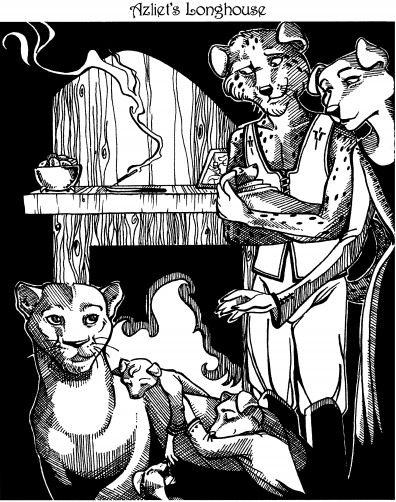
Part 6: Can We Play Yet?
Or: Basic rules for anxious players.
So, we're on page one hundred and fucking four, and we're just now getting to any mention of the rules. Not going to lie, having to flip a third of the way into the book to even start looking something up makes this kind of a pain in the ass as a reference. This really is a work that wanted to be split up into multiple books, but obviously that just wasn't feasible. Still, since chapter 6 is intended to be a basic rules primer, I really think it should have been at the front of the book to give the reader some context for all the world building coming up.
ROLEPLAYING
The obligatory "here's an explanation of what the thing you've already purchased actually is" section. Most of the players are players who take the roles of the chief characters of the story, one person is the gamemaster that does everything else. It brushes against the whole 'the gamemaster is omnipotent' trope, but eh, doesn't lean too hard on it. Not too bad, for a product of its time.
It does emphasize that World Tree is primarily a cooperative game. Even if the characters find themselves in conflict, the players and the gamemaster should remember they're working together to have fun and create a story. On a storygame pretentiousness scale, I rate it maybe a 3/10 at most.
CHARACTER CREATION
A little unexpectedly, the assumption is that, at least for the first game, you'll be playing a premade character prepared by the gamemaster. The more I think about that, the more it makes sense. Chances are if you're the gamemaster trying to get some players on board to play with you, you're either trying to convince your RPG friends to play this furry thing, or you're trying to convince your furry friends to try this nerd dice thing. Either way, asking them to get on board with the (rather complex as we'll see later) character creation may be a bit much of an ask.
Another interesting aside is that the text straight up says that you the player are responsible for remembering what the hell is written on your character sheet. You're the one who's looking at it, and the gamemaster has other things on their mind so if you're not paying attention and forget that you're immune to poison when the snake bites you, then fuck you you're poisoned. You can't see it over the forums but I've giving a dirty look at literally every player I've ever GMed for.
DICE
World Tree has a lot in common with the d20 system, which... didn't exist yet when this was written. Die rolls come in two varieties: simple and stress. A simple roll is marked as d20, d6, or whatever, and is just roll a die, get a value. A stress roll is marked as s20, s6, or whatever. You use stress rolls in the same way, except that the dice are exploding. If you roll the maximum value, roll again and add the new roll, possibly repeating if you get max value again. If you roll a 1 on the initial roll, then you risk botching. Roll some botch d6s (almost always just one d6, unless you're doing something extra dangerous), and if the botch die is also a 1, then your failure is worse than normal. So, yeah. Critical fumbles. 1/6 as likely, but still critical fumbles. Oh, well, people like them for some reason.
ATTRIBUTES AND SKILLS
Attributes are basically stat mods from d20, except without being derived from a vestigial 3d6 roll. An attribute of 0 is average, -2 is poor but not crippling, +3 is good enough to stand out, +5 is outright impressive. There are 10(!) attributes- Strength, Stamina, Dexterity, Agility, Perception, Faith, Memory, Wits, Will, and Charisma.
Skills are your learned or acquired abilities. Skills start at 0 untrained, 5 is a respectable amateur, 10 is starting professional, and 15 is an expert in the field. There's a whole lot of skills, divided into 9 groups. 3 of the groups are magical in nature- Verbs, Nouns, and Magic (a catchall category for general magic knowledge, as opposed to kill in an Art). The nonmagical skill groups are Fighting, Athletics, Rogue Arts, Social, Crafts, and Knowledges. Because of how experience works, the groups sort of serve as cross-training categories; experience you earn for using a particular skill might spill over to the rest of the group.
Like in d20, most rolls are tests to see if you succeed in a task. World Tree doesn't actually use any generic term like "skill check" but I think it's a useful term so I'm going to use it. A skill check in World Tree is Attribute + Skill + d20 or Attribute + Skill + s20, depending on whether dramatic success/failure is an appropriate possibility. In either case, you're trying to roll higher than some target value provided by the gamemaster. At this point, there's not a lot of context as far as what range target values could be. The one is example is that the average difficulty of picking a lock is 20.
Unlike d20, skills don't have any fixed association to attributes. You use whatever combination makes sense in the situation. In the lockpick example, if you're trying to actually pick the lock, that's probably Dexterity + Pick Locks. On the other hand, if you're studying the lock to learn something about it, that would be Perception + Pick Locks. Also there's no abbreviations and all skill checks are written out in full, in the form Dexterity + Pick Locks + d20 every single time and this is going to give me carpal tunnel.
It doesn't mention it here, but it's going to matter soon so I'll just spoil it: Sometimes more than one skill applies to a roll. This is almost always the case with magic. In these situations, you generally only add one skill (usually the worst) to the roll. Teaching someone to hunt, for example, might have you roll against Teaching or Hunting, whichever is worse.
EXPERIENCE
Experience is used for skills and only for skills. Your level in a skill is determined by how many experience points you have committed to that skill. Raising a skill one point costs as many experience points as the level you're increasing to. So to have a skill of five means you have spent, either all at once during character creation, or one level per session during play, 1+2+3+4+5=15 experience.
Experience is NOT spent on attributes or advantages, which is something that I think was a very good idea. I've always found that systems where everything is paid from the same pool leads to weird optimization problems. For example, in GURPS buying up your stats is so much more cost effective than skills that you can easily create two characters of the exact same point value, but one is literally better at everything than the other. By keeping every pillar of character creation separate, you can keep a better handle on actual power levels. The system isn't flawless, but it seems reasonably robust.
KNACKS
For whatever reason, you might have a knack in a skill. A knack is just a straight bonus to any roll using that skill. In most mundane situations, there's no mechanical difference between the number you add from your skill level and the number you add from your knack. In some situations, though, commonly when doing something magical, more than one skill applies to a roll. In these cases, you get to use all your relevant knacks, even if the knack is in the skill whose value you aren't using. If you're teaching hunting, you could get to apply your knack in hunting even though you're actually rolling against your lower skill in teaching. It's a little fiddly in concept, but it does add some interesting variability to skills.
TIMING
In combat, or in any situation where order of action matters, you use an initiative system. Turns are individual in nature; one actor takes their turn, then the next, then the next, and so on, but not entirely cyclical. Initiative is determined by drawing from an ordinary deck of 52 playing cards. Everyone who drew an Ace goes first and simultaneously, then all the 2s, 3s, so on to King, then looping back to Ace. Whenever you take an action, you draw a new card. You might act on A and then draw a 4, so that's the next time you act. Maybe after that you draw a 2, so your third action will be when initiative makes it all the way back around. Depending on the luck of the draw, you might act once in a "round" or you might act 13 times.
Each number of initiative roughly represents one second, give or take whatever fudge factor is appropriate to make the flow make sense. When it's not your turn to act, you're pretty much limited to talking and looking around. Those might be sufficient to set off bound spells, though.
I always thought it was interesting that your character sheet has absolutely no bearing on your initiative, neither does the action you're performing. What exceptions there are to the initiative system are large in nature; the rare things that make you faster make you draw extra cards and choose one, things that are slow require you to spend multiple turns. Nothing just messes around with +/-1 modifiers to initiative or anything like that.
Spells interact with the initiative system in an interesting way; many spells build rather than take effect the same turn you cast them. If a spell builds, you draw the spell its own initiative to see when it takes full effect, possibly giving the target time to react to it before it goes off.
COMBAT
Everyone has life points, indicating how healthy, big, strong, tough, and just generally hard to kill they are. A hardened warrior might have 50, a tough non-warrior has around 25, most people have less. If your life point total is positive, you're OK. If you go negative, you're incapacitated, if you go VERY negative you die.
Life points aren't an abstraction. They're not a handwavey 'luck and toughness and skill' like hit points. They're a known quantity in the setting. They're measurable. They're even measured in the same units that the game rules use. Life points are a skill that you can, and probably should if you live a dangerous life, train the same way as any other skill. A ramification of this: That rule about 'If your life point total is positive, you're OK'? People in the setting are fully aware of this concept. There are many different ways to lose life points, but when it comes down to it, literally every forensic report could end with "Cause of death: life points got too negative."
Combat usually involves making opposed rolls. The attacker rolls Dexterity + Weapon Skill + s20, the defender rolls Agility + Dodge + s20. For the sake of bookkeeping, the attribute+skill+all the other modifiers total just gets shortened to Attack Base or Defense Base. If the attack roll is higher than the defense roll, the attack hits. There's no separate damage roll. Damage is just the base damage of the weapon, plus the attacker's strength, plus a damage bonus for every full 10 points you beat the defense by, minus the defender's soak value. Nothing particularly revolutionary here.
Combat stance
Skilled fighters can choose to be more or less aggressive. On your turn, you choose a number, positive or negative, to be added to your attack rolls and subtracted from your defense rolls. So if you choose a positive number, you'll hit more often (and do more damage because high rolls trigger the damage bonus) but you'll get hit more often, and the opposite for choosing a negative value.
I like that every attack lets the player make decisions. Also, the stance system interacts with the initiative system in an interesting way; if you see that your opponent has drawn an initiative that's much later from now, maybe you risk going full aggro, hoping to get some good whacks in and still have time to switch to defensive before they get another turn. A bad draw could make this backfire, though...
Combat options
In addition to letting you choose up to a larger number for your combat stance, combat skill gives you a number of options to choose from in combat. I'll cover them when we get there, but for the most part they're additional options and modifiers you can choose from. Giving up accuracy for damage, pushing people around, reducing damage to hinder your opponent instead, and so on.
Magic in combat
Like I mentioned before, most attack spells build, rather than taking effect instantly. Defensive spells and counterspells are fast, they work the turn you cast them. Simple, low-power spells aren't very effective, the typical battle mage focuses more on distractions, healing, and other methods of supporting their allies. Powerful battle mages do whatever the fuck they want.
MAGIC
Most magic costs cley, which is like a spell-point but also is an actual nonphysical thing that exists and is consumed by the spell. A pattern spell always costs one cley, no matter how complicated or powerful it is. A spontaneous spell casts d3 cley; if you roll a higher cost than one cley you do get a power boost to go along with it, spontaneity can have its advantages.
Your cley capacity is, naturally, a skill you can train. Once per day, at dawn for most people, your cley is reset to Faith + Cley Base + d6. If you need more than that, you could meditate, or be given some from someone else; neither is very efficient.
Magic Arts:Nouns and Verbs
Using a spell is a skill check, Attribute + Skill + s20, like any other. The major difference is that you don't just use one skill, you use two. Every spell has at least one Verb, describing what the spell is doing, and at least one Noun, describing what the spell affects. You add both your skill in the Verb and your skill in the Noun to your die roll.
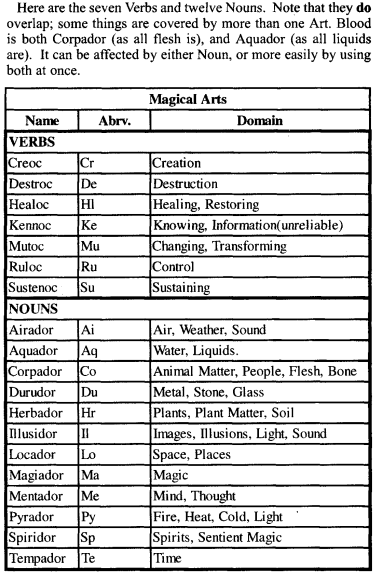
Many spells have multiple Verbs and/or Nouns. You always use your worst of the Verbs, and your worst of the Nouns. All applicable knacks apply, though.
Complexity and Power
Spells are measured on two axes, complexity and power. Complexity is how tricky the spell is to cast or learn. Complexity is always measured in multiples of 5. Complexity-5 is the lowest possible, the World Tree's equivalent of appliances. Common, easy to use, unremarkable. 10 and 15 are professional level, 20 and higher are serious magic. Generally, complexity is just whether or not you're able to cast the spell, once you do cast it complexity doesn't matter anymore.
Power is how effectively you have cast a spell. Power can be any number; it's the result of the skill check you made when you cast the spell. It affects lots of things; how much the spell does, how long it lasts, how hard it is to resist, how hard it is to dispel, etc.
Styles of Magic
Unless they actively seek out weird esoteric variations of magic, player characters will probably only use the three major forms of magic.
Pattern magic: Spells you have learned (by grafting them directly onto your magerium). To be able to cast a pattern spell, you need (Memory + Noun + Verb) at least equal to the spell's complexity. Note that you can learn a spell you can't cast yet; spell-sellers do this a lot. Once you're able to cast the spell, it works every time. Your skill check just determines the power of the casting. There's a few skills you can train to cast pattern spells with a little extra power, or with a chance of not spending a cley.
Spontaneous Magic: Primordial spellcasting. Make up an effect on the spot, anything at all, and try to invent a spell to do it. You might succeed, you might fail. Casting complex spells spontaneously is hard. You're not likely to achieve complexity 10 and 15 spells reliably, and almost no one can pull off anything higher without getting extremely lucky. After figuring out how complex the effect is, and what arts are involved, you have to roll Wits + Art + s20 > the complexity for every single art involved; fail any and the spell doesn't get cast. On the other hand, there are more things that go into the power roll for a spontaneous spell, so they tend to be much stronger than pattern spells.
Bound Magic: Minor one-use spells that are bound to objects. You're limited in how many you can own at a time by your Cley Base skill. Bound spells are designed to go off when some condition is met. This could be an activation word, or a specific event. Attack spells are often bound to a stick or a rock, and are activated by things like 'When I say ZAPPO then target the person I'm pointing the stick at' or 'When I throw this rock target what it hits'. Healing magic is commonly bound to 'When I'm incapacitated, heal me'. Using a bound spell doesn't involve a die roll or cost any cley; that was all handled back when the spell was bound in the first place.
Magic Resistance
When a harmful spell is cast on you, you generally have a chance to resist it. Make a Magic Resistance + s20 roll (Atypically, there is no associated attribute for this roll), and if it's higher than the spell's power the effect is reduced. In a pinch you can spend cley to get an extra s20 each on the roll. You may waive your magic resistance roll if you want.
OTHER TOPICS
Trouble
For whatever reason, things might be making your life harder. Maybe something blinded you, maybe you're really itchy, maybe you've been beaten up. Collectively, all the hindrances hampering you are called "trouble", and they're a penalty applied to all appropriate d20 and s20 rolls, including attack and defense.
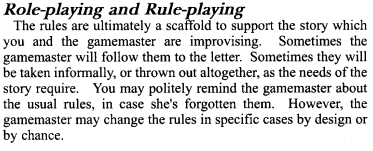
Good old Rule Zero making its appearance. Well, at least they didn't say "roll-playing."
Finally, here's a rad skull. Why?

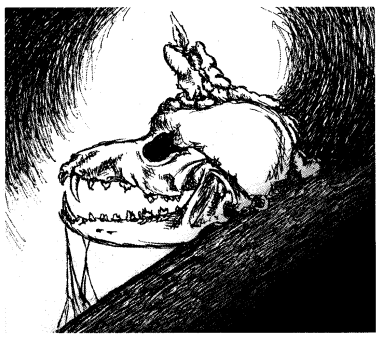
Part 7: Creating a Character
Original SA post World Tree: A Roleplaying Game of Species and Civilization
Part 7: Creating a Character
Character creation is very much a "craft the complete backstory of this individual", as opposed to some games where you start with a more or less blank slate and grow/discover the character during play.
There's an outline of roughly 10 steps to character creation, but it points out that the steps can blur together or be performed in a different order if that's easier for you. The process is complicated enough that they provide a worksheet to use to keep your bookkeeping straight, and then you transfer your completed results to your real character sheet.
This is where we get to see Azliet take shape as an RPG character, rather than just a recurring character in the fluff text; every step of the process has a little insert box that uses Azliet as an example of what they're explaining.
Step 1: Concept. There's no character classes in the game, but having a single-sentence character concept can help you keep focused on what's important when you're making decisions down the line. For example, Azliet is a helpful Cani healer.
A few broad suggestions are offered. You could be a regular person; someone who doesn't adventure professionally but has some reason to go on an adventure now. You could be a town guard, possible an officer or a detective. (The closest I ever got to running the game, I had sketched out a campaign where the players were members of the city guard in a city that did not respect them at all.) A scholar mage would have a lot of useful esoteric spells, and would want to adventure to find more magic. Or possibly to pay off student loans. A thief, minstrel, merchant, or thug are pretty self-explanatory. Knights are more like members of violent trade guilds than noble orders, but it's still an easy justification for why you go out and fight shit. A barbarian, someone that lives outside the safety of the cities, is a stereotypical choice for Gormoror; World Tree barbarians use magic just as much as everyone else does.
Once you've got your basic concept, you should flesh it out. If you want guidance, they provide about a full page's worth of questions about your character's past, present and future, as well as the player's intent. You can answer any or all of them as you feel like.
-What was your family like?
-What did your parents do?
-How many siblings and/or cousins do you have?
-What notable friends do you have?
-Did something interesting happen to you when you were young?
-Where do you come from?
-How and why did you leave home, if you did?
-Who trained you, and how?
-What have you been doing for the last few years?
-What do you look like?
-How old are you now?
-What kind of things are you (the character) interested in learning about or seeing?
-How religious are you?
-Are you married or in an equivalent relationship?
-Do you know the other PCs?
-What is your favorite food/color/pastime?
-What time of day is your cley refreshed? Dawn is common, noon is associated with honor and intensity, sunout with shyness, deceit, or sorrow, and midnight with evil.
-Why you like or tolerate adventuring?
-What do you want to do in life?
-How would you (the character) like to die?
-What kind of story would you (the player) like to experience?
-What kind of things do you (the player) enjoy or dislike in role-playing?
I actually really like this list. With the exception of the cley refreshing question, this would make a nice character concept worksheet for almost any game. I think with modern sensibilities, I would like to see some more leading questions worked in that can help tie your character to the upcoming game. Things like "Why does the Duke's little sister hate you?"
Step 2: Species templates. Every species comes with a bundle of shared features. Your chosen species has a starting array of attribute values, some free experience in skills that are important to that species, a knack in the Verb of the god your species is connected to, and some miscellaneous advantages and disadvantages. I'll come back later to describe the species templates in more detail.
Step 3: Attributes. As mentioned before, attributes are given in terms of direct modifiers to die rolls. +0 is perfectly average, -6 is extremely bad, and +6 is extremely good. You start with +0 in everything, and then adjust from there. First apply your species modifiers. Then, since adventurers usually aren't average, you adjust further from there. The second step is to add a fixed array of modifiers: +3, +2, +2, +1, +1, +0, +0, +0, -1, -1 arranged among the attributes however you want. Third, you may optionally apply a random tweak to any number of attributes that you want. If you want to gamble on an attribute, roll a d6. On a 1-2, subtract 1. On a 4-5 add 1, and on a 6 add 2. The average result is slightly positive, and even an unlucky roll can't fuck your character, so this is a nice compromise between people that like having random chargen and people that prefer good game design. Finally, choices you make later in chargen might add or subtract from attributes, when you're buying advantages and disadvantages.
Step 4: Advantages and Disadvantages. This is the bulk of the character customization. Advantages and disadvantages are purchased with a point system, only during character creation. Advantages are worth positive points, and disadvantages are negative points. In a typical game, you can have a total of +5 points worth, with a limit of -10 points of disadvantage; so a total possible maximum of +15 points of advantages. After character creation, any changes to your character are entirely organic. If you find a magic sword that would have cost advantage points during chargen, you don't have to pay it off with more disadvantages. Conversely, if you lose a leg you don't get any free advantages to make up for it.
Things that advantages can give you (or disadvantages can take away) include, but are not limited to, skill experience, knacks, spells, special abilities, items, money, or professional experience. There are a LOT of advantages and disadvantages; along with spells that's going to be the most exhausting part of the book to cover, I suspect.
Step 5: Experience into pools. In this step, you get a big wad of experience that you divide up among the 9 skill categories. You get 20 blocks of 30 experience each, divided however you want.
Step 6: Pools into skills. After your experience is roughly blocked out, you take the experience points in each category and divide it among the actual skills, adding to the experience points you already got from your species template. Cley Base, Magic Resistance, Combat Stance Base, Life Base, and Dodge are pointed out as VERY important for adventurers to pay attention to. You should try to use up as many of your experience points as possible. If any experience is left over after character creation, it goes back into that category's pool. This also applies to a skill with a partial level; the extra points are just returned to the category's pool instead of tracking the skill's partial progress.
Step 7: Choosing spells. Every prime knows at least 3+d6 spells of complexity-5. You probably want more than that, and you have to choose advantages that provide them. Or pay money for them, I suppose. Be sure that you're actually able to cast the spells you choose. Our friend Azliet ends up with 32 spells, ranging all the way up to a couple of complexity-25.
Step 8: Money, possessions, and bound spells. You start with (sigh) random money, s6x100 + s20x10 lozens. If either of the stress dice both, (i.e. you roll a 1 on either the d6 or the d20, and then you roll a further 1 on another d6), then you're flat broke, but you get an extra +1 to spend on a non-cash advantage.
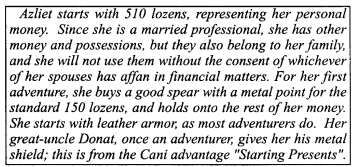
You automatically start with basic equipment that's appropriate to your skillset and profession. If you have a high Pick Locks skill, you just automatically have a set of lockpicks. If you're a noble, you have access to a mansion, coaches, cooks, maids, and other stuff that isn't particularly useful when crawling around on the Verticals but is still nice to have. If you're an adventuring type, you can have basic leather armor and a bone or wood weapon if you want.
You'll want some bound spells. You can pay for them, or if someone in your party is skilled at spellbinding you can do it yourself. Players are allowed and encouraged to abuse the heck out of spellbinding to give each other free bound spells.
Step 9: Details. This is mostly reconciling and fleshing out how your character generation decisions mesh with your concept from back in step 1.
Step 10: Permanent character sheet. Take that messy worksheet you've scribbled all over and a nice clean blank character sheet, and start filling out the second from the data on the first. There's a few derived values to work out: Your life points are equal to 3x(Life Base + Stamina). Your Badly Injured and Terribly Injured thresholds are at 1/2 and 1/4 your Life Points, rounded down, and dead is at negative (Life Base + Will). Work out your base Cley per day, the Attack values for each of your weapons, your Defense and Soak, and choose a combat option for each level of Combat Skill Base you have.
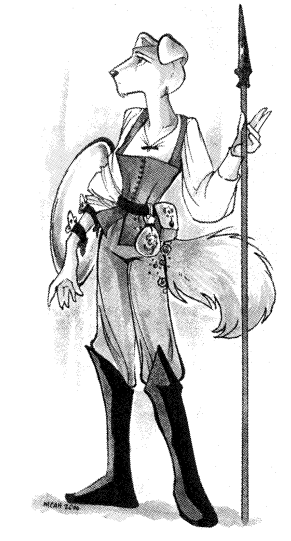
Here's Azliet, all geared up and ready for adventure!
Species Templates
Every species gets their list of skill experience on one page, and their attributes and advantages on the next. I'm going to skip over a lot of the exact numbers because who fucking cares, and just list out what they get unless there's something really noteworthy. In the case of skill, I'll bold any skill that gets more than a token allowance of experience points
Cani
Skills: Cley Base, Magic Resistance, Ruloc, Life Base, Brawl, Combat Stance Base, Dodge, Ride, Track, Alertness, Search, Command, Empathy, Etiquette, Flirting, Friendliness, Guile, Intimidate, General Knowledge, History and Literature, Social Knowledge, Law, Teaching.
Attributes: +1 to Strength, Perception, Faith, and Charisma.
Advantages
+4 Knack to Ruloc, the Art of control.
A +3 Knack to a social skill of choice; dominant Cani have Command or Intimidate, less dominant personalities have Friendliness, Etiquette, or Guile.
Loyalty bonus: Cani instinctively become loyal to anyone that they've been around for a few weeks and get +1 to all stress rolls (s20) for skill checks when loyalty is factor, such as working with the group, defending the group, or doing the thing you have affan in while your people are watching.
Natural Weapons: Cani have teeth and claws if need be. Weapons are always better, but Cani are never disarmed.
Natural Armor: Cani fur and skin provides +1 Soak that stacks with armor.
Excellent sense of smell: +6 to skill checks involving scent, and Cani can make distinctions between scents that are impossible for any other species except Sleeth.
Family Connections: Cani belong to large families with relatives everywhere. Even the lowest status Cani probably has distant cousins somewhere that'll provide food and a place to crash.
Starting Presents: Cani adventurers start off with a useful item from their family. A typical present is a metal weapon or a modest magic item.
Clan Affiliation: You're a primary member of your choice of one of the tree-wide Cani clans, which has a personality stereotype that no one actually expects you to adhere to. You're an auxiliary member of 1-3 other clans of your choice.
Married(Optional): Cani are usually married, and can take the Married Advantage at no cost. (Adventurer strength spouses still cost advantage points.) There will be 3d6 adult members of the household, including you, spouses, and in-laws.
Gormoror
Skills: Cley Base, Magic Resistance, Destroc, Ruloc, Life Base, Brawl, Claws & Teeth(men) or Knife(Women), Combat Stance Base, two different weapons kills, Dodge, Climb, Dance, Hunting, Run, Swim, Track, Alertness, Set/Disarm Traps, Sneak, Flirting, Intimidate, Animal Handling, Gormoror Bard, Medicine, Wilderness Survival, General Knowledge, Natural Science.
Attributes: +2 to Stamina, +1 to Strength, Perception, and Will, -2 to Agility. Women get an additional +1 to Stamina.
Advantages
+3 Knacks in both Ruloc and Destroc magic
+5 Knack to Combat Stance Base (This only affects going aggressive or defensive, not how many combat options you get)
Berserk Life: Gormoror can keep fighting after taking wounds that would kill another prime. If you fall below 0 life points and stay there for longer than a second, you go berserk. Ignore all Trouble from wounds and fatigue, take your maximum aggressive combat stance, and add +s6 (can't botch) damage to every hit you make. You can take 2-4 more actions in this state, secretly rolled by the gamemaster, who will tell you when you're about to take your last action. If you're healed, the berserk state ends. Recovering from going berserk leaves you with Trouble 10 for the rest of the day. Recovery will last for over a week if you actually die after berserking and get revivied.
Natural Armor: +1 Soak
Word of Honor: Gormoror must keep their word of honor or suffer gravely. They can easily tell if another Gormoror has broken their word, +10 on the roll. (What roll? It doesn't say.)
Resistance to Mind Control: +s20 to all resistance rolls against Ruloc Mentador spells, and double effect from each cley spent to resist Ruloc Mentador. This doesn't help against spells that are not both Ruloc and Mentador.
Alcohol Tolerance: The first three drinks in a drinking session have no particular effect.
Gormoror Bard: The particular style of Gormoror poetry and singing is an extra skill for Gormoror characters.
Herethroy
Skills: Cley Base, Magic Resistance, Meditation, Creoc, Combat Stance Base, Life Base, Pole/Staff, Climb, Dodge, Running, Set/Disarm Traps, Bargain, Empathy, Etiquette, Flirting, Friendliness, Animal Handling, Gardening, Herethroy Singing, Woodworking, General Knowledge, History and Literature, Judge Value (as in judging the value of something, not how many judges you're worth), Languages, Law, Natural Science, Teaching.
Attributes: +1 to Stamina, Faith, and Wits, -1 to Agility.
Advantages
+4 Knack in Creoc
+3 Knack in Climbing because of the extra limbs.
+6 Knack in Running if using four legs, and they can keep that speed up for longer than normal.
Carapace: +2 Soak
Extra Hands: If standing on two feet, Herethroy have four hands available. They can also use three-handed swords. Somehow. The geometry of that concept escapes me, but I guess that's why I'm not a fantasy cricket person.
Pole/Staff in lower hands: A polearm or staff held in the lower hands can be used more effectively than the normal multiple weapon rules.
Special Skills: Herethroy have access to Gardening and Herethroy Singing, which are very important to the personal and social lives of Herethroy, and not important at all to the adventuring lives of Herethroy.
Khtsoyis
Skills: Cley Base, Concentration, Magic Analysis, Magic Resistance, Meditation, Destroc, Brawl, Combat Stance Base, Crushing Weapons, Life Base, Dodge, Running (more like float-crawling), Track, Alertness, Pick Pockets, Search, Set/Disarm Traps, Sleight of Hand, Sneak, Bargain, Flirting, Guile, Intimidate, General Knowledge, Judge Value, Law
Attributes: +3 to Stamina, +1 to Strength, -1 to Wits and Charisma.
Advantages
+4 Knack to Destroc
Sneak bonus: Khtsoyis float silently and can change colors, they get +10 to rolls for sneaking and hiding in most situations.
Self-healing: Khtsoyis have the ability to regenerate at will. For the cost of two cley, they heal d6+Stamina Life Points. This is a conscious act, but can be done at the same time as another action at no penalty. On the other hand, their crude bodies lack a lot of important organs, so they don't heal naturally like other primes do unless tended.
Tough Skin: Khtsoyis skin is like leather armor. I'm not sure why it doesn't just say a Soak value. Does this stack with armor, assuming you can even find armor to fit a Khytsoyis?
Poor Taste and Smell: -3 to all Perception rolls for those senses. They think of this as an advantage; they can drink and enjoy the cheap shitty beer that other primes won't touch, and they don't need to clean their homes.
Air-swimming: With tentacle-holds, Khtsoyis can move at normal speeds, and they can float at half-speed without anything to grab onto. They can carry 100s of pounds of stuff while floating, so long as they grab with all their tentacles.
Color Changing: It's not perfect, but they can change color to match their surroundings or just for fun.
Armor Limitation: No one makes armor for Khtsoyis, and they can't wear anything that covers their tentacles or else they wouldn't be able to move, so they rely on light harnesses and shields at most.
Clubs and Shields: Khtsoyis prefer to use clubs(or maces, which are just posh clubs) and shields. They can use three clubs and/or shields in any combination with no penalty for multiple weapons.
Overhead fighting: When clubbing people directly underneath them, Khtsoyis get +2 to Attack and base damage.
Bite: They have a nasty bite, but it's only useful in close quarters.
Subject to Prejudice:

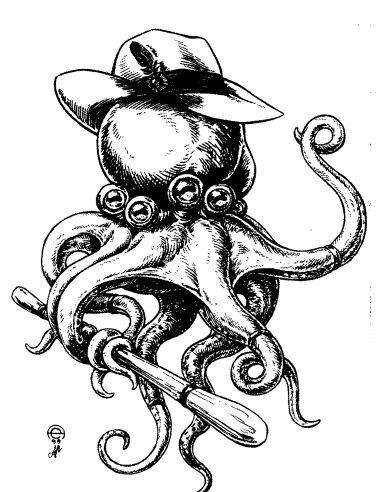
I love this fucker's jaunty hat
Orren
Skills: Cley Base, Magic Analysis, Magic Resistance, Meditation, Spontaneous Force, Kennoc, Life Base, Dance, Jump, Run, SWIM, Dodge, Disguise, Search, Flirting, Friendliness, Guile, Medicine, Music, General Knowledge, Languages, Law.
Seriously, every Orren is professionally skilled at swimming. It's the single biggest skill boost that any species gets.
Attributes: +2 to Agility and Wits, +1 to Stamina, -2 to Will.
Advantages
+4 Knack to Kennoc.
Fast: They're scampery bastards, +4 Knack in Run but only over short distances.
Shapechanging: Orren instantly turn into otters when in water, and back to humanoid shape on land. This is reflexive but controllable; not changing when you should is distracting, Trouble 2.
Pick Up Skills Quickly: If something new catches their interest, Orren learn very quickly. After character creation, if an Orren gains a level in a skill that was level 4 or below, roll a d20. On a 1-5, it wasn't that interesting. On a 6-15, they gain enough free experience in that skill for an extra level. On a 16-19 they gain two levels. On a 20, they gain two levels and a +1 knack and won't shut up about their new fascination for a few weeks.
Extra Experience During Character Creation: Pick one skill in each of the nine categories that you learned for fun. Roll a d20 for each: 1-5, get 5 exp. 6-15, 10 exp. 16-19, 15 exp. On 20, 20 exp and a +1 Knack.
Holding Breath: Orren can hold their breath for two minutes of frantic activity, or 15 minutes if they stay calm.
Hard to Hold, Easy to Stun: Orren are smooth and wiggly. That's a direct quote. Wiggly. Anyway, they're hard to hold when wrestling, but they're easy to knock out.
Wild Rush: If an Orren gets excited, they start acting quickly and carelessly. If sufficiently excited (As determined by the player or gamemaster), roll a d6 on each action. On a 6, the Orren starts rushing. They draw two initiative cards and choose the better for each action, acting sooner and more often than everyone else. On the other hand, they act carelessly, rolling three extra botch dice whenever a botch is possible. They also don't think clearly; "ideally" the player should stop planning entirely and just do the first thing that comes to mind, but if that's not appropriate then instead the orren just risks botching more often.
Resist or Enhance Shapeshifting: Mutoc Corpador spells cast upon the Orren can either be resisted or boosted more easily; they can add s20 to the Magic Resistance roll or s20 to the spell's power.
Rassimel
Skills: Cley Base, Concentration, Magic Finesse, Magic Resistance, Healoc, Life Base, Climb because I guess Rassimel covers squirrel people as well as raccoon people, Dodge, Ride, Pick Pockets, Search, Sleight of Hand, Friendliness, Stay Awake, General Knowledge, History and Literature, Judge Value, Languages, Natural Science, Social Knowledge.
Attributes: +1 to Memory and Wits, +2 to Dexterity.
Advantages
+4 Knack to Healoc
Quick Learner: Rassimel gain 1/3 more experience from adventuring.
Intense Study During Character Creation: Sometimes they really just can't think of a punchy name for these advantages, huh? Anyway, add 40 experience each to three skills of your choice related to your profession, adventuring career, or obsession.
Poison Resistance: Rassimel recover faster from slow-acting poison, reducing the strength of the poison by 1 every d10 minutes.
No Circadian Rhythm: So long as they get enough rest over the course of a week, it doesn't matter when they get it. Staying up three days straight and then sleeping the whole next day doesn't stress a Rassimel's body.
Need Less Sleep: This is represented by a special Rassimel-only "Stay Awake" skill.
Sleeth
Sleeth don't respect editors at all, so they put their template in a different order for no particular reason.
Attributes: +2 to Agility and Perception.
Skills: Cley Base, Concentration, Finesse, Magic Resistance, Meditation, Corpador, Mutoc, Ruloc, Brawl, Claws & Teeth, Life Base, Alertness, Search, Sneak, Climb, Dodge, Hunting, Jump, Running, Track, Storytelling, General Knowledge, History & Literature, Natural Science, Sleeth Silent Language
Sleeth seem to be the only species with no natural aptitude for flirting.
Advantages:
+4 Knack in Mutoc
+3 Knack in climbing and jumping.
+6 Knack in Sneak
Flexible Sleeper: Sleeth can fall asleep or wake up in an instant, and are aware of their surroundings while napping.
No Hands: Jaws, forepaws, and magic have to fill in for the good old opposable thumb. Sleeth can't use weapons, and they have to pass a skill roll to do things like work a doorknob.
Hearing and Smell: Sleeth have the same smelling advantage that Cani do, +5 bonus and they are able to make distinctions impossible for other primes. Sleeth also have keen hearing, the same +5 bonus.
Dark Vision: Sleeth have even better night vision than real cats. Only in the most extreme cases of absolute darkness or dazzling light do the Sleeth suffer even a minor -1 penalty; they can see perfectly fine in any lighting conditions in between.
Innate Ruloc Corpador: Sleeth can cast any Ruloc Corpador spell of Complexity-5 at will, with no cost of cley or skill roll required. The power is always minimal, Power 5, but that's enough to hold meat over a fire, steer themselves while falling, wrap a bit of leather around something, etc.
Solar Healing: If a Sleeth takes a nap in a sunbeam, they heal 1d6 life points per hour, on top of any other healing. Mechanical bonuses for being A Catte.

Natural Armor: +1 Soak, and a good thing too because additional armor for Sleeth is rare and expensive.
Natural Weapons: In combat, Sleeth can fight with claws and teeth, without suffering penalties for multiple "weapons." If grappling, they can also add in a third raking attack with their hind legs. Sleeth, like anyone using multiple light weapons, have trouble with armored foes.
Supple Body:
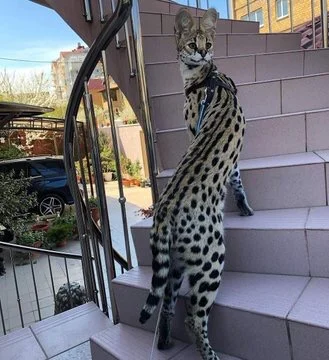
Seen As Monsters: Sleeth are commonly subjected to pretty shitty prejudice. They are usually shunned by civilized society, at best. Being friends with non-Sleeth (i.e. being part of an adventuring party) might shield you from the worst of it, but your friends will be expected to vouch for your good behavior.
Silent Language: A gestural language, mainly used for hunting, that usually only Sleeth bother to learn.
Zi Ri
Skills: Cley Base, Concentration, Feather Casting, Finesse, Hammer Casting, Magic Analysis, Magic Resistance, Magic Theory, Meditation, Spellbinding, Spellweaving, Spontaneous Force, Sustenoc, Claws&Teeth, Life Base (Zi Ri have a notable LOW Life Base score, only getting a single experience point in it by default), Climb (Why?), Dodge, Hunting, Alertness, Etiquette, Flirting, Guile, General Knowledge, History & Literature, Judge Value, Natural Science, Social Knowledge, Theology
Attributes: +2 to Agility, +1 to Memory, -3 to Strength.
Advantages
+7 Knack to Sustenoc. +7 is huge for a knack, but Sustenoc has fairly obscure usefulness.
+4 Knack to Magic Resistance
Flying
Natural Armor: +1 Soak
Armor Limitation: They don't make cute little dragon bardings.
Natural Weapons: Their needle-sharp claws and fangs make a skilled Zi Fi fighter just about the equal of a poorly equipped child of another species.
Weapon Limitation: They could maybe hold a small dagger if they try real hard.
Fire Breath: Zi Ri can breathe a short 4-foot-long jet of fire. This can be used as a weapon, but not a very good one.
Extra Starting Spells: Zi Ri get an addition 3+d6 spells of complexity-10 for free.
Fire Resistance: Zi Ri reduce all damage from fires by 6, to a minimum of 0 (unlike normal Soak, which can only reduce damage to 1.) This means they can sit in a cooking fire indefinitely, but won't want to stick around in a raging bonfire.
Meditation In Fire: If meditating to regain cley while sitting in a fire, Zi Ri get +3 to the skill roll, more if there's nice smelling wood or incense involved.
Unaging: After adolescence, Zi Ri stop aging entirely.
Immortal: Zi Ri do not die of natural causes.
As it turns out, Zi Ri actually kind of suck as adventurers. Who knew? The free starting spells are nice, but if you're making a Zi Ri you're probably making a spellcaster, and the professional spellcasting advantages tend to include the spells you want in the package anyway. If you're playing a campaign that spans centuries of game time, I guess you're golden, though.
Part 8: Attributes & Skills
Original SA post World Tree: A Roleplaying Game of Species and Civilization
Part 8: Attributes & Skills
This chapter is all about how to perform skill tests, and the rules are basically just repeated from Chapter 6 with a little more detail.
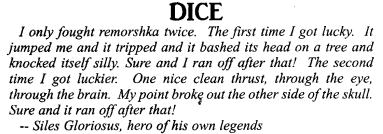
To review, die rolls are your basic roll-and-add-or-subtract system. Some die rolls are simple, and are written as d20 or d6 or whatever. Some die rolls are stress rolls, written as s20 or s6 etc., and this kind of roll is exploding (roll again and add if you roll the maximum amount), as well as risks botching. The one actual additional rule here is that if a single action involves multiple stress rolls, only the main roll actually risks botching. The example they give is rolling damage after hitting in combat. Even though they're two die rolls, since they're the same act then the damage roll doesn't create an extra chance of botching. This is a perfectly good example, with the minor tiny mistake that there actually isn't any separate roll for damage. In practice, any die rolls that don't include a risk of botching will be specifically labelled in the rules.
Also, you use the same rules even if the die is something bad. If you're rolling an s6 penalty die, then a 1 could botch, but a 6 could explode and give you an even higher penalty, so hope you roll somewhere in the middle.
ATTRIBUTES
The 10 attributes are a coarse description of your character's aptitudes. Unlike a lot of other stuff on the character sheet, these attributes aren't particularly diegetic. Just like in the real world, strength on the World Tree is made up of countless variables; how much you can lift, how often you can, if your grip strength in one hand is weaker than the other, etc. For the sake of playability, it just gets fudged together into a single number, and even that is a little slippery. In reality, "strength" is the "good at fighting" number, and all the definitions are tweaked to make that so.
There's no hard limit to how high or low an attribute can be, but for all effective purposes they stay within a range of -6 to +6.
Strength: Lifting things and hitting things. A dedicated fighter will probably have at least +3, unless they're a gimmick fighter.
Stamina: Endurance, vitality, and in particular survivability. Since there's no equivalent to saving throws, rolls that use your Stamina attribute are more common than Constitution rolls in d20.
Dexterity: Specifically manual dexterity, your ability to do things with your hands, tentacles, mouth, or whatever you work with. Primarily used in crafting and rogue arts, and also a factor in attack accuracy.
Agility: Full body coordination. This is good for dancing, climbing, jumping, and not getting shivved.
Perception: The strength of your senses, including both the traditional sight, smell, touch, taste, and hearing, as well as the World Tree specific magic sense.
Faith: This is kind of loose nomenclature. Faith doesn't refer to your belief in the gods. Rather, it's more like the strength of your innate connection to the gods. Useful for determining your cley supply, as well as dealing with gods and their agents.
Memory: Your ability to remember things precisely, as well as your ability to work with structured information. Bookkeeping might require memory, even though you're not really memorizing anything. Useful for pattern spells, which are the most common type of magic.
Wits: Your ability to think quickly and improvise. Useful for spontaneous magic and coming up with new ideas.
Will: Your ability to assert yourself. Highly useful when you need to concentrate, or when forcing yourself to act past your physical or mental limits. Also handy if you don't want to be mind controlled.
Charisma: It's charisma, it handles all your social needs. It covers both appearance and personality.
SKILLS
Another reminder of how skill rolls work. Attribute + Skill + s20, vs some threshold set by the gamemaster. The book specifically points out that the gamemaster usually won't tell you what the threshold is, which is a personal pet peeve of mine that I would like to indulge in some fist-shaking at.
SKILL ROLLS ARE AN ABSTRACTION OF THE CHARACTER'S EXPERTISE. PEOPLE USUALLY HAVE A GOOD IDEA OF WHETHER OR NOT THEY ARE LIKELY TO SUCCEED AT THINGS. HIDING THE ODDS JUST MAKES CHARACTERS UNREALISTICALLY INEPT.
Ahem. Moving on.
Skills aren't associated with specific attributes. Climbing something is usually an Agility+Climb, but looking to see what the best course up a cliff is might be Perception+Climb, choosing the best climbing gear might be Memory+Climb, etc.
If you don't have any points in a skill, you may or may not be allowed to attempt it, depending on what would make sense for that activity. Anyone can try to climb even if they're shitty at it, but if you've never even studied the God's Tongue there's no chance of translating it no matter how well you roll.
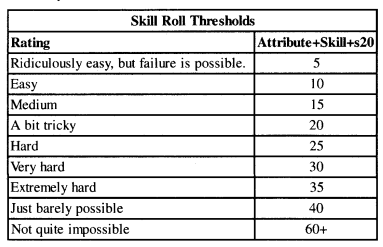
If you succeed by 30 or more, then you achieve a great success, and you get something more than just doing the thing you wanted. There's no guarantee that the extra thing is something you want, though. The example they give is a musician performing so well that someone in the audience becomes smitten with them. Handy if you're looking for a date, less desirable if your jealous spouse is also in the band. I think I would have preferred if this rule didn't invite the GM to punish players with success.
Sometimes rolls are opposed, instead of against a fixed threshold. Combat is the most common example, your attack roll vs. their defense roll. It does have an interesting option for contests without decisive results; if you're arm-wrestling and roll 10 points higher than your opponent, that's a decisive victory, but if you beat them by less than 10, you just have a temporary advantage. Make another opposed roll, adding the extra margin you rolled last time as a bonus to the second roll. It's kind of pointless faffing about, to be frank, but sometimes that can be fine for dramatic purposes.
If you fail at something, you may or may not be able to try again. If you fail a knowledge roll, then you don't know the thing and that's that. If you fail an Agility + Jump roll to leap over a chasm, then your next roll is probably going to involve Climb or Medicine. Sometimes you can just keep trying until you get it right, and the only cost is time, but the gamemaster might decide to apply increasing penalties to your rolls to represent frustration and fatigue.
Technically speaking, any use of a skill, no matter how trivial, requires a roll, but if it doesn't matter whether you succeed or fail, then the gamemaster should forgo the roll.
THE SKILLS
The full list of skills is just kind of slipped into the middle of the chapter without warning or preface.

Magic Skills
These are the various utility skills that support spellcasting, not the actual skills of casting spells (those would be the Nouns and Verbs). For various reasons, partly thematic and partly just to even out the skill groups, a few skills important to magicians are found in the crafting group instead.
Cley Base: How much cley you get per day, and also how many bound spells you can have at a time. Rarely used as an active skill roll.
Concentration: Included in this group because it's usually used for keeping control of a spell that requires active maintenance. This skill does apply to things like paying attention during a boring guard shift.
Feather Casting: This is for attempting to cast a pattern spell weakly, but without expending cley.
Finesse: Getting spells to behave exactly how you want them to, especially when the task is complex. For example, the power of a disguise spell (based on your Nouns and Verbs) determines how long it lasts and how hard it is to dispel, but your finesse determines how closely the disguise looks like you want it to look.
Hammer Casting: Attempting to cram extra cley into a pattern spell to make it go off with more power.
Magic Analysis: Attempting to study an active magic to determine things like its Nouns and Verbs, approximate power, and other non-obvious elements. Also useful for other metaphysical things, like being able to tell that a Gormoror has broken their word of honor.
Magic Resistance: Unlike almost every other skill, Magic Resistance is rolled alone, without adding any attribute, when you attempt to resist a spell. Magical resistance is an actual metaphysical part of you, like a wall of brambles around your magerium. Magic Resistance rolls are hard to succeed at: any half-competent mage will probably be casting spells with power of at least 20, and it takes a lot of Magic Resistance skill to have any confidence in success. Fortunately, there are a number of things you can do to boost your magic resistance.
Magic Theory: How well you understand the convoluted academic side of magic. Used for figuring out what arts are required to do something, being able to tell if it's possible at all, estimating how complex a spell will be, and planning out the best way to spontaneously cast a spell before making the attempt.
Meditation: This is used to take some quiet time and connect with the gods. Most of the time, meditating is done to regain cley. Sometimes you might want to try praying directly to one of the gods; this might give you an insight into whether that god approves of your actions. Most people don't really care what the gods think, though.
Ritual Magic: Some spells are very long, complex, and expensive, but also more powerful than a traditional spell. It's not uncommon for a professional mage to know a ritual, but it's also not required.
Spellbinding: The art of binding a pre-cast spell onto an object, to go off at some predetermined trigger.
Spontaneous Force: When casting spells spontaneously, this skill is added to the spell's power.
Nouns and Verbs
The 7 Verbs and 12 Nouns needed for casting spells are learned the same way any other skill is. We've already seen them listed once, and they'll come up again in the full chapter on magic.
Combat Skills
Each category of weapon is a skill. E.g. Edged Weapons covers everything from shortswords to three-handed swords. Weapon skills will get listed when we get to equipment.
Combat Stance Base: Usually not rolled against, CSB determines how far you change your stance to be aggressive or defensive, and also determines how many combat options you have.
Life Base: Your ability to not die. This is a skill that's learned, studied, and trained like any other. There's a few rolls that use your life base, like rolling Stamina + Life Base to resist getting knocked out when someone clonks you upside the head.
Athletics
Climb: This skill is often unvalued in fantasy games, but when you live on a literal tree it's pretty darned useful. Especially since a lot of the adventure out there exists on the Verticals...
Dance: The existence of dancing as its own skill tells me that the designers really wanted social encounters to be a major aspect of the game. It's hard to imagine your success at dancing mattering often enough to justify putting any effort into increasing this skill. Most likely if your character is good at dancing, it's because the background advantages you chose gave you some automatic points in it.
Dodge: The primary contributor to your defense roll. This is something every character is going to want.
Hunting: Finding prey, knowing what to do when you've found it, and preparing it once it's dead. If the prey is something capable of fighting back, then some of the steps in the middle will be a matter of combat skills.
Jump: If you can't fly, this might be the only way across one of those chasms that adventurers keep running into.
Ride: Low skill is enough to sit on a well-trained animal and do normal things. Higher skill lets you ride exotic or half-trained animals, take them into battle, etc.
Running: Both sprinting and long-distance running. Over a short distance, you can add (5+Running)x10% to your walking speed, so a Running skill of 5 means you run at double your walking speed. The table of walking speeds gets squeezed in here, because why not I guess. It's got some amusing entries.
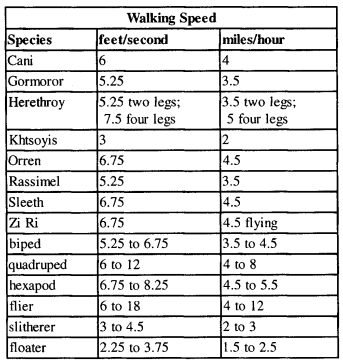
Swim: Swimming. That's it, that's literally the description in the book.
Track: Following people. If you're Cani or Sleeth, you get to add your smelling bonus to the roll.
Rogue Arts
These skills aren't inherently illegal or immoral, but they tend to be at least kind of sketchy.
Alertness: Noticing things you need to notice. This often gets used as an opposed roll against someone else's sneaking.
Disguise: Also includes acting, any attempt to appear to be not yourself.
Forgery: This is a rare skill, but that means most people don't think to suspect it. Forging a signature from a good sample requires a roll of 15, to give a baseline of difficulty.
Make/Pick Locks: https://www.youtube.com/watch?v=pRva7z8pvwc Locks on the World Tree are pretty pathetic by earth standards, most people prefer magical security.
Pick Pockets: Useful when you don't want to bother someone by asking to borrow their stuff.
Search: Where alertness is for spotting something happening, search is for finding something hidden, or at least misplaced. One search roll represents about 10 minutes of actively searching.
Set/Disarm Traps: Disarming a trap usually requires two rolls: Perception + Disarm to identify and understand the trap, Dexterity + Disarm to actually disable it. Failing to disarm doesn't set it off unless you botch. Traps could be anything from simple snares to full fledged Indiana Jones setpieces, possibly with magical components to complicate the process.
Sleight of Hand: Stage magic is actually a well appreciated skill on the World Tree: the audience will be carefully examining you with magic sense to be sure that you're not cheating by using ACTUAL magic like some kind of scrub. I guess you might want to use this to swipe something off the duke's desk without him noticing if you're a criminal or something.
Sneak:

Social Skills
Bargain: Getting better prices for buying or selling something.There's no particular guidelines for how much of a benefit this skill can get you, so it's up to GM-fiat.
Command: Getting people who are supposed to do what you want to do what you want. You get +5 to commanding a Cani that's loyal to you, and you get -5 to commanding a Sleeth or a Zi Ri because they're not loyal to shit. Inspirational speeches or promises of bonus pay could be worth a bonus to the roll.
Empathy: Understanding the emotional state of someone. You get a +3 bonus to understanding people of the same species, and Cani are particularly easy to read because they wear their hearts on their tails. This isn't exactly reliable, but mind-reading magic is universally reviled.
Etiquette: Navigating the confusing and arbitrary laws of social engagement. This covers everything from knowing which fork to use at dinner to knowing just the right turn of phrase to start a bar fight.
Flirting: THE UNIVERSAL SKILL. Covers getting appropriate people interested in you, and following through when you succeed. In general, a successful flirting roll will get a reaction, but what the actual reaction is depends on the person; a faithfully married person might react with shame and refusing physical contact.
Friendliness: Generally covers being chatty and nice with people.
Guile: Useful for all adventurers, and particularly useful for thieves, merchants, and politicians.
Interrogate: Getting information out of someone that doesn't want to give it to you. The skill description kind of dances around the idea of torture without actually mentioning it.
Intimidate: Getting someone to back down with the promise of violence, instead of actually having to use violence.
Crafts
There's myriads of possible craft skills that aren't specifically listed. If basket-weaving is important to your character, just write in basket-weaving.
Animal Handling: Taming and training animals, as well as basic veterinary medicine.
Armor Repair: Your armor getting messed up is actually a fairly common situation, especially against foes intelligent enough to have combat skills. Restoring one point of soak requires proper tools and d20 minutes of work. Metal armor is harder to patch up than non-metal. Actually making armor, smithcraft, is a different skill.
Enchantment: The rare, esoteric art of making magic items. Most players will never touch this, the required investment in terms of resources, skill, and time is very very high.
Medicine: Curing the sick and injured. Usually this is performed with magic; healing spells generally work better with a higher medicine skill. Injuries can be treated non-magically, but it's harder and takes longer. Illness is actually fairly rare for primes; there's only a few actual diseases and they're easily treated with simple magic.
Music: They suggest that if music is important to the campaign, then each instrument should be a distinct skill, and now I'm curious what the playtest game that inspired that idea was like.
Spellweaving: The art of constructing a very complicated but very weak spell. A rare skill, not useful for novices.
Wilderness Survival: Building shelters to stay warm, knowing what mushrooms won't kill you.
Woodworking: A humble skill, but fantastically useful on the World Tree where the most common useful resource is wood. Covers whittling, carpentry, and even a bit of architecture.
Knowledges
God's Tongue: The language of the gods is completely unrelated to any other language on the World Tree. Scholars like to write complicated texts in this language because it makes them seem more prestigious.
Judge Value: The art of knowing how much something is worth, both intrinsically because of what it is, and extrinsically because of fame or other factors.
General Knowledge: A catch-all of non-specialized information. Skill level of 3 includes basic literacy.
History and Literature: Grouped together as a single skill because they're the components of a liberal arts education. Fair enough.
Natural Science: Mostly biology and astronomy. Can fill in in a pinch as herbalism if your medicine skill isn't up to the task.
Languages: Most languages on the World Tree are somewhat related, and being good at languages in general means you'll pick up a new language quickly. Languages from off the World Tree are rare, and not covered by this skill.
Law: A tricky skill, because laws vary wildly from place to place, and are rarely very well codified. This skill is as much knowing how to handle the local officials as it is knowing the actual laws.
Teaching: Necessary for passing your knowledge on to others. In particular, you need this to teach advanced topics to novices.
Theology: Information about the gods. Myths and history have a lot of overlap on the World Tree, and there are many many different approaches to theology to keep straight.

Another mostly redundant section. Knacks are a bonus to any roll involving that skill. Knacks are hard to gain or lose in play. Orren occasionally pick up minor knacks, and gods might grant knacks as a reward for great deeds. Knacks are inherent to the spirit, and persist even after death. If you have a knack in Pyrador, you might have done something to please Flokin in a previous life.
Experience and Training
During play, experience is gained in various ways. Each group of skills tracks experience separately. Experience is spent from a group's pool to improve skills during play the same as it was spent during character creation; each point of a skill costs as many experience points as the number you're raising to. Increasing a skill from 0 to 1 may require you to seek out a trainer, or at least have a really good primer to learn from.
Adventuring is the fastest way to improve skills, which might be your character's entire motivation to go on an adventure. Each game session gives you some experience in every category that you used at all in that session, no matter how trivially. If you're nice to the groom that tends your horses at the inn, that's good enough to get some experience even if you never actually made a friendliness roll.
After a normal length session (a couple hours), the gamemaster will tell you to add something like "5 points to one category, 0-3 in the others." You get 5 points in the single category you used the most or learned the most about, 3 points in any categories you used a lot of, 2 in categories you used repeatedly, and 1 in categories you used at all. Ideally, the players can be trusted to judge this for themselves.
On top of those points, the gamemaster might hand out extra d6s worth of experience as a reward for succeeding at goals or for notable achievements. A typical session is worth about 3 d6s per player. The gamemaster might require these d6s to go in specific groups, or even into a particular skill.
Even when not adventuring, everyone gets experience just from daily usage of skills. Every 3 months, you get a small increase in experience; d6 each in 3 pools, and 1 point each in 3 other pools. After 40 years of age, this decreases to d6 in 1 pool, and 1 point each in 3 other pools.
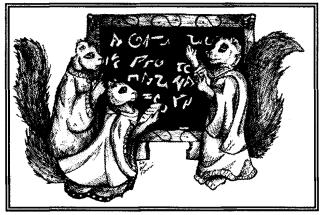 What are these weird squirrels even
What are these weird squirrels evenChildren gain a lot of experience very quickly from education, but that phase of life is over by the time play starts so there's no particular rules for it. Adult education is still effective, but not as dramatic as adventuring. To learn a skill, the teacher needs a higher skill than the student. Unfortunately, being expert at a skill doesn't mean you're good at communicating the basics: you can only teach someone that's at least half your level in that skill. Every level of teaching you have reduces the minimum level of the student by 1.
A week of devoted study to a topic is usually worth 1 experience, and a person could study as many as 5 topics if they don't mind missing out on sleep. There might be other costs besides time and tuition; studying magic will probably cost 8-12 cley per day. A good teacher can give better returns over a long period of time; adding (2xteaching)% to the experience gained.
Part 9:Combat
Original SA post World Tree: A Roleplaying Game of Species and Civilization
Part 9:Combat


Ah, combat, the meat of most RPGs. The start of the chapter presents the expectations of the game: that the 'stand there and hack at each other until hit points are depleted' model of combat is actually how it works in setting and everyone knows it. Since life is a combination of body, mind, and spirit, and killing someone requires damaging them until that connection breaks, subtle and skillful attempts to kill someone just don't work.
In D&D, there's no reason why according to the rules you can't kill an experienced sentry with a single crossbow bolt if his hit point total is higher than your damage output. It's entirely a game contrivance. In World Tree, you can't kill someone with a single arrow because that's not damaging enough to be fatal by itself no matter where the arrow hits. There's no such thing as a vital organ. Everyone knows this, and this shapes how fights take place.
In practice, since you can't one-shot most enemies, then winning a fight comes down to two things: outperforming them in the damage race, and finding ways to hamper their ability to fight. An arrow through the eye might not be fatal, but it's still blinding and painful, and that might be the edge you need.
Initiative
Like mentioned earlier, initiative is based on cards, going Ace through King and then looping around again. Each time you take an action, you draw a new card to see when you'll go again, so turn order isn't perfectly cyclical. If you want to, you can just roll d12s instead of drawing cards.
Spells, at least the kind that are useful in combat, usually go off either on the action you cast them (normal for defensive spells), or they "build", which means they draw their own initiative card to see when they take effect (normal for attack spells.)
Sometimes you'll get a bonus action, such as from the spell Quick Instant. In this case, you draw an initiative card for the bonus action, and keep it distinct from your regular action. The card for your regular action gets replaced after you use it, the card for your bonus action does not. If it so happens that you get a bonus action on the same initiative as your regular action, bump one of them one point later.
If two people have the same initiative, they perform their actions simultaneously. Resolve them in whatever order is convenient, but neither can directly affect the other. This can lead to cross-counters and double KOs.
If some effect has a duration, like a spell that lasts for 5 actions, then you just draw that many actions and form a little pile, discarding the top card each time its initiative comes up. When all the cards are gone, the duration has elapsed.
It's a little clumsy, but I still like this system, as far as individual initiative systems go. It's pretty dynamic, and while it does rely on the players actually paying attention, since they know what initiative number they'll be acting on, they should be ready to jump in as the cycle gets around to them. Also you can just leave your initiative card face up so everyone can check on you, and make fun of you for forgetting the number 3.
Actions
The action economy is extremely simple in this game. On your action you can do one thing. You can make an attack, cast a spell, run a modest distance, or do something of equivalent time and attention. In addition to your action, you can take a few steps or some other minor activity. If you don't want to do anything on your turn, you can pass, but there's no option to delay your turn.
Outside of your turn, there's very few things you can do. You can say about a sentence's worth per initiative, or you can react to some sudden surprise like the ground dropping out from under you.
If you want to, you can ready an action to happen outside your initiative, like shooting the first person that walks through that door. This doesn't automatically work, you have to pass a Perception + Alertness > 20 roll to successfully do it, and an even harder test to change your mind if the wrong the person runs through the door. This is certainly a lot clumsier than the delay/ready actions in d20; the difficult rolls to pull off a readied action suggest to me that one of the playtesters really abused the option somehow.
Life Points and Trouble

Life points are a real, measurable thing on World Tree, give or take a conversion factor for gameplay purposes. In theory it would make perfect sense to have 10.84 life points, but for game purposes only round numbers are used. Your maximum life points is 3x(Stamina+Life Base), but never less than 1. A regular person will probably have around 20, a hardened warrior will have quite a lot more.
Trouble is all the non-damaging but inconvenient stuff hampering you. Being tied up, blinded, badly wounded, hamstrung, etc. Trouble is a single number representing your total suckiness. Trouble 1 is a mild inconvenience, 10 is serious, and there's no upper limit. If you have Trouble from multiple sources, they add together, although the GM might decide there's diminishing returns if there's overlap.
Trouble is a straight penalty applied to most rolls. Skill rolls, attack rolls, defense rolls, spell-casting rolls, etc. Trouble doesn't affect Soak, and it doesn't directly affect damage other than modifying your attack roll. Also, Trouble affects the chance and seriousness of botching; you roll an extra botch die for every 2 points of Trouble whenever you risk botching.
If you fall below 0 life points, you're incapacitated; alive but unconscious. Your spirit has to devote 100% of its efforts to hanging on to your body, and you'll need medical attention to recover. If you're brought back above 0, you have to spend an action to recover your wits, probably another action to stand up again, and you'll have Trouble 2 until you can rest for at least an hour.
If you fall below -(Will + Life Base) life points, you're dead. Almost. Death is not instantaneous, no matter how badly damaged you are; it takes about three seconds for the spirit to disconnect from the body. If you're healed above the threshold of death within 3 initiative points, you won't die, but you'll also be feeling it: Trouble 6, reduced by 1 point per day of no strenuous activity. This is one of the ways that bound magic is a HUGE boon for primes: A healing spell can be bound to go off on the condition "When I die, heal me", which guarantees the healing will occur in time to prevent death.
If you're not healed in time, fixing you takes a lot more work. First, the body has to be healed enough that you won't just immediately die again, and then you need difficult magic to call the spirit back and reattach it. This needs to be done quickly, after about 2d6 minutes the spirit will give up and float back to its creator god.
Combat Overview
Combat basically involves an attack roll and a defense roll for each attack. Here's the process:
1-Attacker declares goal and combat options (if any)
2-Defender declares options (if any)
3-Attacker makes an attack roll, which is Dex + Weapon Skill + Weapon Modifier + Stance + s20. This can and should be pre-computed.
4-Defender makes a defense roll, which is Agil + Dodge + Armor&Weapon Modifiers - Stance + s20. This can and should be pre-computed.
5-If Attack is less than or equal to Defense, the attack misses. Note that defender wins ties, which is slightly different than normal skill rolls.
6-If Attack is greater than Defense, the attack hits and you calculate damage. For every 10 points the Attack beats the Defense by, you count a triumph.
7-Calculate damage: Weapons base damage + Each triumph adds the weapon's damage increment to the damage
8-Subtract all the defense's Soak from the damage, but all successful attacks do at least one damage.
Weapon skills
Weapon skills are grouped into categories, not individual weapons.
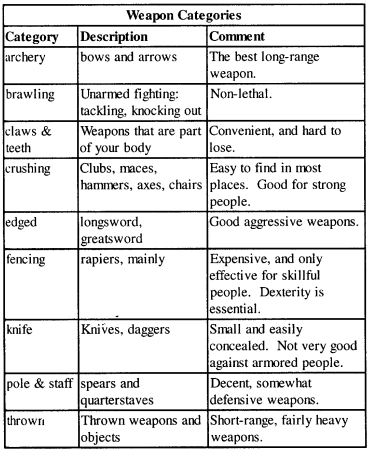
Dedicated thrown weapons, like javelins and tomahawks, are rare, so the skill is more useful for throwing rocks and bar stools and things like that. Brawling has a whole bunch of special rules associated with it.

A lot of fantasy staples on here, but there's a few interesting entries.
Meng weapons are made from a kind of common hard nut. They're almost as good as a real weapon, and a LOT cheaper.
A Jag-weapon has a bunch of impractical hooks and spikes and stuff sticking out of it that make it less useful as a killing device, but does help you do certain combat tricks better like tripping and disarming.
Serpent rapiers are rapiers enchanted to be stiff when thrust and wiggly when waved around and god this game sounds filthy sometimes. They're hard to use and expensive, but useful for fancy fencing tricks.
Spears are particularly good at counterattacking, even if you don't have the combat option unlocked. Staffs are very useful on defense, about as good, or better, as holding a metal shield.
Only Herethroy can use three-handed swords; no other prime has the leverage to manage it. Also, I'm not sure what the actual, you know, geometry of waving a sword three-handed would even be.
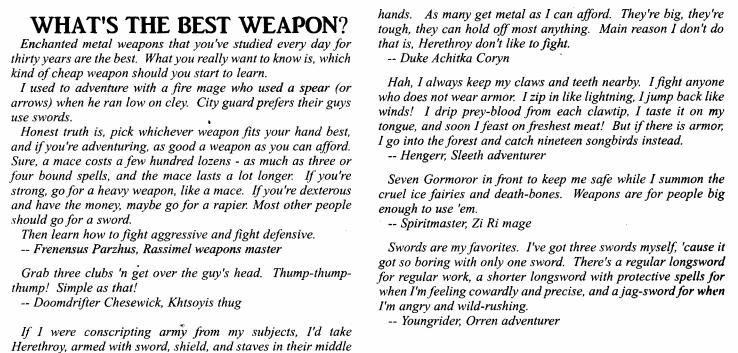
Surprise, the Zi Ri's an asshole
Armor
Armor is straightforward, and adds to both your defense and your soak, depending on the type. None of the armor types are particularly interesting or worth pointing out, except to mention that even a cheap wooden shield offers a large bonus to defense and is worth having even if you're not skilled with it.
Combat Options
This is the real meat and marrow of the combat system. Without combat options, hand to hand combat is just a matter of rolling to hit and damage, with no decisions to make. That might be acceptable for d20 but we can do better! For each level of Combat Stance Base you have, you unlock one new combat option, or upgrade an option to expert level. These options give you actual meaningful decisions to make during your turn, even though World Tree isn't exactly a hardcore tactical game.
Whenever you attack (or in some cases defend), you may mix and match any or all combat options that make sense. It might not make sense to disarm and stun at the same time, but hitting precisely, pulling your punch, and subduing all at the same time to settle down a rowdy drunk is fine.
Generally, options come with a benefit and a drawback. One neat convenience is that any bonus dice will be d20s or d12s, while penalty dice will always be d10s, so you don't have to remember or mark which dice are positive and which ones are negative. Many times, even though bonus dice are stress dice, they don't have a chance to botch, those are marked with {NBD}.
If you're expert in an attack option, you get an s12 bonus to defense rolls against people using that option against you, and similarly you get an s12 attack bonus against people using a defense option you're an expert in.
The combat options are learned in order; each time you get a new one you get the next option in line. If the gamemaster doesn't mind the extra complexity, you can optionally skip ahead a little, so long as you backfill skipped options within a few levels of CSB.
1-Vary Combat Stance. The basic decision to make every action. You can set your stance as high as your CSB to go aggressive, or as low as negative your CSB to go defensive, applying your stance as a modifier to all attack and defense rolls. Since you can see what initiatives are out there, you can decide how much you want to defy danger. Expert: Each time you defend, you can change your stance by up to 3 (usually getting more defensive)
2-Pull Punch: Choose any amount before attacking to reduce your damage by. Expert: You can decide the amount after rolling the attack.
3-Active Shield: Instead of the fixed +6/+10 Defense for a wooden/metal shield, roll s12/s20. Archers can't use active shield even if they have enough hands, and Sleeth can't use shields at all so they just skip this option. Expert: Get an extra s12{nbd} Defense
4-Wild Parry: Add either +2s20{nbd} Defense or +2s6{nbd} Soak during one point of initiative. This always risks botching, and rolls 2d6 botch dice no matter what your Defense dice were. Expert:3s20 Defense, 3s6 Soak, or both 2s20 Defense and 2s6 Soak.
5-Wild Attack: Add either +2s20{nbd} Attack or +2s6{nbd} Damage to an attack. Always roll two botch dice, no matter what your Attack dice were. Expert:3s20 Attack, 3s6 Damage, or both 2s20 Attack and 2s6 Damage.
6-Hit Hard: Subtract 2s10{nbd} from Attack to add +s6{nbd} to damage. If your weapon has a damage increment of 4 or more, add +2s6 damage instead. Expert:Add +s12{nbd} to Attack (in addition to the 2s10 penalty, sometimes you just roll buckets of dice)
7-Careful Retreat: Fall back d12 feet to gain +s12{nbd} to your Defense. If you bump into something while backing up, you suffer a -s10 penalty instead of the +s12{nbd} bonus. Expert:Add an extra +s12{nbd} to your Defense when retreating
8-Hit Precisely: Add +s20{nbd} to your Attack, but subtract s6 from damage. Expert: Add an extra +s12{nbd} to your Attack.
9-Hinder/Drive Back: Two options in one, decide if you're trying to hinder or trying to drive back your opponent when you make the attack. If the attack is successful, the defender can choose to accept the hindrance or be driven back, in which case the attack is avoided. If the defender accepts getting hit instead, they suffer +s6{nbd} damage. If hindered, the defender suffers d6 Trouble (+d6 per Triumph) until the end of their next action. If driven back, the defender backs up d6 feet (+d6 per Triumph). If the defender can't back up, this is free damage. Expert
 ouble the distance or Trouble, or if they take the hit they suffer an additional +s6{nbd} damage.
ouble the distance or Trouble, or if they take the hit they suffer an additional +s6{nbd} damage.10-Tighten Stance: When being attacked, you can attempt to roll Agility + CSB > 30 to reset your stance to neutral. It doesn't help on that attack, but it might help against the next. Expert: If your roll is at least 40, you reset to neutral BEFORE the attack instead of after.
11-Prepare Attack: Give up your attack on one action to gain +s20{nbd} Attack on the next action. You must be in a neutral stance. Expert:You can prepare up to three actions in a row, stacking up to +3s20{nbd} Attack when you finally go ham.
12-Break Armor: Reduce the Soak value of the enemy's armor, hide, or chitin. A successful attack does -s6{nbd} damage, but reduces the enemy's Soak by 1. This combat option is why the armor mending skill is actually very valuable.Expert: Reduce enemy's Soak by d3 instead.
13-Multiple Weapons: Fighting with a weapon in each hand. Designate one weapon as your primary weapon. Every weapon you use beyond the primary applies a penalty to attack and damage to ALL attacks. Small weapons have a -5 Attack and -1 Damage penalty, large weapons have a -15 Attack and -3 Damage penalty. Make a seperate attack with each weapon, you can usually only use combat options on one attack. Expert:Small weapons no longer cause an Attack penalty, large weapons are only -5 Attack. Damage penalties are unchanged.
14-Careful Parry: Get +s20{nbd} on all remaining Defense rolls until your next action, or +s6 on all Soak, but suffer -2s10{nbd} on Attack rolls on your next action. Expert: Get an extra +s12{nbd} on Defense rolls
15-Cripple: Try to inflict a painful or hampering wound. Attack at -10, and deal -s6{nbd} damage, but inflict d6 Trouble in addition to damage. This Trouble will last until the injury you inflicted is healed. Expert: Attack bonus of +s12{nbd}
16-Force Opening: When you're being attacked, you can risk suffering +s6{nbd} damage (if the attack hits) in order to gain +s20{nbd} on your next attack. Can only be done while neutral or aggressive. Expert:You can stack up to three forced openings.
17-Counterattack: Instead of defending yourself, try to squeeze in an extra attack. Suffer a -3s10{nbd} penalty to your Defense but immediately perform an attack with -3s10{nbd} to Attack. Expert:+s12{nbd} to both Attack and Defense
18-Disarm: Roll to hit as normal. If successful, make a disarm skill roll, Dex + Weapon Skill +s20 > Defender's Dex + CSB + s20. If the disarm roll fails, you hit with a -s6{nbd} penalty to damage. If the disarm roll succeeds, the defender must choose to either drop their weapon and avoid the attack, or hold on to their weapon and suffer a hit at +2s6{nbd} damage. Expert:If the disarm roll is unsuccessful, there's no damage penalty, and if the defender chooses to hold their weapon the bonus damage is +4s6{nbd}
19-Feint: After your opponent chooses defense options, you can attempt to change your stance and combat options. Subtract s10{nbd} from your attack, and roll Dex + CSB +s20 > 30. If this succeeds, you can change your options freely. This works best against opponents with meaningful defensive options, and works poorly against newbs. Expert: +s12{nbd} to your feint roll.
20-Subdue: Take -s10 to your Attack to make 2d4 x 10% of the damage temporary. After s6 hours, subdual damage heals. Subdual damage can incapacitate, but not kill. A botched subdual attack usually means that you do real damage instead. Expert:Roll the dice for recovery twice and take the better of the two.
21-Mighty Blow: Add your stance base to your Attack again, and deal +2s6 damage. The damage dice DO risk botch rolls. After performing a mighty blow, you may not change your combat stance until after your next action. Expert:+s6 damage, or +s12 Attack.
22-Sweep Weapon: Try to hit multiple people with one attack. Each target beyond the first must be in reach, and gives a penalty of -s10{nbd} Attack to each attack. Expert:+s12{nbd} Attack on one attack.
There's a few other little details to combat. If your attack beats defense by at least 30, then you score a critical and basically can apply the effects of a combat option for free, even if you don't know it. There's also a few examples of non-standard actions, like throwing dirt in someone's face (give them Trouble 2 for a couple actions), leaping off a table and swinging your sword wildly (+5 Attack, a bunch of extra botch dice, succeed at a jump roll or fuck you, if your opponent has a spear than double fuck you) or sneak attacking a sleeping Sleeth (The Sleeth hears you and wakes up.)
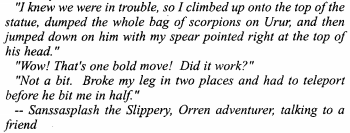
Part 9:Combat cont'd
Original SA postHey speaking of good organization and layout it's
World Tree: A Roleplaying Game of Species and Civilization

Part 9:Combat cont'd
Of course we're not done with combat yet. There's about half a page describing different characters' fighting styles, and it gives a good demonstration of how to use species, skill, and situational advantages to make the most tactically out of a grid-free combat system.
There's a Gormoror warrior with a good, heavy weapon. She knows that regular damage isn't likely to stop her; he's got a lot of life points and Gormoror can keep fighting even after they should be dead, so she can rely on a fully aggressive stance that's likely to hit and do extra damage, more or less ignoring her defenses. And in a situation where normal aggression isn't enough, she has options to risk going VERY aggressive and hope to take down a threat in a single blow (and probably get chewed apart if she fails, but nothing in life is certain.)
The Rassimel weapons-master doesn't have any real natural advantages, but he does have a shit-ton of skillpoints in Combat Stance Base and his favorite weapons. He prefers to start with a neutral or defensive stance, and lean on his skills that give the opponent Trouble and/or damage their armor before moving in for the kill once they're hampered. It helps that he's got a mage buddy to ALSO toss annoying spells at his enemies.
The Cani town guard just wants to get home to his wives and husbands and kids. If the guard is mustered to chase a monster out of town, they always go in a squad (to get the Cani loyalty bonus), always make sure to be fully geared up, and do whatever it takes to not die. The guards up front will take very defensive stances with shields or staves, while the guards behind them will poke out with spears to Hinder and Drive Back the monster until they get it safely outside the walls.
The Sleeth bitches a lot about how having three deadly-but-small weapons isn't super effective against a monster with a thick carapace, so she picks her opponents very carefully and is otherwise very familiar with running away.
Brawling
Mano a mano combat isn't a very scientific fighting style on the World Tree. Sorry, no monk equivalent. If you want to defend yourself without lugging a weapon around, combat magic is cheaper and easier than trying to invent martial arts that can handle the bewildering array of body types. Good luck getting a joint lock on a Khtsoyis, jiu jitsu guy.
Still, not every disagreement leads to armed combat, and sometimes punches get thrown. The hand to hand combat system is actually quite a bit more robust than d20's was, and reminds me a bit of a more thought out take on AD&D 2e's brawling rules.
In general, brawling moves are rolled just like attacks, but they do little or more damage. Instead, you're trying to achieve some particular effect. I.e, you're not (usually) trying to straight up kill your enemy, you're trying to knock them out, or silence them, or whatever.
Whenever you attempt a brawling move on someone, you have to get close enough to lay hands on them, and that's not safe. If they're armed and ready for you (you didn't surprise them), they get a free attack on you as you move in and before you attack. If they're unarmed or don't want to stab you, they can perform a brawling move back at you, but only after your brawling attempt and only if yours didn't work.
Because every prime has a different body type, different moves work more or less well against different species, often with very large bonuses or penalties.
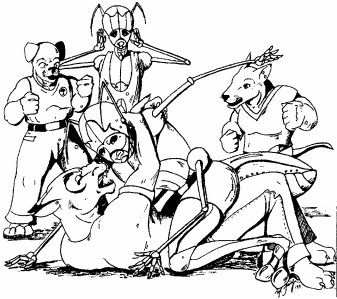
Things you can do with your bare hands include:
Waylay/Knock Out The ancient TV art of knocking someone out with a single blow. Much, much easier if they're not aware of you. Orren and Zi Ri are easy to knock out, Zi Ri and unarmed Khtsoyis aren't very good at doing the knocking out. It's also harder to knock out someone wearing a helmet, but having a blunt object helps.
Hold Arm Basically if they were intending to do something you don't want them to do with that arm, like stab you. Sleeth just straight up can't do this because I guess they're not allowed to hold someone's wrist in their jaws. Orren are hard to hold on to, and Zi Ri are bad at attacking and defending. Actually you know what, Zi Ri suck at all the brawling moves, let's just assume they get -10 to everything unless otherwise stated.
Dirty Blow Hitting, kicking, or poking somewhere in the no-no zone. This hurts a lot (Trouble 10) for a number of seconds based on how well the attack succeeded. Mammalian females have slightly fewer vulnerabilities, so they get a bonus to defense. Herethroy are armor plated, which is equally as effective. Gormoror are genetically predisposed to avoid dirty blows, and get -10 to the attempt.
Throw/Tackle If you do it from a standing start, it's a throw, and if you get a running start it's a tackle. Either way, you're trying to get the target to lay down and possibly drop the ball whatever they were carrying. Gormoror and Herethroy are naturally good at this, both on offense and defense. Khtsoyis can throw but they can't tackle, and they just straight up can't get thrown or tackled. Orren continue to be wiggly, which helps on defense. Sleeth can't throw or tackle, but they get a completely unjustified +20 to defense.
Pin Using your weight to keep someone from moving. If you're pinning someone, all they can do is try to get out, or try to engage in close combat. In either case, while you've got them down they're at -10 to just about everything, and you're at -5 to also just about everything.
Silence Covering the target's mouth so they can't talk or yell. This notably does NOT prevent spellcasting, but it does give them a little trouble, and it keeps sentries from calling the alarm. If you fuck up the attack roll, your target gets a free bite attack because your hand is right there.
Wrest Weapon Straight up yanking the weapon out of someone's hand. Presumably not by the blade. If you succeed, there's a 1/4 chance you're holding it now, otherwise it's dropped to the ground.
Bother Warrior Poking, pushing, grabbing, and otherwise harassing the opponent to get in their way without hurting them. They do still get a free attack against you, so this works best on people that don't actually want to kill you, like when you want to stop a teammate from killing someone you think you need to keep alive. Orren are good at being annoying, but also easily distracted, they get a bonus on offense and a penalty to defense. Cani, Rassimel, and Sleeth are hard to distract. Zi Ri for once don't have any penalties to this. They can be just as annoying as any other species!
Tie Up/Gag You need a rope or equivalent for this. Each successful binds up one limb of the opponent, so you need to succeed four times to hogtie most people, six to tie up a Herethroy. This is a lot easier to do if you've already got someone pinning them down. It's basically impossible to tie a Khytsoyis up, but gagging them is normal and often appreciated. Orren continue to be slippery, and get a huge bonus to defense.
Get Away If someone's used some brawling move on you and you want to not be held anymore, you can try to get away. The more successful the attack that grabbed you was, the harder it is to get out of.
Jump On This is where the brawling rules and the regular combat rules intersect. Jumping on to someone means that you're now both engaged in close combat, kicking and a' gouging in the mud and the blood and the beer. Only weapons that specifically work in close combat work for this; claws, teeth, and knives. Sleeth love getting into close combat, it lets them use their powerful hindleg rake attack. While in close combat, you're -15 to defense, but anyone that tries to attack you and misses might hit the person you're grappling instead. Gormoror and Khtsoyis are big and/or slow, so they're easy to jump on. Orren are still slippery and hard to catch. Sleeth are specifically built for this, and get a bonus on offense and defense.
Poison
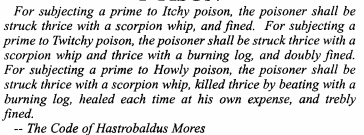
Poison generally comes in two varieties; the kind that kills you and the kind that just fucks you up. The kind that kills you generally works too slowly and unreliably to be useful in combat, so if you're going to be That Guy and poison your weapons, you want the kind that causes Trouble.
Combat poisons generally don't have any kind of resistance roll. If you're poisoned, you're poisoned. Slow acting poisons do let you roll your stamina and strength to try to and recover faster.
Combat poisons aren't specifically listed by name. Instead, they're sorted into various categories of what they do, and the gamemaster can just make up a name for whatever kind of poison you just got stabbed with. The strength of a poison is some arbitrary number N, used for determining various mechanical effects.
Itchy poison is cheap and common, often found as a defense mechanism of planets, animals, and monsters. It causes N Trouble based on the strength of the poison, up to a maximum of 10, which wears off at about 1 point per hour.
Fever poison also causes up to 10 Trouble, but wears off much more slowly, and could even get worse. Every day, roll your stamina + d20, and on a high enough roll the trouble is reduced by a few points, but get a 10 or less and the Trouble increases by 1. Medical care can help give a bonus to your roll.
Harm poison makes you possibly take damage on your next N actions. If you fail a relatively simple stamina roll, you suffer s6 {no botch dice} damage. Probably not a big deal, but if you're unlucky you could be surprised by a big hurt.
Twitchy poison gives the victim some kind of periodic strong, uncontrollable tic, twitch, spasm, or similar. Most Twitchy poisons cause Trouble 5 on the rounds they go off. Stronger Twitchy poisons might make the victim attack themself, or even uncontrollably cast a spell. The poison usually lasts for N minutes, causing a tic every 2d6 or so actions; more often for stronger poison, less often if you have more stamina.
Howly poison makes the victim stop every d6 actions and just howl in pain uncontrollably, suffering s6 damage and doing nothing else, lasting for N howls.
Paralysis poison instantly locks the body up; the victim has to pass a Will + Stamina > 2N roll to do anything at all on each action, and even then suffers Trouble N. This lasts for about 2-8 hours. Paralysis does not hinder spellcasting at all, though. This seems like the kind of poison a monster would have, but none of the sample monsters in the appendix have it. Or any kind of poison besides Itchy, for that matter. Hunh.
Weakness poison just reduces the victim's Strength by N for N hours.
Slow Death poison doesn't do anything to help during a combat, but 11-N hours after being poisoned the victim starts suffering d3 damage every hour until cured or dead.
Other kinds of injury
There's lots of ways to hurt yourself besides getting into a fight. Most kinds of injury are reduced by Soak and other defenses as normal.
Fire does a modest amount of damage for every action spent in the fire. A candleflame does 1 point, a cooking fire does 3, and a big bonfire does 5. This is modified by how much of the person is actually in the fire. Shove someone only halfway in, and they suffer half as much damage. Also, the size of the person matters, in a way that I'm not sure I entirely buy the logic of. Shoving a person that's half as big into a fire does half as much damage, because there's not as much of them to burn. Armor does provide some Soak, but provides less each action as it heats up.
Falling does a simple 1 point of damage per yard fallen. You can try to make an Agility + Climb roll to land softly and halve the damage; Sleeth are good at this.
Drunkeness probably won't kill you directly but it's probably been the start of a lot of fatal decisions. Primes are extremely cheap dates, and start suffering negative effects often from their very first drink of the evening. You suffer Trouble 3 for each drink (One beer, one shot, one glass of wine etc.), reduced directly by your Stamina. The effects wear off at a rate of one drink (3 Trouble) per hour.
Life and Death
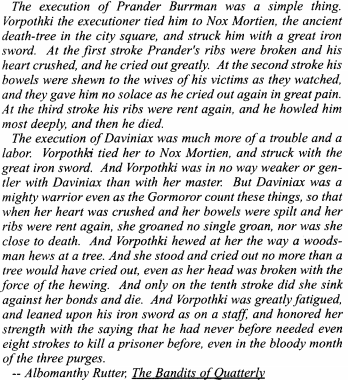
This section probably should have been back in the setting information section of the book. It doesn't really have any mechanical rules, but it does describe what life points actually mean in setting. I've belabored the point that Life Points are a real in-setting thing, this is what I've been talking about.
Any creature stays alive for as long as the spirit can hang on to the body and mind. Bigger things generally have a stronger grip on the spirit than smaller things, and the more damaged the body gets the harder it is for the spirit to hold on. If the spirit can't hold on to the body anymore, that's when death occurs.
Practice helps, like most skills. The more practice a spirit gets holding on to the body under strain, the better it gets at it. That's why experienced warriors who have been wounded often have more life points, they've had more practice at not dying. Similarly, regularly-flogged prisoners or patients who have repeatedly undergone surgery get better at not dying. What does not kill you actually does make you stronger, or at least more resilient. Sometimes nobles will even pay to endure floggings so they have enough life points to survive an assassination attempt.
There's very few kinds of injury that are categorically fatal. If you cut off someone's head, that's probably going to do enough damage to kill them, but if they're particularly tough then their spirit might keep on clinging to the body and keep using the head to cast spells, at least until suffocation and blood loss finally do enough damage to be fatal. Stab someone through the heart, and their spirit will keep the muscle pumping and the blood flowing for at least a few moments. The only instantaneously fatal injuries are one that destroy the brain (the connection between mind and body), or destroy the entire body (the connection between spirit and body), or some metaphysical wound that severs the connection between spirit and mind.
Death and Resurrection
After suffering grievous injury, the spirit loses its grasp on the body and floats away. A dead body does normal dead body things, like slowly rotting. Without the spirit, the mind flops around like an intangible jellyfish for a while, completely helpless without a spirit to give it a will. After a few months, the dead mind withers away to nothing.
The spirit fares best after death. Without a mind, the spirit has will and desire, but no knowledge or intellect. It instinctively hangs around the body, hoping to be reattached to the body and mind. After a few minutes of trying and failing to come back to life out of sheer determination, the spirit eventually gives up and wanders off, drawn naturally back to its creator god. It hangs around in that god's version of an afterlife to rest for a while, and then eventually the god will recycle the spirit into a new person. World Tree afterlives are tranquil, bordering on dull. People have scryed on Accanax's afterlife, and it's just big empty space with a bunch of spirits napping in it, and the others' probably aren't much more eventful.
Reincarnation doesn't matter much to most people. Some people have had past lives, most are fresh spirits, and only a powerful wizard could tell the difference, let alone do anything with the knowledge. Spirits generally don't retain any memories of past lives; those were lost with the mind. A reincarnated spirit does get to keep any god-granted knacks it picked up along the way into the next life, though.
If someone's dead and you want them to not be dead anymore, first you have to heal the body. Healing magic works on a dead body the same as on a living one, but just fixing the wounds doesn't restore life. If you perform the healing fast enough, within a second or two, the spirit will be able to grab back on to the body; bound magic is best for this. Before the spirit goes back to its creator god, it can be put back into a healed body with difficult but still reasonable magic. Once the spirit has gone to the afterlife, it takes powerful magic to drag it out of the pocket dimension, metaphorically slap it awake, remind it what a body is, and shove it back into place, and hopefully you didn't accidentally grab the spirit of a nearby mushroom that died or something. If the spirit has already been reincarnated, then you have to a) identify the spirit's new body, b) kill the new body, c) grab the spirit and stuff it into the old body which you've somehow kept preserved all this time. Someone actually did this, once, 800 years ago, and it wasn't worth it.
In theory, it should be possible to use Mentador and Spiridor magic to attach the mind to the spirit to go with it when it dies, and keep memories intact through reincarnation, but for some reason there's no record of this ever working successfully. OTOH there have been a few infants born with wizard-level magical powers and an infant's level of common sense and rationality; none of them survive to become toddlers.
Birth, Aging, and Death
One the other end of the life cycle, spirits are generally attached to a baby when the fetus is formed enough for the spirit to hold on to. For most species, this is about a month before birth or hatching, but Sleeth don't get their spirit until the moment they're born; possibly to keep them from scratching and clawing too much while in the womb. Spirits are delivered by the creator god personally, but they're very busy and don't stick around long enough to be perceived by anyone in the room.
Over the next few years, the child grows and learns, periodically visited by each of the 7+12 gods in turn to be given their magical connection to the Arts. By age 5 or 6, children are capable of casting spontaneous magic; the bright kids figure it out on their own, and every kid will pick it up from friends and family sooner or later. Child mortality is high, almost 15% by the age of ten, mostly due to magic gone awry. Recently, the mortality rate is dropping, at least among the wealthy classes, as parents are able to buy bound healing magic to keep their dumbass children alive.
All the Prime species grow up about as quickly as humans do, although their adolescence lasts a few years longer. They also have about the same natural lifespan as humans, about 100 World Tree years (about 70 Earth years) give or take a few decades. There's a few exceptions; Sleeth grow up a few years sooner and live about 10 fewer years than other Primes. Zi Ri (sigh) go through adolescence at about age 10 or 11 (4 or 5 Earth Years old), have an EXTREMELY eventful year-long puberty, and then stop aging entirely.
Disease
Disease is almost entirely a non-factor for the Primes. Maybe the gods didn't feel like they were worth creating. There are only four contagious diseases, one each for Orren, Rassimel, Herethroy, and Cani. Infected victims will get increasingly sleepy for a week, then fall into a coma and painlessly waste away over two weeks. While fatal if untreated, the diseases are easily cured by a well known and reasonably straightforward spell. If you have any access to healthcare, you won't die of disease.
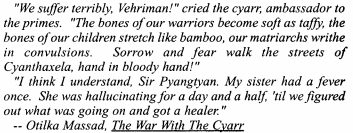
Non-primes aren't so lucky. Gnarn and Accanax left the primes alone, but they made an epidemiologist's nightmare array of diseases for everyone else, each more deadly and painful than the last. Non primes often come to the gates of prime cities, begging for medical aid when a plague rips through their villages.
The equivalent of the cold or flu is caused by random flecks of Corpador magic floating around. If one sticks to you, it makes you sick until your body's natural magic resistance shakes it off. The effects can range from sniffles, to nausea, to fur loss, to growing giant pink claws, or to an endless parade of ants pouring out of your ears. Since these are random magical effects, they're tricky, but not impossible, to cure.
Natural Life and Death
Most species, other than Khtsoyis, naturally heal over time, recovering up to d3 life points every day. Medical care makes this more reliable. Most people will use magic to speed this up. Heal Once recovers a respectable amount of health once per day per patient, and Healing Sleep recovers somewhat more health overnight, and also stacks with Heal Once.
Injuries that cause Trouble, such as broken bones or pierced eyes, heal much more slowly than flesh wounds. Properly set, a broken bone heals at a rate of 1 point of Trouble per month. Some injuries, like gouged eyes, will never naturally heal on their own. Magical spells to cure an injury usually have to be cast within a few days to work, otherwise you have to rely on much more complicated magic to fix an old injury.
Starting around age 50, people (other than Zi Ri) start feeling the effects of age. Starting at age 50 and every d10 years afterward, you roll a d20 and look up on a chart to see if you lose some attributes. Charisma is the most likely attribute to decrease, followed by the physical attributes, with the mental attributes least likely to decrease. There's also a 1/20 chance of a mental skill increasing instead. Fighting the effects of aging is possible, but hard. For example, the spell Preserve the Keenness of the Aging Nose (Sustenoc Corpador Complexity-25) will, if cast every single day over the d10 year period, will negate any chance of losing Perception. There's similar spells for the other attributes. A complexity 40 spell negates all aging rolls, but again must be cast every single morning. Spells that can be cast on other people, instead of just on the caster, are even more complex. Aging by itself isn't directly fatal, no matter how decrepit you get.
Natural death occurs when the spirit simply gets tired of being alive. Somewhere around the end of your natural lifespan, the gamemaster will roll to see when and how you're going to bite it. Some of the natural causes of death give you enough warning to do something about it, some do not.
Your spirit might simply yearn to rejoin its creator. You get anywhere from a few weeks to about a year of feeling that it's time, enough to get your affairs in order, and then you die, either peacefully in your sleep or by suicide. There's not a lot you can do about it, since your spirit, your motivating will, really DOES want to move on.
You might start suffering organ failure. Important parts of your body start shutting down. Healing magic and medicine can help keep you alive, but they're very difficult; the spells are around complexity 40 and requires a different spell for each organ that craps out. Medicine and magic can slow down the time between attacks, and increase how many attacks you suffer before the big one finally kills you.
You might start just wasting away, losing d4 levels from your Life Base every year until you hit 0 and die. The magic to keep this from happening starts difficult and gets harder every year.
You might just fall over dead. About half the time you get some kind of a spooky omen a few days in advance, but otherwise you'll just be walking along and *thunk*
Your body and mind might start collapsing. You lose 1 point from a random attribute every d6 days. When one of them hits -13, you die. There's a set of 10 spells, ranging from complexity 30 to 70, that if cast every morning and evening protect each of the 10 attributes. A sufficiently powerful sorcerer can last indefinitely on this regimen.
You might descend into senility and madness. Your mind starts to go; people find you acting a little odd for d10 years, then very odd for d10 years, then utterly mad after that. This doesn't kill you directly, but you'll almost certainly suffer some mishap before long unless you're kept well protected.
If you don't want to get old or die, there's things you can do about it. There's no particular taboo against immortality, and the gods don't forbid or discourage seeking it. It's just really hard. You can add a few years to your lifespan with a Sustenoc Corpador complexity-25 spell, but repeated castings don't stack. A powerful enchanter can make a talisman that stops aging while worn; taking the talisman off for even an instant can be fatal. Magic that increases your lifespan doesn't help with aging, though, so you'll need more magic to deal with that.
Or just be a Zi Ri.
That wraps up combat and combat-adjacent stuff. Next up, finally, is the chapter on Magic, and wow that's going to be a lot to cover.